Archive of the Mendocino Heritage Artists
Dorr Bothwell: Straws in the Wind: An Artist’s Life as told to Bruce Levene
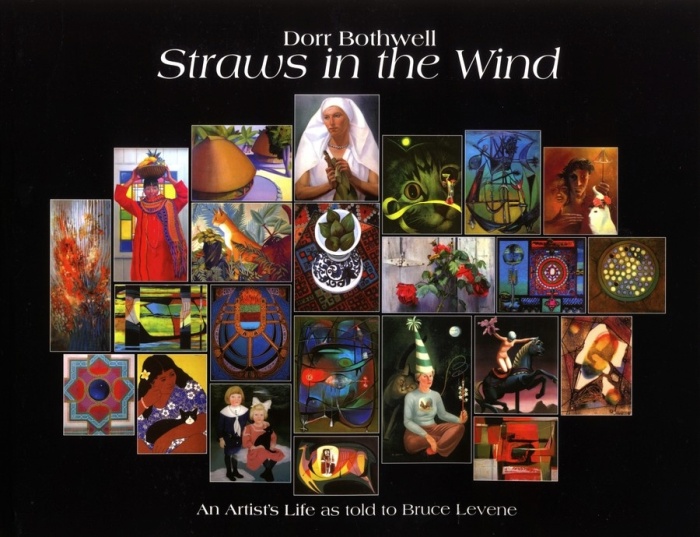
NOTE re. Dorr Bothwell: Straws in the Wind: An Artist’s Life as told to Bruce Levene: While oral historian Bruce Levene shaped the story, first by asking questions, then by editing the interviews to form a narrative, the book is not ghost-written, and not a retelling. All the words are Dorr Bothwell’s. Carol Goodwin Blick, Archivist, The Mendocino Heritage Artists
RETAIL: Order a copy of the print edition of Dorr Bothwell: Straws in the Wind: An Artist’s Life as told to Bruce Levene from Mendocino Art Center or Gallery Bookshop (US$24.95, plus tax & shipping). ISBN: 978-0-933391-19-2 / Library of Congress Card number: 00-110686 / softcover, perfect binding, 8.5″ x 11″ / 132 pages / originally published posthumously in 2013 by Pacific Transcriptions, Mendocino, California, republished in 2018 by Christie Olson Day, Mendocino, California.
RESALE: Order copies of the print edition for resale from Christie Olson Day, Gallery Bookshop, PO Box 270, Mendocino, CA 95460. Phone: (707) 937-2215 ext 11. Email: Info@gallerybookshop.com
DIGITAL EDITION: The following is the 2019 authorized digital edition of the 2013 print edition of Dorr Bothwell: Straws in the Wind: An Artist’s Life as told to Bruce Levene. Commercial publication rights belong to Christie Olson Day exclusively. This digital text is available courtesy of Bruce Levene. It is available only for non-commercial use, and only with the attribution: Courtesy of Bruce Levene. If there are questions about appropriate use, please contact the archivist for the Mendocino Heritage Artists. Thank you.
CONTENTS
Introduction
My Family and Childhood
I Begin My Career in Art
My Samoan Adventure
Europe
How I Spent the Depression
The War Years and The California School of Fine Arts
The Paths to Mendocino & Notan
And I Never Stopped Traveling
To Theorize or Not
Tributes
Sources and Dealers
Credits
About Bruce Levene
INTRODUCTION
This book was compiled from recorded interviews with an American woman artist whose life spanned almost the entire 20th century. It is an oral history edited from her own words into a narrative autobiography. In addition, more than 200 graphics illustrate the entire range of the artist’s life.
For more than 70 years Dorr Bothwell worked as a fine artist and her life can be summed up by Willem de Kooning’s declaration, “I don’t paint to live. I live to paint.” But her life, though inseparable from her art, was so rich and so inspirational—particularly for modern women—that this captivating story should be shared.
From a transcendent moment in 1906 when she was four years old, until 1997, when her eyes no longer allowed her to paint, Dorr Bothwell never deviated for one moment from her life-long artistic quest. As a woman and a Californian, she faced prejudices and obstacles—and at times hardships—that would have impeded most people. Not Dorr. She continued painting, traveling, teaching and examining new-found paths of her own creation.
Her art explores and describes the patterns of her life—hundreds of paintings, in her own diverse styles, which never stopped evolving, from oil to serigraphy to collage with color laser copiers—and much more in between.
“I really and truly want people to appreciate what’s around them. What I put down, both in color and in line—no matter in what form—I want people to look at it, because it gives them some idea of what is in the world.” Her travels—to the South Seas, to Europe, to Asia—were constant themes and those experiences were usually reflected in her art, sometimes decades later.
For more than 40 years she taught art, usually variations on Color and Design, and more than 50 times her own creative course “Notan: The Dark-Light Principle of Design.” She modestly claimed to have brought the art world along and believed she could teach anyone to draw. Her students never forgot her enthusiasm while showing them how to see the beauty and design underlying light and color.
She was unconcerned about her place in art history—as long as the public and a myriad of collectors purchased and enjoyed her works, that was enough.
Dorr Bothwell died in 2000 at age 98. A memorial, attended by many friends, was held on the Mendocino Headlands. As she requested, her ashes were sown into the Pacific Ocean, along the California Coast which had nurtured her for almost a century.
An observer might have recalled the old Gaelic blessing of the artist’s Scottish forebears: May the road rise up to meet you. May the wind be always at your back. May the sun shine warm upon your face. May the rains fall soft upon your fields and may God hold you in the hollow of His hand.
Dorr Bothwell was the invincible spirit of American Modernism, the epitome of artistic creativity during the 20th Century.
— Bruce Levene, Mendocino (2013)
MY FAMILY AND CHILDHOOD
In 1790 a ship sailed from Scotland filled with ghillies (workmen) of the Clan McNab, together with some non-clansmen. The men were heading for a wilderness in northern Ontario filled with wild animals and Indians. They represented all different trades except baker and blacksmith. To resolve this crucial problem they drew lots and the young man who drew the shortest straw became the blacksmith. He was William Bothwell.
He had been listed as a teacher, but as there were no women or children, he accepted the job of blacksmith and never did teach. He spent the rest of his life pounding an anvil and became a famous wheelwright in northern Ontario.
William Bothwell married and fathered 13 children. The youngest child was James Bothwell. James married and had four children—two girls and two boys. The youngest boy was my father, John Stuart.
They lived far up north. When John Stuart Bothwell was growing up the nearest neighbor, 40 miles away, was the Hudson Bay Company trading post. In time farmers came in and finally a school was built within walking distance, about five miles away.
My father, like William Bothwell before him, had a great yen to see the world. When he came of age and finished his education, he left Canada, because there was little opportunity at home, and went to the United States, where he heard there was work. He got a job in New York trying to collect bills that nobody else could collect but that didn’t last very long.
Eventually, when he was in his early ‘30s, my father got another job that took him to Chicago. After arriving there he needed a place to stay. In those days, without radio or any kind of easy communication, there were local ethnic newspapers, generally two or four sheets. Father bought a copy of the one for Canadian and British people, a weekly newspaper called Canadian American. The newspaper told about people who had arrived from Canada or from England and similar stories, but it also had advertisements for places to stay.
My father was older than most of my friends’ fathers because he married late. He was the first Bothwell ever to marry someone who wasn’t 100 percent Scottish. My mother, who was English and Welsh, would have been considered a foreigner by the Bothwells. Her maiden name was Hodgson, my middle name.
My maternal grandmother, Emma Elizabeth Hollingsworth, was the youngest of a fairly large well-to-do family and took after the Welsh side of the family. She was tiny, about four feet eleven, with black hair and dark brown eyes. She lived in London.
My maternal grandfather, James Terhume Hodgson, came from a wealthy Lancastershire business family and had started out as a successful young businessman himself. His parents had a huge manufacturing plant in Rotherham, on the River Rother, and he was all set to marry the daughter of a similar manufacturer. The marriage was planned but the banns had not been posted.
How my grandparents met I never heard, and I don’t think even my mother knew, but what happened was that Grandma and Grandpa fell in love and eloped.
The reaction by their families was immediate. James Terhume was disinherited, with a “never darken our doors again” attitude. I don’t believe he ever went home again. He was probably disinherited by mail.
And Grandma was disinherited also, because her parents felt she had married beneath her station. This was very serious in those middle Victorian times, 1859 or 1860—a sense of propriety! The idea of Grandma running away with somebody ‘in trade’—as business was called then—was enough to disinherit her. My grandmother’s family sent out black-bordered letters saying that their daughter had disgraced the family, or words to that effect and that she should no longer be considered part of it. And they almost—I don’t think they ever said it—let it be known that she was no longer alive.
I’m not sure if they even let her in the house again, even to get her clothes. I think somebody packed everything up and put the trunk on the front porch. So overnight both of them were, so to speak, without any family at all.
In Grandma’s case, she never mentioned her family. I don’t know if she had siblings, except for one sister, whom she referred to as “your great-aunt Alice.” When my grandmother was pregnant with her first child and they were still in England, her eldest sister Alice sneaked away and visited her. It may seem pitiful now, but at the time that was a great concession on the part of my great-aunt. This was the first news that Grandma had heard of her family but she never saw any other family members again. As far as I know, no one in my grandfather’s family ever spoke to him again nor did he receive one cent from them, either.
So how did they live? It was as if they were tourists in England. There was no place to go; nobody welcomed them; they were without any property, with little more than the clothes on their backs and what little money my grandfather had. But Grandpa was very smart. He became an entrepreneur and began to buy up the patents for what he felt would be successful inventions. And they were. He traveled continually, buying up things and going to outlandish places. He had a shrewd eye.
My grandparents spent the rest of their lives traveling. After a year or so in England they went to Sweden.
Grandma, trying to keep track of her children, had the habit of giving the child a name characteristic of the place where he or she was conceived. The first child, Uncle Harold, had been conceived in England, naturally. The second child was Auntie Hilda, conceived in Sweden, then Aunt Maria Teresa in Austria. Then there seems to be a gap.
Grandma kept having children, but they continued to die. In those early days their travels meant difficulties, like proper food, and I guess that changing from one hotel to another was lethal. All the children died except four.
Grandpa bought up wonderful inventions. He bought the patent to a meat slicing machine, which he sold in England and Scandanavia. He bought some kind of spinning thing, took it to India and made a killing! He was a sharp business man. He was in Greece and India, then South America.
Grandma faithfully had a baby almost every year. After 15 years, in 1875, my mother, the youngest of the 11 children, was born. You can guess where she was conceived, because she was named Florence Isabel—Grandma must have been unsure whether she was conceived in Italy or in Spain.
Grandpa eventually cornered the market on whalebone. Hoop skirts were in fashion and he was doing very well. But he over-reached himself when he decided to sell patents in America. Moving to the United States, the family went from—I don’t suppose it was in the millions, but close to it—to absolute rags. Just about that time hoop skirts went out of fashion. On top of that he had just purchased one of the first lace-making machines in Switzerland and brought it to the United States; but no one was interested in the machine and he had trouble selling it. Only hand-made lace was fashionable and machine made lace was considered déclassé.
The family, consisting now of my mother and, I believe, one or two aunts, got stranded in Chicago. Grandpa and Grandma bought this big mansion in a little suburb called River Forest but they were broke. My grandmother didn’t waste time. Although she had grown up in luxury, she took charge, opened the house up to take in boarders, and listed her boarding house in the Canadian American.
My father read the advertisement, stating that an English family offered room and board in River Forest and out he goes. My mother answered the front door and they fell instantly in love—something that seemed to run in my mother’s family.
My mother was a very forward-looking person. She went through high school during the 1890s and was so smart that she finished when she was 17. The year before she graduated the 1893 Columbian Exhibition took place in Chicago, where she saw all the new inventions. They so excited her that she decided to become a business woman. She turned down the university idea, because they didn’t teach business, and went to a business school. She loved the idea of planning things and even memorized Robert’s Rules of Order. She had a brain!
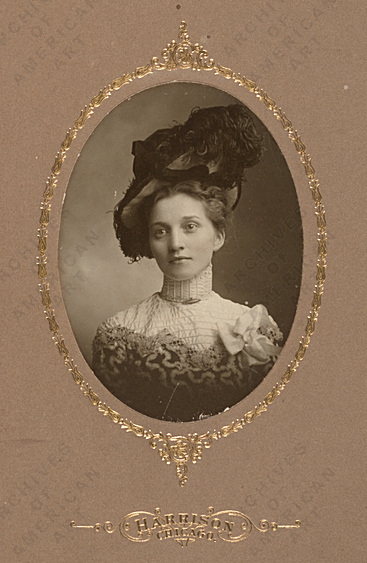
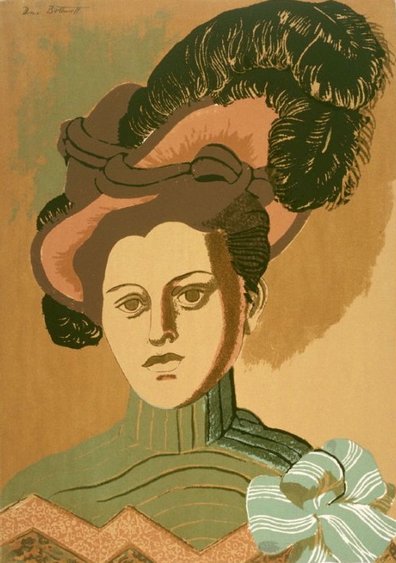
Mother was a perfect Gibson Girl, with starched shirtwaist, her hair done up on top of her head in a pompadour. She worked in an office, for peanuts, because women were really put down then. But because she could type and take dictation she got the job.
Grandma made sure, however, that my mother had all the niceties of a Victorian lady. Well brought up young ladies played the piano and did watercolors. So on Saturdays my mother took private lessons in watercolor painting. She was very lucky, because she had a teacher with real talent.
My mother was very happy with her life. She had become an American citizen when she turned 18, having been in the United States long enough to get her citizenship papers (she lost her American citizenship when she married my father, a startling example of the status of women at the turn of the century). She was the only American in this English family and very proud of it.
Father lived in the boarding house for about six years. Eventually he and Mother became engaged and it looked like they would follow the usual pattern—they’d get married and probably go to Toronto, because generally the husband took the bride home with him.
About this time the machines that made lace began to sell, so my grandparents had some money. Grandpa had also applied for an American patent for the Swiss meat-slicing machine and he managed to recoup part of his fortune before the designs were copied.
But they were still taking in boarders. Then comes the wonderful story of how my parents got to California, which is hard to believe and sounds like something out of a novel, but is true, because fate, waiting in the wings, had something in store for them—my Uncle Harold!
Uncle Harold, my grandparent’s first child, survived because he was not dragged around traveling. In fact, the first three children were probably healthy because they were put in boarding schools. It must have been lonely growing up with your parents away all the time and perhaps that’s what put a kink in Uncle Harold’s mind. He had a very elegant education. He didn’t go to Eton; he went to a lesser boys’ school—either because they didn’t have the money for Eton or because he started out there and couldn’t finish up. He was a Victorian gentleman, but in spite of education and upbringing, he became a professional gambler.
He went anywhere there were good casinos or good horse racing. He particularly liked to watch little Mongolian ponies race and had traveled to China, perhaps even to Japan, and any place in between where there was racing. He just traveled continually all over the world. So he was not really an active member of the family.
My brother and I knew there was something bad about Uncle Harold because we’d never seen him. We were never allowed to say, “I bet you.” We couldn’t play any kind of betting game, even with matches, because this horrible taint might come out in later years.
Just after my parents became engaged, Grandma received a cable from Harold, who was in Cannes, France. He’d been gambling in the casino with a California rancher. Harold had won the rancher’s yacht and all his money. The man wouldn’t give up and he slapped down on the table a deed to his ranch in Rumsey, California. Harold won the ranch, too.
But Harold was heady. He kept gambling and lost everything, except the yacht and the deed to the ranch. He sailed as far as Marseilles on the yacht, but the auxiliary engines ran out of petrol plus he couldn’t pay the crews’ salaries. So he gambled with a ship chandler (a maritime supplier) and lost the yacht and his money. Harold was flat broke in Marseilles but he had the deed to the land. He cabled my grandmother for money, telling her that he had security for a loan.
My grandfather was so disappointed with his only son that he wanted nothing to do with him. So it was my father who counseled my grandmother in this crisis. My parents weren’t married yet, but naturally Father had a great interest. He told my grandmother, “Your fortune is just dwindling away. You should not just give him sums of money all the time without some security. Cable him and ask what security he has—he’s told you this before.” So she sent Harold a cable.
Back came a four word cable: “Have deed California ranch.” Apparently Harold had enough money for cables, which were expensive. Grandma cabled him the money.
Eventually the deed to the Rumsey ranch in California arrived. My parents had decided to be married in June, 1900. Mother was 25 years old. I think Father was 36. The wedding date was rapidly approaching and Grandma saw an opportunity. She said, “Take this deed, when you get married, and go out to California, and see what this ranch consists of. If it’s a profitable thing, keep it. If it isn’t, try to sell it.” Mother got rid of her fur coats and her heavy clothes and came out in a little white lawn wedding dress.
They were married, and with the deed in their hands got on the train—it’s a long train trip—and started out for California.
The only thing of note about the train trip going West was that their seat mate was the famous metaphysical sage and spiritual teacher Vivekananda. My father had an inquiring mind and was hungry for this kind of wisdom. He loved history. It meant a great deal to him and I think he was able to understand many things beyond his time. I realize, looking back, that he was way ahead of his time in how he looked at what was happening to the world. I really think that his meeting with Swami Vivekananda could have contributed to that.
Finally the train trip ended and my parents took the ferry across San Francisco Bay to San Francisco. Mother, being a city girl, was entranced with The City. They spent a few days recovering from the train trip. Mother didn’t want to leave but my father said, “We have to go and see this ranch.” This meant another train and a long horse and buggy ride out to the ranch in Rumsey, California.
I once checked all of this out. I found the various deeds, how Harold first had the ranch, how it was then deeded to my grandmother. It was all true.
It was a wonderful ranch with peach orchards and numerous buildings. There were horses, and chickens, which my father particularly liked. Anything that multiplies, I think, especially by themselves, interests people who like mathematics, which was my father’s field; so he loved it.
They spent an idyllic year there. Imagine a honeymoon on a beautiful ranch, with fruit trees and flowers. Beginning the second year Mother was pregnant, with me. But she was not—I guess from the experience her own mother had of having so many babies die here and there—about to be out in the middle of an orchard when her baby was born. Mother was a city girl and wouldn’t stay on the ranch, so my parents sold it. Mother got her way and they went back to San Francisco.
Dad never saw his parents again, because Mother wouldn’t travel and he wouldn’t leave her.
In those days travel was quite difficult. Even when I took the train to New York 50 years later it took 4 days and 3 nights on the train. People today don’t realize how hard it was. And going up to Canada you had to take the train from Chicago and go over to Windsor. The trip would not have been easy, so my father never went to visit his family. His father had been killed when he was a young man. I remember, very vaguely, when I was quite small, that Father would get letters from his mother—then they stopped coming.
We also moved a good deal. Dad didn’t want to buy property here. He was not an American citizen and had no intention of becoming one. He inherited property in Scotland and could have gone back there and fit right in. But Mother wouldn’t budge. So he let that property go to the next inheritor. He chose not to go back to Canada either, although he would have had some advantages there.
Most likely he didn’t want to return to Canada because we had no relatives left there, to speak of. Of my great-greatgrandfathers’ 13 children, 2 girls married but had no children. Only four of the men married and they all had sons, who were our first cousins once removed—but were also the proper age to join the Canadian Army during World War I in 1914.
The Bothwells in Ontario were all settlers who had been in Canada for generations; naturally they kept close together and were like one big family. But all the boys—cousins and everyone else—joined the Princess Pat regiment, which suffered frightful casualties in the War and wiped out a tremendous number of Canadian families—it just cleared the settlers out.
So we rented houses. We were always renters. Wherever we rented, Dad gardened and the place just looked wonderful and was always painted and kept up. He was a great organizer.
I often think what might have happened, because I could have been born either in Canada or in Scotland. I wouldn’t have been an American. But both my brother and I were born in San Francisco and became Californians. Mother loved the place and never wanted to leave.
I was born May 3, 1902, on Post Street, between Scott and Divisidero, in one of those buildings with an immense, steep staircase. My parents had a flat on the second floor and in those days you were born at home. When I was three, we moved across the Bay to Alameda—1911 Pacific Avenue.
In April, 1906, the San Francisco earthquake occurred. I was not quite four and my brother was three. It happened early in the morning. I remember standing in my crib, yelling “Wheee,” because it had castors and was going back and forth, rolling from one side of the room to the other.
My father had the presence of mind to turn the gas off. We had gaslights in that part of Alameda. Not everybody had electricity. The dawn was coming up so it wasn’t too dark. My father had Mother stand with her back against the door-frame. She held my brother Stuart in her arms. Dad tried to put his hands on each side of the door frame. The house first started shaking one way, then it got a big swing going, then it went “pom, pom, pom” in the opposite direction. My father fell down on the floor. Since he was a teetotaler, I had never seen him down on the floor and that was a startling image that has stayed with me.
Then there were two tremendous crashes! First the bricks fell on our roof from the chimney. Then this huge Welsh dresser, filled with the family porcelain service, walked out from the wall and fell flat, destroying absolutely everything except one tiny covered ramekin. This was pretty white porcelain with a deep turquoise blue band, and a gold band around that with Grandma’s entwined monogram.
There were all kinds of noises. Part of our chimney jumped across the little gap between the houses and fell on our next door neighbor’s house. And the chimney of our neighbor on the other side fell onto our house.
My memory of the following day is one of great confusion, with strange people in our house, strange children, and everything mixed up. My father was deputized to go into his office building in the closed-off section of the business district across the Bay in San Francisco. It was necessary for him to get something out of his company office to take to the bank for storage, in case they had to dynamite the building to halt the fire. Mother begged him to take me with him, because she had her hands full with my brother plus a couple of children whose mothers had been injured. She simply couldn’t cope and I would be a nuisance to her otherwise.
So my father took me with him. There was no transportation and we walked up from the Ferry Building. I remember standing for what seemed like hours, down in the ground floor of the building, while my father climbed the stairs. No elevators worked. Then we went to the Hibernia Bank, which was crowded with people depositing their money, because that building was the safest place. My father went in to the bank, but he didn’t want me to get pushed around by that mass of people, so he left me standing there all by myself.
Two blocks down from the Hibernia Bank was the Treasury Building, which had been shaken flat down and burned. A ring of uniformed men sitting on horses, who must have been soldiers, surrounded this place where nothing but a plume of smoke came up. Later my father explained that they were guarding the safe, which was too hot to open, to prevent looting.
As time went on I got thirstier and thirstier. I was crying by then—you know how children are. Dad tried to find a place for me to get a drink of water and had to carry me once in awhile. We finally wound up in Chinatown, at Portsmouth Square, where a Salvation Army lassie, complete with bonnet, had built a bonfire in the gutter of the Sacramento Street side. She had an enormous gray granite coffeepot, as big as I was, on the fire. My father asked her if she had any water but she said that all the water was contaminated. But if he’d wait awhile, she would give him a cup as soon as the water boiled but before it got too strong. That was my first drink of coffee, which tasted terrible, but at least it quenched my thirst.
The thing I remember most was a steady moaning sound. Years later I asked my father if he remembered it and he said, “Yes, that was the wailing of all the Chinese people.” Because the Chinese weren’t allowed to move out of Chinatown, they had tunneled down three or four floors below ground. The earthquake caused the buildings above to collapse and many people were buried alive. There had also been many other injuries. Women and children were sitting crying on blankets in little Portsmouth Square or were huddled in front of the Hall of Justice on Kearney Street.
Something else I remember was that people, mostly men, looked straight ahead, in a kind of a blank stare, and that my father had to continually jerk me from side to side, out of their way. I was used to people giving way and not stepping on a child, but these people didn’t see anything. They were in what we would now call complete shock, just wandering along the street.
That same year, when I was four, I had an extraordinary experience. I remember my part of it clearly and my folks remembered the other part. I had been very naughty. And I knew it, knew that I deserved the spanking I got, and also that I deserved to go to bed without my supper. Heaven only knows what I had done. The memory I have is of wiping the tears off my face and being put to bed. I wasn’t too hungry—I didn’t care about that. I was really ashamed of myself.
My grandmother was staying with us then. Grandma was an early Quaker and she thee’d and thou’d us and taught us about praying. My father was brought up in the Scottish Calvinist religion, which he rebelled against completely, and renounced as soon as he could. So we were sent to Congregational Sunday School—they felt that was safe.
This is all by way of saying that we were brought up to talk to God. And God is not a man in a white shirt way up in the sky, but a point of light within you. It’s called a seed of light and you are joined to this God—you cannot escape. He sees everything you do. But, also, he is love and you can talk to him.
So I was praying to God, talking to him, telling him I really was sorry and I would like to have him please make me a good girl. I was lying on my back. Suddenly, from near the ceiling but at the foot of my bed, thousands of tiny, very small, colorful, bright lights began floating overhead, moving fairly rapidly. The lights were about the size of those glass-headed map pins that the teacher used to put in the map on the wall in school to mark a special place. Now I would say these lights were like seeing neon from a plane about 5,000 feet up in the air, but of course we’d never seen anything like that.
They were all colors: pink and blue and yellow and cerise— really beautiful. There were just clouds of them. I watched as they came up from the foot of the bed and floated over my head. I remember trying to watch them go over, because I turned my eyes back as far as they’d go to see where they went and the lights would go way back of my head.
Then a presence entered the room and it was neither light or dark—it was just a presence. It was at the foot of the bed; then it divided itself. Then it was on each side of the bed. Then one part of it went back of the bed, took me by the hair, and pulled me backwards. And that’s all I remember.
The family story is that when I came in the next morning I apologized to my father and my mother and to my grandma for being so naughty. Then I sat on my father’s lap and said, “Daddy, what’s a nartist?”
My father was a purist when it came to language, a stickler on pronunciation. So he said, “What you’re asking is, what is an artist?” I knew my cue was to repeat it correctly, so I said, “What is an artist?” Father said, “Well, an artist is someone who sings, or writes poetry or paints a picture”—and he pointed to the calendar, probably some hideous chromo—“like that landscape there. Or like your mother does watercolors.”
And I said, “Oh, well, that’s what I’m going to be. I’m going to paint pictures of everything.” And I climbed down from his lap and went over and sat in my chair, ready for breakfast. I said it very firmly, so they told me. That was it. And I never varied from it.
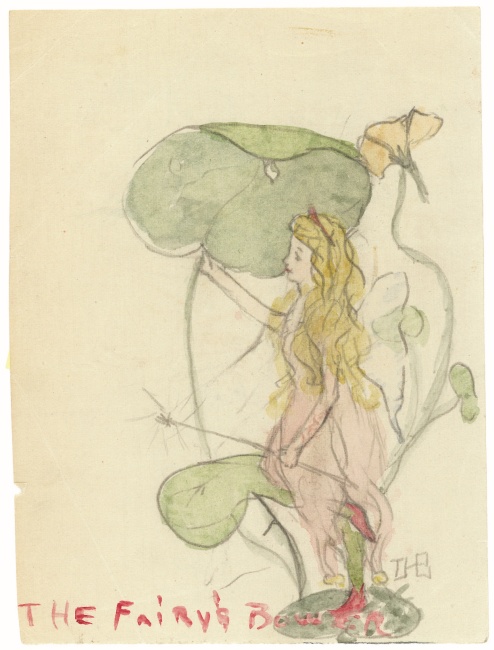
While he was still in Chicago, my father had been offered a post in Toronto, teaching mathematics, but Mother wouldn’t go. So when they got to San Francisco, he didn’t have a job, and only a little money from the sale of the ranch.
But he had a gift. He was a lightning calculator. It was something he couldn’t explain, because he didn’t know how he did it. He would look at the figures and kind of squint his eyes, then tell you what the total was. He had great patience, but could not understand why my brother and I held our fingers up when we tried to add.
Dad got a job with the Emporium, naturally in the accounting department. Then they found out he had this gift. Well, they paid people two ways, either by the hour or by the day, either in silver or gold. Paper money wasn’t used much then in the West.
The white collar people were paid in gold. Most of them had a little chamois bag with their names stenciled on it. They received this in a white envelope with their name on it, because naturally they were gentlemen, you see, white collar. Finally my father got to the place where he became a gentleman once again and had his little chamois bag with the gold coins. I just loved them. They had $50 and $20 coins. I still have a $2.50 gold coin with an Indian head on it.
Because of this gift, his lightning calculator mind, my father had the ability to handle big figures. So he finally went into the lumber business, with the McCormick Lumber Company, headquartered in San Francisco. He always was in the accounting department, or treasurer, anything that had to do with figures and money. Lumber is figured in the millions of board feet and they did not have adding machines then.
When Haley’s Comet came around this last time, I suddenly remembered its coming in 1910. The newspapers would give the mathematical degrees of tangent because they just didn’t have enough people to work on the calculations. While they were working, the comet was moving and the scientists were trying to do all their figures. They’d give out certain problems for anybody interested in math who could help solve them.
Now you’d do it on the computer, or before the computer, on the comptometer. They printed the whole thing in the newspaper and my father adored it! He’d get the newspaper and his pad of yellow paper and he did beautiful figures and he’d say, “Oh, wonderful! Just put this down . . .” He was gone. He’d do this whole thing and send them in.
Both my brother and I went to a private school first, in Alameda. The public schools were damaged during the earthquake and this small low building had been a private home. A lot of Canadians and the English had moved to Alameda. I think that’s why we did, too. My school was what the English called a Ladies’ School but they took both little boys and little girls. After the public school was repaired, my brother and I went there.
Down the street, on upper Pacific Avenue, there was a large house with a fence and I’m amazed that I can still see the design—we left Alameda when I was nine years old. It was the most beautiful cast iron fence, designed like ears of corn, with flat leaves going around it—a bar relief, actually. I just loved that fence.
At the end of our block was a small fire station. The fire engine used heated steam, which was different from the bigger hook and ladder engines. They had two dapple-gray horses, Clydesdales, with all that hair and huge feet. And those horses knew exactly what they should do. I don’t know how the firemen knew where the fire was, because telephones were just coming in and in 1906 few people had telephones; but I’m sure the Fire Department did. They would ring the bell, and slide down the poles. My brother and I would run as fast as our little fat legs could carry us and stand behind a wall to watch the horses and the engine.
In 1911 we moved to southern California. My father’s company opened a new branch in San Diego because of the need for lumber in the building boom in the Imperial Valley. The area had been an uninhabited desert, but the discovery of artesian wells meant irrigation ditches and development. Dad went down to head the San Diego branch.
Everything we owned was packed up and shipped down on a schooner owned by the lumber company. We took the train to Los Angeles and explored that city, which seemed to be nothing but one orange grove after another, with houses scattered in between. My father found a house for us. The furniture arrived in a few days.
My father wanted us brought up in the country and, in 1911, San Diego really was the country. It was small but very nice. The town had delusions of grandeur, with sidewalks and paved streets and completely vacant lots. Mexicans would come up with goat herds and pasture the goats in the canyons below Balboa Park.
We lived on Louisiana Street at University Avenue. There was nothing there. There were three houses on our part of the street. Now, of course, it is so built up you can’t even find it! There was a library at the end of the block. By walking about three blocks, you could hit El Cajon Boulevard.
San Diego was delightful. We weren’t used to living in, what seemed to us, a semi-tropical climate. Most of the surprises were pleasant, but not all. Our first encounter with a tarantula left even my father somewhat shaken, although he’d been accustomed to encountering wild creatures in northern Ontario. A little research reassured him that they were benign as far as human beings went.
Our new house was the type known as California bungalow. It had the usual blocky square, slightly tapered, wooden columns holding up the front porch roof, and something that seemed symptomatic of southern California living, a large chimney studded with cobblestones. Another attraction, especially from my father’s point of view, was that you could grow geraniums all year around. He immediately planted loads of red geraniums. Mother liked the idea that she could easily grow lettuce and other vegetables year round. She changed our diet radically.
University Avenue had a streetcar that we could take to Park Boulevard, then transfer. If it was rainy weather the streetcar took us right by the school just a few blocks away. My father estimated that we certainly could walk it. It seemed like a long walk to us as small children, but we soon managed to figure out short cuts. We generally found creatures to watch for—a toad that lived in what was possibly a box for a gas or electricity outlet. Loads of wild flowers. We would arrive at school a bit disheveled, but certainly relaxed.
My father wanted us to get a decent education. He considered American schools very poor. He had learned his Latin when he was 12, his Greek when he was 14. He couldn’t understand a grammar school without Latin.
I was nine years old when we got to San Diego and that put me in the upper third grade. My first teachers were Miss Greer, who was cute, with brown hair, parted in the middle, and big brown eyes, and Miss Hammock, who had kinky reddish-blonde hair, blue eyes, and was kind of plumpish, medium size.
Our school was unusual, because it was the experimental grammar school on the same campus as the State Normal Teachers College. Professors who taught and monitored the teachers also came into our classrooms. However, it was much more than that. The principal of the school, Gertrude Laws, was a modern educator who became quite well known in educational psychology. The faculty consisted of good professors in their own right.
They would demonstrate to student teachers how to present certain subjects. I vividly remember Professor Bliss, an English historian, telling us—we were just beginning to learn about Shakespeare, probably in the fourth grade—how English sounded in Shakespeare’s time, explaining how words changed, and how different words were pronounced.
There was Mr. Skilling who, when the First World War was imminent, showed us how to make little gardens. We had little plots of land and learned how to plant. He also told us about constructing houses.
We had a wonderful teacher, Miss Judson, who went to Germany during her summer vacation and brought back those large red-labeled single side Victor Records of Wagner’s Nibelungen Ring. Since it was a State school, they had a great big Victrola with the top coming down, curved, red mahogany, and little doors with brass knobs—you opened those up for the sound, then you wound it up. She didn’t play the whole piece of music, but she played enough and explained it to us. She was head of the music department for the teachers, but she also experimented to see if we could retain musical ideas. She would explain a motif, then sit down at the piano and play it. We’d listen to her play, then hear the motif played by the orchestra on a record. She demonstrated how the melody appeared and guided us through the music. When this motif was played we knew that certain characters were about to come on and sing. Oh, I just thought it was wonderful, because I had been brought up with music.
Miss Judson also had what really thrilled me—one of the earliest naturalist recordings of birds, the song of the nightingale. I had read fairytales and had wondered what a nightingale sounded like. It was a very moving experience as far as I was concerned.
We also had a number of Spanish speaking children, who had escaped with their families from the Mexican Revolution. Senora Rosalie gave a short class every day in which some of us learned Spanish and the Spanish students learned in English.
The outstanding thing was to be taken into the teachers’ assembly room to see something called a Bilocticon. You could open a book with an illustration, put it in this machine, and it would appear on the screen. It was used before overhead projectors. I’ll never forget this. They had a book on Italian frescoes with colored illustrations. In those days they were colored lithographs, but they were beautifully done. A teacher would project one on the wall and tell us all about it. It made a tremendous impression on me because I was so hungry for anything that had to do with art, and even though I didn’t understand what I was looking at, I was thrilled to see these wonderful images.
We also gave school plays, read the Aeneid and acted it out. We designed our own helmets and everything else when we were in the fourth grade and low fifth. It was wonderful! I had a choice, I could take cooking and sewing or Spanish and typewriting. My family split on that. The first semester I took cooking and sewing. They were glad to get rid of me when I took Spanish and typewriting the second semester. I’m still typing. I do touch-typing and you never forget it.
My grandmother would come to visit us every few years. Then, after she returned to her home in London, she would go over to Paris and buy us clothes. She had our measurements and allowed for our growth. Soon a trunk would come with all these wonderful hand-made clothes.
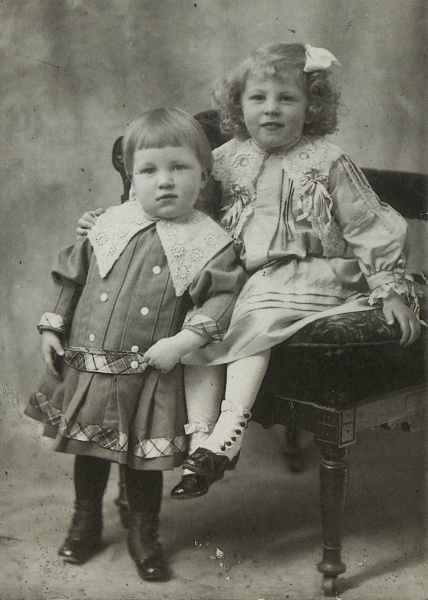
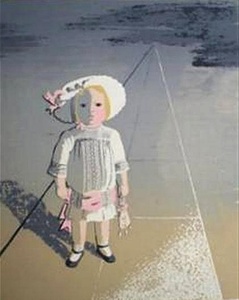
But not a single child in San Diego, California, was wearing things like we had. I didn’t care, but my brother would get so upset because he didn’t look like everybody else and would cry himself into a fever.
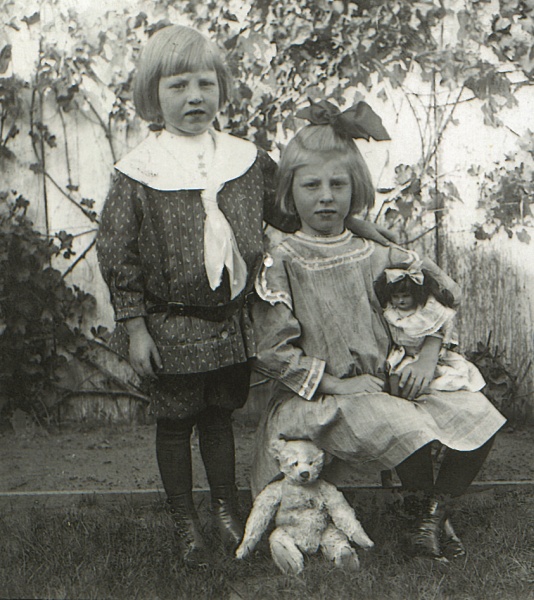
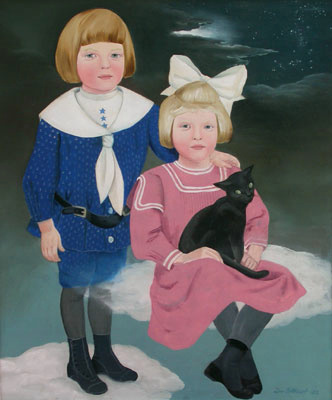
I remember he wanted a beanie, a hat that you turned up and cut the brim in little spikes around the edge. Then you put campaign buttons all around. I think he was about 10. All the little boys in his school were wearing them. My father just could not understand this—he didn’t have much sympathy. But finally they had to give in because Stuart cried himself sick. I mean that—he was in bed!
I didn’t care what the other kids said. I’d just fight them if they made fun of me. I’d kick them and throw them down and do all sorts of nasty things. I was probably the only child in San Diego, I’ll have you know, wearing a linen lawn pinafore with ruffles over the shoulder. It was all hand-made, hand-tucked with hand-made lace! I wore it over pure linen dresses that had box pleats front and back with a patent leather belt. Kind of like a Mary Jane type dress. When you sat down, it all crushed and I always had to keep my dress clean. Here was this little white pinafore on top of that. I had long hair and they’d pull it.
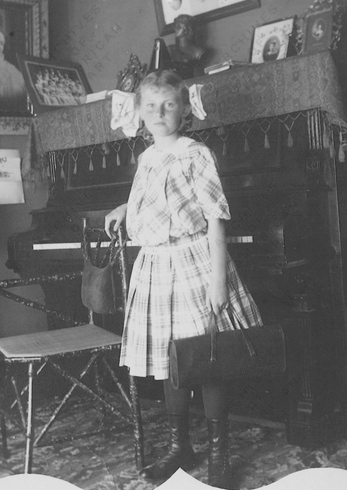
Grandma was very elegant and had an upper class accent. In spite of being disinherited, she had her education. She used to say, “I wish I had retained my accent.” But my brother and I were teased when we went to public school in San Diego because we both had English accents, with a little bit of influence from my father’s accent—not broad Scots, but with a slight burr on the tongue. The kids called me ‘limey.’ So, in desperation, we got rid of our accents.
My friend, Margaret Bennet, came from Indiana and my brother and I copied her accent—that’s why I’ve got a hard Indiana ‘r’. Oh, finishing schools would just have hired me out of hand if I’d had my grandmother’s accent.
Grandma’s manners were very Victorian. She kept her elbows in at her sides. We practiced sitting up straight. She really trained us.
It was very difficult in school, especially the early grades. Nobody knew what they were going to do. Margaret would bolster me up, although she didn’t know what she was going to do, either. We made paper dolls together and that sort of thing.
My mother took watercolor lessons and our house was filled with her framed watercolors. Not little twiddley things. Over the mantelpiece was this elegant bouquet of red roses, a nicely framed large watercolor at least 24 inches by 28 inches. She had other watercolors that her teacher had her copy, but some were Mother’s own interpretation, so I knew that such things existed.
But I still insisted on what I wanted to do. Mother let me play with her watercolors. What I really needed was guidance, even though Mother’s paintings were very important to me. But since painting was considered something few women were successful at, I was steered into music (a woman could be a successful accompanist to a virtuoso violinist and share in reflected glory) and the ballet (not quite as respectable but still not the theater!).
For some reason my father felt that being an artist was sort of an idle profession, so I was given every other chance not to be one. I studied music with a gentleman known as Professor Wrinkle, a German who had worked with a well-known Bach annotator. He gave me a good grounding in technique, although not so much in the music. And I was enrolled in a ballet class.
I must tell you a story about my dancing career. My ballet teacher in San Diego was a Mrs. Ratliff. During World War I, Anna Pavlova, the world-renowned Russian ballerina, came to California to recuperate from a big tour in South America and in Mexico City. Because of the war she couldn’t return to Europe, so she stayed for three months in Los Angeles and gave a few classes. Ballet teachers from all over, including my teacher, went to Los Angeles to study with her.
Then Pavlova decided she really needed a rest, so she went to San Diego, which was much quieter. Mrs. Ratliff persuaded Pavlova to come to our class one morning and just stand in the doorway of the classroom.
Mrs. Ratliff had a lot of little toddlers, plus medium sized kids who were good in acrobatics, and a handful of what we considered the adult class. I think we were 13 and 14. Most of us were still growing. I, however, was the same size I am now, five feet, two and a half, which made me one of the tall ones.
The little ones who were on the half toe were supposed to run forward, curtsy, then run off to the dressing room. The girls who were doing more acrobatic dancing were supposed to do a few cartwheels, curtsy, then run off to the dressing room. Finally, we so-called adults were to travel on our toes—on our points, as they say—make an elaborate curtsy, then run off.
I decided to let everybody else go first. Well, the three or four ahead of me did a beautiful job. They were lovely. And, of course, with my incredible ego, I decided that I would do this so perfectly that Anna Pavlova would recognize in me the future ballerina of the world.
I started off and I must say I did a very good job until all of a sudden I was traveling on my toes so fast that my left foot kicked my right foot out from under me and I fell flat, knocking myself completely windless. We had all taken falls and were trained how to get up gracefully. But I had never been trained to take a fall where I lay flat on the floor, without any breath. So I did the only thing I could think of—I rolled over on to my knees. I was so disappointed in myself that I didn’t even bother to do a curtsy—I just ran toward the dressing room on all fours, with my tutu, my skirt, over my head, my pink pants showing.
We didn’t wear long fancy hose or anything. We had bare legs. So here was the rear end sticking out in the pink pants, bare legs, running off to the dressing room. Just as I was about to get into the dressing room, I managed to see through my skirt what was happening. Anna Pavlova was hanging on the door jamb, laughing so hard she could hardly stand up, wiping her eyes. I also saw Mrs. Ratliff holding a handkerchief to her eyes, but she wasn’t smiling. That was the end of the future ballerina of the world! I never have grown. I stopped growing—I think it was from that experience.
Being born at the turn of the century meant before women’s suffrage, the eight hour day, etc. But more important than the outward signs of women’s unrest was the psychological atmosphere of that period.
When I was 12 I came across a book (which I think was by an English writer of the 1890s) which stated that women’s nervous systems were not equal to the strain of ‘mentation.’ That in fact women could never do any meaningful creative work as they didn’t have the capacity for sustained intellectual thought, or any spiritual depths sufficient to create a masterpiece; that the few women who did create works of art (Marie Vigée-Lebrun, Rosa Bonheur, George Sand) were really not true women, and anyway their work was definitely inferior.
This was a profound shock to me—for up to that time I had believed that I was as smart, if not smarter, than any of my boy playmates.
I asked my father if it was true, that women were definitely inferior to men and, bless his heart, he assured me that it was only an old-fashioned idea, that I could be anything or do anything I wanted, providing that one, I had some talent for it and two, I was willing to work single-mindedly enough.
I mention this only to give some idea of the conditioning that girls received as a matter of course: ‘Don’t Try, You Can’t Succeed,’ or the motto that was always quoted, ‘Be good, sweet maid, and let who will be clever.’ Wow!
My mother and father continued the English habit of taking Sunday afternoon walks and looking at other peoples’ gardens. They walked a few blocks above us to Georgia Street and saw this wonderful garden, full of trees completely unknown to them: loquats, kumquats, small bush guavas, and a profusion of flowers. They met the owners, who turned out to be artists.
Anna M. Valentien was a sculptor who had studied with Rodin in Paris. She had come back to America and worked in the Rookwood Pottery, modeling shapes and doing decorations for the pottery. She’d done beautiful large pieces of pottery, with nude figures that looked as if they were swimming in water. She used a matte glaze and shading from cool white down to sea green at the base.
Her husband, whom we always addressed as Mr. Valentien, was a painter and at the time was making a series of paintings of California wild flowers. I was allowed to walk up there and talk to Mrs. Valentien but not bother Mr. Valentien, though I did. Of course, the first time I met them, when I heard they were artists, I piped up and said, “That’s what I’m going to be. I’m going to be an artist.” So they were interested, I guess, because most children don’t say that. She was very kind. She showed me some of her work, some small sculptures she had done. It was just wonderful to know that they were artists and that we were friends with them. That meant a lot to me.
In 1915-1916 the Panama-California Exposition was held in San Diego, to celebrate the opening of the Panama Canal. It had a wonderful gallery that exhibited artists’ work from all over the world. I saw three Monets that I’ve never forgotten. One from the hayfield series. Two paintings were facades of churches—the kind that when you got too close, they simply fell away and became dabs of paint. But when you backed off, they suddenly strengthened and tightened and became facades of stone buildings bathed in sunlight. The same process happened with the haystack painting. People thought them very ‘advanced,’ although they had been painted circa 1894!
There were paintings by California artists and some from back East, but I don’t remember the names. I was 14 when I saw what you might call my first international painting. To see what was being done all over the world made a tremendous impression on me.
I was absolutely zapped by the decor Frances Elkins did for the Main Lounge in the Exposition building, exhibiting Women’s Work. She used yard strips of a gorgeous ultramarine blue and an equally brilliant yellow orange sewn lengthwise to make draperies of gigantic stripes. The sofas were upholstered with the same clear glowing blue, with orange footstools. The windows were large and high, so this was a dramatic expanse. The furniture, which I recognized as regular bureaus with drawers, had been silver leafed, then the silver leaf abraded a little to antique them. The other furniture was wicker, alternating either orange or deep blue cushions. Most people said that the clashing colors gave them a headache, so the following year the scheme was changed to something more lady-like.
The other exhibit that thrilled my 14-year-old heart was the facsimile casts of Mayan and Aztec sculpture and bas reliefs. The combination of stylized hair and muscles with factual reality always excited me.
So I was encouraged about art and I made a solemn vow that I would not bother with going to college or the university—I would go to an art school. I heard that there was an art school in San Francisco, so I determined that when I got out of grammar school and through high school, that’s where I would go.
After I entered high school two wonderful things happened. The first was that I found one friend who knew exactly what he was going to do. His name was Marcus Duffield and he wanted to be a journalist, either a foreign correspondent or editor of a big newspaper. And that’s what he did do, too. He became the foreign editor of the New York Herald Tribune.
We would get together and everybody else thought we were having this terrific affair. He’d borrow his father’s car and we’d go out and park some place and then we would talk. Neither one of us would listen to the other. We’d just sit there and talk, talk, talk—each of us saying what we were going to do, because nobody else would believe us. Once in a while we’d stop and he’d tell me why he was taking what courses in high school and what he hoped he’d be able to take in college. I would tell why I wasn’t going to go to college and why I wanted to go to art school.
The second wonderful thing was that the school authorities gave me permission to take a night class in clay modeling, given by our friend Mrs. Valentien. This was exciting because it was my first serious attempt to do something in the Fine Arts.
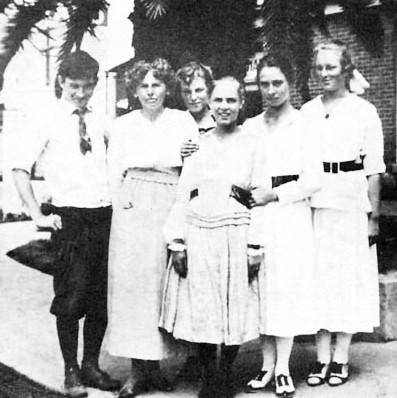
I wasn’t allowed to ‘take’ art. I majored in Math (my father’s field). This wasn’t any great loss, because all the art students did was make posters urging us to conserve sugar, have victory gardens and buy bonds.
The United States entered World War I in 1917.
Then in 1918, when I was 16, my father was transferred to St. Helens, Oregon, a tiny little place on the Columbia River, just 25 miles from Portland. They were building wooden ships to carry Canadian grain to Great Britain through the Panama Canal. Not only did my father work for the lumber company, he was also a representative of the Canadian government.
By the time we were packed up and ready to move, I had finished my first year of high school. When we finally got up to this little town, there was only one house available—because of the sudden entrance into the War everything had been snapped up. The mills were enlarged. There were shipbuilding docks. We were lucky to get this ancient wooden structure, made with hand-made nails that looked, but really wasn’t, slightly Victorian. It was a siding house with a porch that ran three sides of the house. We wondered at the time why it was available and soon found out when the porch fell off—it was that old.
In 1918 the influenza plague began but St. Helens was so small and isolated—it was mostly men in the mill— that we didn’t have to wear face-masks. And we were right in the town. In the cities they wore face-masks, so we really escaped. There were very few deaths in St. Helens from influenza.
We got there the last day of August and the next day the high school burned down. So for about a week the school didn’t start. Thus I began my sophomore year in high school in a huge improvised room above the town’s only bank, which I think was the Odd Fellows Hall. Think of all four grades of high school students crowded into one large room with an old potbellied stove in the corner. It was ridiculous. And the instruction was terrible. The English studies were pitiful. The math was pitiful. They didn’t have a chemistry class.
I realized that I was losing ground, that unless I went to a better school and learned more I wouldn’t get any kind of education at all—I’d never be able to pass examinations into college or university. So I rebelled.
I told them I was going to take whatever money I had and go back to San Diego, to finish my high school training there—that St. Helens was impossible.
My father understood the situation, of course. We had friends, Mr. and Mrs. Best, who owned an apartment house right near the high school in San Diego. They said that they’d watch over me. So Mother went back to San Diego with me and saw to the apartment. I enrolled again in the Russ High School, the old high school on the hill.
Also at this time I was getting more impatient to go to art school. I just couldn’t stand it. My father was adamant that if I went back to high school I had to get, as he put it, a classical education, that I could always learn to paint later—even though I had never been allowed to take any art courses. So that’s what I was getting. But I was getting very bored with it.
Again I talked to the principal. My grades were high. I took a number of tests and entered as a junior and with a number of senior subjects, for which I had to take examinations. Some of them I passed without ever having been a senior. I worked hard. I had to quit the clay modeling class and devote myself completely to studying to get through two years of high school in one. Which I did.
The scholastic year finally ended. I was through with high school. And if I hadn’t graduated cum laude, at least I received a diploma. Mother came down from Oregon to see me graduate and was a little upset when she found that I had told the school authorities that I would not appear on the platform— they could mail my diploma to my home address in Oregon. I broke that news to Mother, who expected to sit in the audience as a proud parent and watch her daughter receive her reward.
However, she was very game and used to changes of schedules. I said, “Help me pack my trunk, and help me find an apartment in San Francisco.” In those days you had trunks. We packed the trunk and called an expressman, who took the trunk onto his back, carried it down a flight of steps, then dumped it in the back of a truck. Then he drove off to the Southern Pacific station. The trunk was checked at the baggage department, on my ticket, and traveled on the train with me as we took this wonderful trip up to San Francisco.
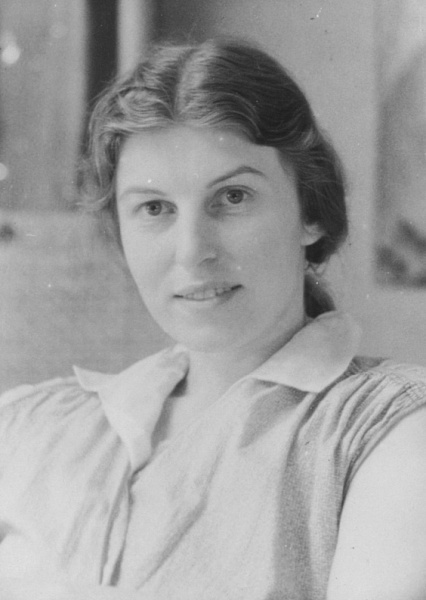
After we got off the train at Third and Townsend, Mother confessed that she’d scouted ahead before she’d come to San Diego and thought she’d found an apartment for me. We carried our Boston bags, which were the equivalent of the modern flight bag—a small black satchel looking very much like a doctor’s satchel–on the Stockton streetcar and finally got off at Leavenworth. The apartment was just an apartment—I wasn’t thrilled, because it wasn’t a studio, but I accepted it.
After dumping our bags, we immediately went to see the art school. We took a cable car and got off at Mason and California, the corner on Nob Hill where the Mark Hopkins Hotel now stands. Originally the Mark Hopkins mansion was there. After the earthquake the authorities had to dynamite some of these mansions on Nob Hill to stop the fire from coming up because they’d run out of water. The story was that Mrs. Mark Hopkins, all dressed up and carrying a little handbag of jewels, ordered her pair of horses and carriage to come to the door. She stepped in and drove off, leaving everything in the house just as it was. When she got as far as Fillmore Street she heard a couple of dull booms and realized they had dynamited her home.
This dynamited house had nothing left of it except the foundations. On those foundations a temporary building was built (the janitor had to wire together the floor boards so the students wouldn’t fall through to the wine cellars below), and that became housing for the California School of Fine Arts.
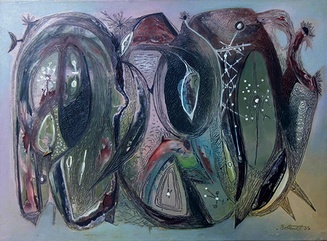
I BEGIN MY CAREER IN ART
You walked into the building and a large open room served as a gallery. Since it was summer time, the work completed that spring was on exhibit. Amongst the exhibits of life drawings, sketches, paintings, portraits and still lifes were a series of brilliantly colored designs from the Rudolph Schaeffer Design and Color class. These were tiny compositions maybe five inches by three inches, in gouache, of flattened decorative flowers and leaves. Even today the color would seem prismatic and you can imagine what it looked like in 1920, the tag end of the Brown Mission Furniture Period. I don’t know if Mother was offended by the strength of the colors, but I was stunned by them. I had never seen anything so brilliant, so jewel-like, and the colors were so pure. None of these maroonish reds and sort of cloudy blues. These colors sang! I said to Mother, “I’m signing up for this class. I’ve got to go to Mr. Schaeffer’s class.”
I signed up but there was very little happening in the art school during the summer except for outdoor sketching. My first artistic class was going out sketching with a teacher named Gottardo Piazzoni. I was so thrilled. I was starting my art career.
Mr. Piazzoni led us to the Sausalito Ferry. We went across the Bay—no bridges in those days—and landed in Sausalito. Then we took a little red electric train a few miles into the countryside and got off at a station called Waldo, a beautiful uninhabited spot. As far as you could see there wasn’t a house or anything, only rolling hills going down to an inlet of the Bay.
To our left more rolling hills and live oaks. We crossed a road, which is now, of course, Highway One. There were no fences. We walked up one of the rolling hills and sat down where we had a good view of the Bay and the mountains.
I had never done this in my life and I was in seventh heaven. I had purchased a wooden sketch box with slots to put some canvas boards in, to paint on. I had a selection of student oil paints. I had two oil paint brushes, a bottle of pure rectified spirits of gum turpentine, which doesn’t smell like the stuff they sell nowadays, but it was perfume to me. A little tin cup to put the turpentine in, paint rags and a lead pencil, to start drawing my masterpiece.
I sat near someone so I could see what she was doing. I knew none of these students—this was the first time I’d done anything in an art class—and they didn’t know me, but we got acquainted later on. I didn’t know whom I was watching. She squeezed her paint out; I squeezed my paint out. She put the little tin cup on her wooden pallet; I did the same. I filled it with turpentine. I then started to draw the landscape I saw before me. It wasn’t necessarily good, but I didn’t seem to have any trouble drawing what I saw. I guess I’d just absorbed drawing as a way of doing things. At any rate, I drew what I thought was a fairly simple landscape and started in painting the sky, because the woman I was watching painted the sky first. I just copied her.
After a while Mr. Piazzoni came around. I kept hearing him say something in the distance because we were scattered over the hillside. When he came up close to us, he stood behind me a long time, looking at what I was doing. Finally he said, “Keep eet seemple. Keep eet seemple.” Which seemed to be his watchword because he was a very good painter and he did wonderful simplified paintings of the California hills. As I look back now I had most of the Bay Area depicted in my little 12 inch by 16 inch sketch board. I can see why he told me to “keep eet seemple.”
I sat there and it was heaven on earth. Here I was out of school. I was a painter. I was using oil paint. I was doing a landscape. It was for real. Of course, this euphoria didn’t last very long, but I’ve never forgotten that beautiful morning in the Waldo hills.
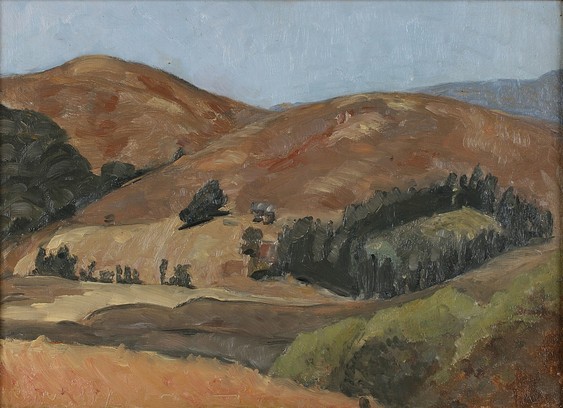
In no time it was September and the fall classes started at the California School of Fine Arts in San Francisco. Lee F. Randolph was the director of the school and he also taught Life Drawing and Anatomy. There was a couple from New Zealand, E. Spencer Macky, who taught Portrait Painting, and Constance Macky, who taught both Beginning and Advanced Still Life Painting. Gertrude Partington Albright taught Quick Sketch, a Saturday class in Painting, and occasional classes sketching from the moving model. She was a good teacher—a little bit of a thing with glasses and a high voice—but she knew her sketch styles and could really stimulate the students. Our sculpture teacher was Ralph Stackpole, home from Paris via Mexico, and a close friend of Diego Rivera. He taught sculpture in the basement. Harold Von Schmidt taught the Commercial Art classes. Gottardo Piazzoni, of course, then last but not least, my instructor to be, Rudolph Schaeffer. That was the complement of teachers.
There were about two-thirds more men in the school than girls. Part of that was because of returned soldiers, called ‘Federal Board’ students, most of them recovering from shell shock. Nevertheless, it was a man’s business. Ralph Stackpole is reported to have told the girls in his sculpture class (they were cutting direct in stone) that the place where they really belonged was in bed! Women teaching Art was all right. Only male artists who hadn’t really ‘arrived’ taught, so naturally it was okay for women to teach.
I took Color with Schaeffer, Drawing with Randolph, Portrait with Macky, and Advertising Design with Von Schmidt.
My first class was life drawing and I truly realized my abysmal ignorance when I sat down. I found a place where you sat on a little bench with a small drawing board in front of you. I didn’t realize that it was vacant for the simple reason that it was the most difficult pose–the model was reclining and you had a good view of the soles of her feet, which more or less hid the rest of her body. But I didn’t realize that. I couldn’t see what other people were doing. When the model rested I was really too shy to be seen looking at their work. Most of them just indicated things on the paper with charcoal.
Eventually, before the class was over, Mr. Randolph came in to give a little critique. He stood behind me for awhile, then asked, “Are you thinking of making art your profession?” I said, “Oh, yes, sir!” And he said, “Well, look at some of the other students’ work and try to do what they’re doing.” I took that to heart and I did look at their work. I could see that mine was small with a kind of a crocheted, shady edge around it, whereas theirs had large sweeping bold strokes. So I copied that. That was my first morning.
In the afternoon I went to Mr. Macky’s class. This time it was drawing a model—a difficult model because a young child, maybe 12 or 13, was posing. I guess there weren’t child labor laws then. Again, the only vacant space was where I saw him almost in profile, against a bright window, so mostly it was a matter of shading the whole head and ear and shoulder in darkness.
Mr. Macky, in his nice New Zealand voice and accent, was explaining something. I thought he was talking about the plates in the head. I couldn’t imagine what it was. Finally, when he stopped talking and we started drawing, I got up my courage and spoke to the person next to me. “What did he mean, saying about plates?”
“Plates?” she said. “Planes, you dummy, planes of the head.” Then she made the same gestures Mr. Macky had made, with her hands flat on each side of the temples, then kind of curving them across—and I realized what he was talking about.
Every class that first day showed that I really didn’t know anything. The school had a good library and that afternoon I checked out a few books that I thought might be helpful to understand the vocabulary.
Tuesday, the second day, was the morning with Rudolph Schaeffer. We had a long list of materials to get, all kinds of tempera colors, and a special block of paper. And little dishes, the kind that restaurants used to put pats of butter in. I still have some of those little heavy white pottery dishes about two and half to three inches in diameter. When you went to cheap restaurants they would slap down the bread and give you a little square of butter on one of those. We used the plates to mix our color. We had a little palette knife.
The most astounding thing to me was Schaeffer’s appearance. This was only a few years after the War and we still wore clothing in subdued colors. Most of the men wore either browns or navy blues. About the most radical thing might be a beige sweater. The women wore the same thing, heavy on gray-blues and sort of spotty grayish browns. Nobody was seen in anything that you could call bright colors. We all wore hats. The men wore hats or caps. My hat was a brown felt hat and I think I had a brown coat. Some people had navy blue. But there was no color. There were touches of pink, touches of pale green possibly, and little dabs of white. But especially in the art school, nobody wore white because it gets so dirty.
Mr. Schaeffer was not wearing the normal kinds of clothes. His studio was downstairs where we faced the terrace. He had slightly pinky-red hair, with the blond complexion that goes with that, and blue eyes. He was wearing a pair of pants that were pale blue gray. He wore a tweed jacket with little dabs of pure turquoise blue and little dabs of orange and brown; but those little dabs of color certainly stuck out. And he was wearing, of all things, a hand-woven tie.
In those days men mostly wore striped ties, with perhaps the colors of their college or ties imitating university ties—grays and white with maybe a tiny line of white, or dull navy blue and a little line of white with possibly a touch of maroon. Mr. Schaeffer wore a hand-woven beautifully spun wool turquoise-blue tie. When he came down the steps, and we saw this costume, there was dead silence. Finally he said, “Good morning. My name is Rudolph Schaeffer.” There was a long pause before we could get our tongues to say, “Good morning, Mr. Schaeffer.” We were so astounded by his clothing!
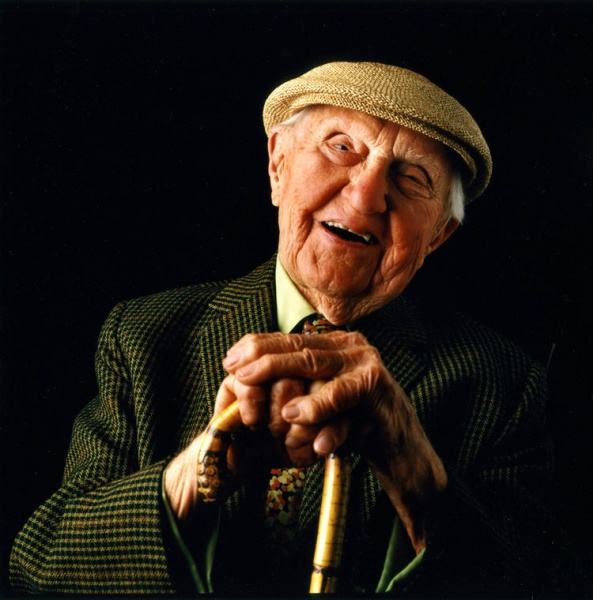
Then he began talking about color and what we were going to do. I didn’t think I would ever forget what the lecture was about, but I don’t remember. However, it had to do with clarity of color, and what color suggests to you, and really observing colors in nature as they were. The blue of the sky, then taking that blue away from the sky and seeing it as just a beautiful piece of color and realizing what its value was. Well, it was a whole brand new vocabulary. I felt almost as if, while everybody was speaking English, they were also at the same time speaking a foreign language.
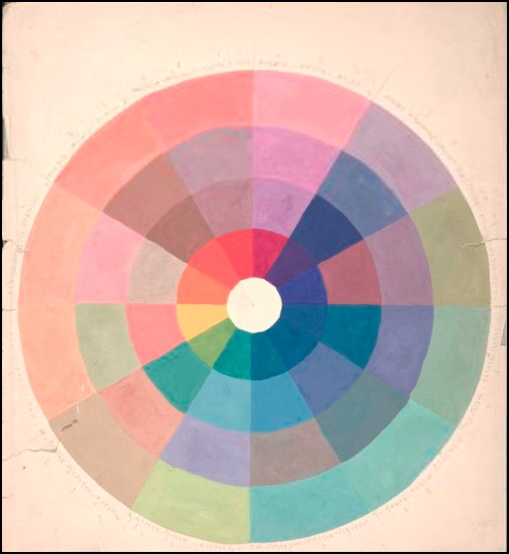
Those first classes were the ones that really were the most difficult to absorb. I had no intention of quitting school, of course, but I realized that the vast expanse of my ignorance was formidable. I really didn’t think that I’d ever learn.
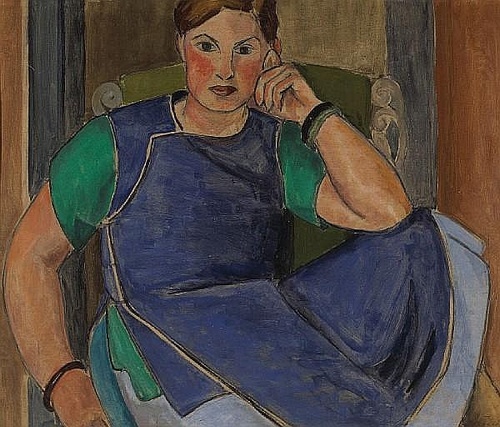
However, I became accustomed to art school and made friends. One girl, Ruth Cravath, was studying sculpture as well as doing life drawings. We had a friendship that lasted until her death. Another girl did beautiful quick sketch drawings– she stood out with that. So I got acquainted with the students and art school life began to move at a normal school pace that I was used to.
I was slow in learning to use the tempera paints, which are like poster paints—actually gouache. I put it on so that it had a velvety surface, and tried not to use it like watercolors thinned out, which Mr. Schaeffer really didn’t approve of.
There were a number of assignments to be done at home for his class and it took me quite a while. I didn’t live a very complicated social life. But there didn’t seem to be any allowance for painting in the apartment Mother picked out for me—I was always afraid that paint would drop on the floor. What I needed was a simpler environment.
One of the girls in the Schaeffer class, Dorothy Wagner, lived down the Coast at Montara, where her family owned a flower ranch. She needed a place to stay during the week. We decided, with her family, that it might be a good idea if we got an apartment together and found one in a wonderful old mansion on the corner of Franklin and Sutter streets. The house had two small bedrooms under the eaves, with a large space in the middle that we could share for working, because we both had homework. That simplified painting at home because it didn’t matter if the paint fell down on the bare wooden floor as the place was somewhat run-down anyway. The location was handy. We could walk to the art school and on rainy days we could take the California cable car.
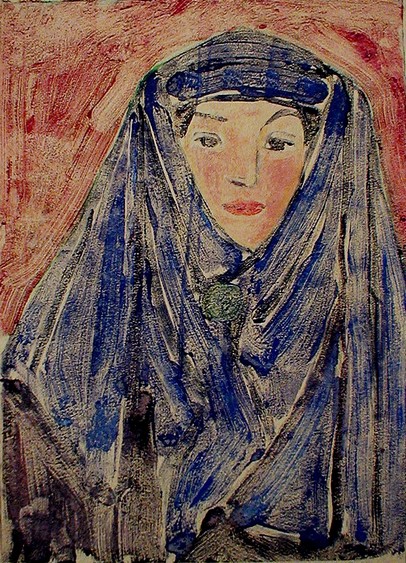
The only museum in San Francisco then was the de Young Museum, but it had no ‘modern’ paintings. The Palace of the Legion of Honor wasn’t open yet. The old Palace of Fine Arts was the only place where current art shows were held, like those put on by the San Francisco Art Association. Paul Elder’s Book Store on Post Street had an upstairs gallery that showed fairly ‘modern’ works. The art school had a couple of galleries, one quite small, the other large enough so that you could back off to get the total effect.
The high point of 1921 was a showing of facsimile size reproductions of work by Matisse, Cezanne, Van Gogh, Renoir and possibly Picasso, though I don’t remember him. This was the first time anyone who hadn’t been abroad or to New York had seen these works in color and full size. The German reproductions were wonderful and we students spent much of our spare time looking at them and talking about them. Mr. Macky brought them back from a trip to Europe. I was turned off by the distortion of form, particularly in the Matisse Nude with the Goldfish Bowl, but thrilled by the color.
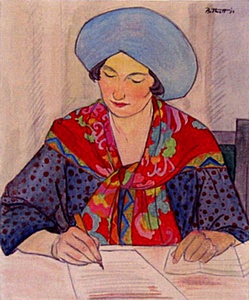
San Francisco had so many cultural events. It was the favorite stopping off place for all the finest performing artists of the world. Art students could find work at the vast Civic Auditorium. I ushered absolutely everything. Nijinski came to dance in Afternoon of a Faun—but he was sick that day. I saw Chaliapin in Boris Godunov, Mary Garden, and the soprano Tetrazzini–she was little, four-by-four, and they named the chicken dish, Chicken Tetrazzini, after her. San Francisco was a wonderful place for an art student.
One of the most exciting events was when Max Reinhardt brought his marvelous play, The Miracle, to the Civic Auditorium, which was changed to look like the inside of a 12th century cathedral. The orchestra was hidden way up high. The stage was left open the entire time with no curtains, and the audience faced the altar in a church. Behind the altar were lights and stained glass windows.
The play used music partly from the Berlioz Symphony Fantastique and selections from Humperdinck’s compositions. Lady Diana Manners played the part of the Virgin. It was the story of a miracle, of course. At one point in the play she had to stand immobile for almost an hour. They tried to put a statue there, but you can always tell the difference. So she agreed to do it. In the story the little girl was praying. Lady Diana, as the Madonna, suddenly moved her hand, which electrified the entire audience.
We ushers had to wear costumes, too. We were dressed as novices in brown robes with white colors and cuffs with a rope sash and armed with flashlights. Max sometimes gave us advice as to how he wanted us to usher. He was the first man I ever saw wearing a black wool shirt and a white tie.
The weeks flew by. Soon it was the end of the year and we began the spring term. The powers that be didn’t really approve of Rudolph Schaeffer, partly, I think, because of the wild colors—which would be very conservative nowadays—but also because they considered him very wild. They said, “You either understand color or you don’t—it can’t be taught.” So he was let go the following spring. Then he started up his own school.
I tried to go to both his school and to the art school that spring of 1921. But by the end of the term, when summer started, I had to make up my mind if I was either going to regular art school, or to really put my mind on the color that Mr. Schaeffer was teaching.
Because Schaeffer wasn’t using color systems—he was teaching color as scientists were analyzing it, as light. He took us to the University of California where they had equipment to show how color as light really operated, what real primaries in light were, how they differed from what we thought were the primaries in pigment. He taught us about the after-image, how your eyes worked, how you saw color, what happened. All these things were completely new to us and fairly new to everybody else.
But I didn’t know any of this. No courses were offered in aesthetics or art history. It was just straight art school. You drew. All I knew was that I lacked knowledge and I finally determined that fall that I should take my father’s advice and go to a university. I needed more of an education. So at the end of winter I went back to Oregon and talked to my father. We arranged for me to go to the University of Oregon the following year. I felt I needed guidance. That was always what I was looking for, so that’s what I did. This was the end of my art school career in San Francisco, for the time being.
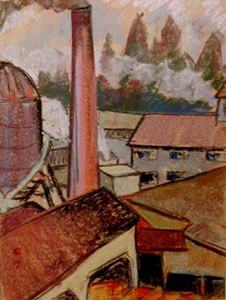
I went back to Oregon in 1923. My parents had moved to Port Gamble, Washington, and my brother was going to the university in Eugene. I took placement examinations and was admitted as a sophomore and a special student. My big stumbling block was English. I have trouble with the grammar. I can do grammar, I learned it, but could not quite comprehend the theory. So I never really passed Freshman English Composition.
I wanted to take pre-medical anatomy but that semester there weren’t enough students for it. I had some junior subjects and had to take more courses in other subjects, but I simply wanted to concentrate on the Arts. I took classes in aesthetics, which at least outlined the subject and listed books to read. And of course Art History, which I concentrated on. I lived in a dorm. My father was dead set against secret societies (sororities and fraternities) and I agreed with him.
In those days—and this was true in most of the colleges and universities—there was no Art Department. Art was not considered a university subject. If art was taught at all, it was taught as part of the School of Architecture. The University of Oregon did not have a separate Art Department, nor did the University of California at Berkeley, until considerably later. You could get a degree in Architecture. You could not get a B.A. in Fine Arts such as we have today. The Masters in Fine Arts did not exist. All you could get was a Certificate of Achievement.
You could get a degree in Art History but nothing as a painter. This I learned the hard way. So there was really no incentive for me to get degrees.
However, one of the rare women professors, the abstract painter Maude Kerns, who headed the Domestic Arts Department, took pity on me. I’m not sure what she was teaching because I never took any of her classes. But she bent some University rules and created a free painting class. I think I was the only one in it and I did a lot of painting on my own. She really was an inspiration and of great service to me, because she would hire a costume model and I could paint from the model in her classes. Because of her, I had some professional art training that year. She herself was a very good artist and had exhibited in Paris. She was painting abstractly, which was remarkable for the time.
I spent much of my time studying Chinese Art. The University of Oregon at Eugene had received the Murray Warner Collection of Oriental Art. Since I knew a little bit about the subject, they paid me for working part-time while they unpacked and organized the materials. I had a chance to make a study in depth of Sung painting, particularly bird and flower paintings and the brush strokes. They looked factual, but when studied proved to be decorative statements. There also were books on Oriental Art, which I studied on my own. One of the Chinese canons of Art stayed with me for years and influenced my work—the statement that “Shadows are an obstruction to clear vision.” For years I painted without using shadows.
But I realized that university life wasn’t for me—it was too chopped up and I wanted to spend uninterrupted hours on a work. I felt that there wasn’t any point in going to the University for another year, except to get my degree, and that didn’t feel necessary then. I could have gotten a degree in Art History, and I should have, but I didn’t. I also didn’t want to hurt my father’s feelings. He really had his mind set on me going through college. I was between a rock and a hard place.
What I did was to work hard on the classes I liked, so that I could get honors in those subjects, and dropped other classes that I didn’t want. Then I wasn’t carrying enough courses and I was put on a restricted list.
Since my last name begins with ‘B,’ and there weren’t too many Adamses, Bothwell’s name was at the head of the honors list. I took four subjects and I got four honors. It also headed the list of people who were suspended. I had cut all the other classes out. I showed my father the good news first, then showed him the bad news. He didn’t know what to do, but he finally understood. That was the end of my college career.
So I dropped out and went back to San Francisco in 1924 for half a year and studied with Rudolph Schaeffer at the Rudolph Schaeffer School of Design. By then I knew what I wanted to do, artistically speaking. I was painting and I was starting to sell and exhibit, so I did not pursue a degree.
I took a studio in the old Montgomery Building, which was affectionately known as the Monkey Block. It had once been a superior bank on Montgomery Street, but over the years the building had deteriorated and finally artists had discovered it. A number of artists had their studios in the building. Marie Parmalee, a model posing at the school, was the first woman to live there.
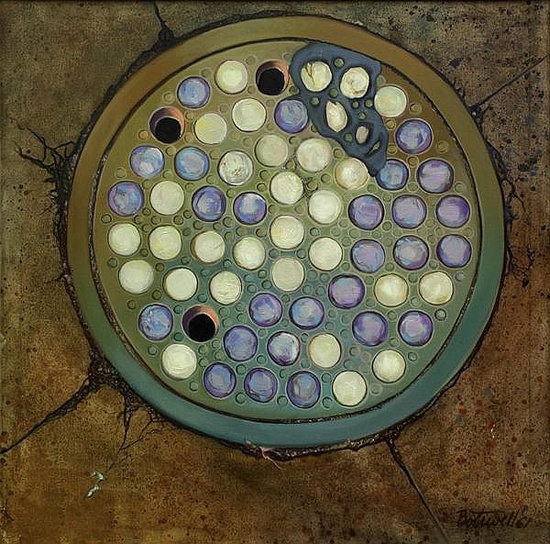
I was fortunate to get a studio next door to my friend Ruth Cravath, who was starting to work as a sculptor doing children’s portraits in terra cotta clay. Today we would be known as a group of emerging artists. We were all recent art school students, seriously attacking the problem of being artists.
1926—Dorr in her San Francisco studio.
One problem was quickly apparent, but I solved it. When I first exhibited, in 1924, the painting was rejected. Other women told me that this was because I wrote down my name, Doris Bothwell. They said that none of them put their first names down, because the jury was all men—and men who didn’t think that women should paint, at that. So if you had a woman’s name, as a rule the men didn’t bother to look at your work. Some women signed their paintings using only a first initial.
My maternal grandmother had named me Doris, but the family didn’t like the name so they called me Dor. I thought, “Well, if I drop the ‘is’ off of my name, they won’t know what sex I am. If I add an extra ‘r’ the name will look more finished, because Dorr is a surname.” People have asked me if it’s a family name. I went to the bank and asked if it would be any trouble changing my name and the banker said it wouldn’t be. So that’s what I did, when I was 20. Think how far ahead I was in my time, having a unisex name. But mostly so I’d be able to get fair treatment in the exhibitions.
Some artistically important things happened in San Francisco in 1925. The California School of Fine Arts moved to its own building on Chestnut Street. We finally had a Modern Art Museum showing modern art, located in part of the Veterans Building, with an entrance on McAllister Street and Van Ness Avenue.
The San Francisco Society of Women Artists was created and a number of us—Ruth Cravath and Rosalie Maus, sculptors, and myself, Edith Hamlin and Marion Trace were five of the emerging artists who became charter members. The Society wanted to have an exhibition and the big problem, of course, was where to show, especially modern painting. There didn’t seem to be a place. Finally it was solved by using an empty Cadillac show room on automobile row on Van Ness Avenue, where we gave our first big exhibition.
This problem of where to exhibit was a continuing one and some friends and I were dying to exhibit our efforts.
Finally, in 1925, a group of us—four women and six men—got together and opened something called The Modern Gallery, at 718 Montgomery Street. As far as I know this was the first cooperative gallery opened on the Pacific Coast. The whole idea of a cooperative gallery was something new and it intrigued the media. We got very good coverage and writeups in the newspapers on our exhibitions.
The new Modern Art Museum opened with a tremendous show of Paul Gauguin’s paintings and this marked the beginning of a wonderful era of exhibitions. The director of the Museum was Grace McCann Morely. Shortly afterwards she arranged for a show of local Bay Area painters. We were fortunate to have our works exhibited there.
But then I had a slight argument with my father. I needed some money and he wouldn’t come through with it until I did what he wanted me to do. So I quit school and got a job at Dorothy Wagner’s parents’ flower ranch near Montara, picking flowers in the fields as stoop and squat labor. The first day, just before Memorial Day, we had to pick three acres of what they called Brides’ Glads, little white gladiolas. We started out at 5:45 in the morning. They gave me a big pair of clippers. We picked a dozen, tied them up with wrapping, then laid them down. After you got through a quarter-acre you loaded the flowers into a wheelbarrow and walked up the hill to the tying house.
Finally, lunchtime came and that was a farm lunch: steak and potatoes and stuff like that. I couldn’t even hold the knife; somebody had to cut it; I could barely hold the fork. I’d never done that kind of work before, but I got used to it. Then they realized that I was built so close to the ground that I’d be better picking French Double Violets and Pansies.
However, it began to dawn on me that the sort of life I was living was really hand to mouth with no security of any kind and I realized that I should do something about it. I also had found out along the way that I rather enjoyed teaching. I’d helped Rudolph Schaeffer as an assistant, explaining things to some class members when he was busy. I enjoyed the experience.
So once again I regretted the fact that I had no degrees. Even a B.A. in Art History would have been better than nothing, and at least with that I probably could get a place in an art school. I certainly didn’t want to go into public school education and I was not particularly interested in trying to fit myself into the framework of a college or university. So I thought, once again, “Well, I’ll go home, tell my father that he was right, try to enroll and see if I can get through in a year and a half at the most, then get my degree.”
I made this decision in March, 1927. The next month my father was instantly killed in a railroad accident. That was a great blow and, in a way, affected my brother more than me because he was still in school working on his M.A.
Port Gamble, of course, was a company town and, even though my father was an officer of the company, we still had to move within two weeks.
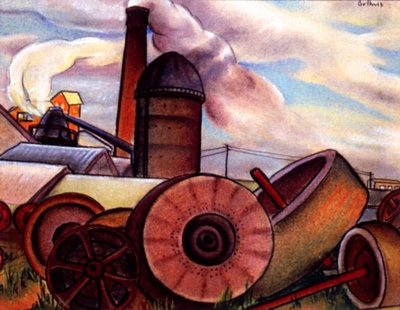
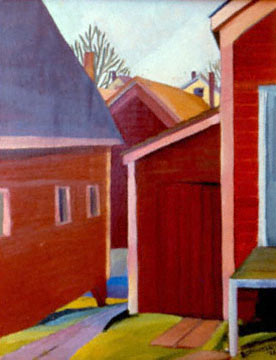
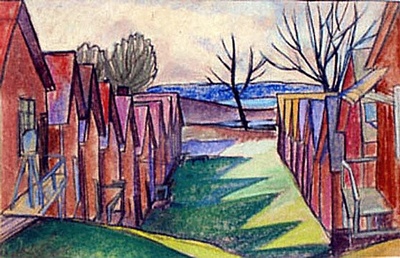
After 21 years my father had finally decided to become an American citizen. His British will was invalidated or at least didn’t make much sense. He had been working on a new will, but nothing was signed. Overnight everything was just turned over to Mother. She wanted to go back to San Diego. My brother came from Eugene and together we managed to pack everything up and get out in the required time. My brother drove my mother and me as far as San Francisco, where I left them, then they continued to San Diego.
I was scheduled to have my first one man show of oils at The Modern Gallery. I had two abstractions and the rest were something called ‘Fanciful’ by the reviewers. I was drawn to Aubrey Beardsley, which was probably the wrong influence. I was struggling with the problem of showing the underlying design in nature, while still giving the effect of a factual statement. I did it, but I don’t remember much about it.
The exhibition received very good reviews, but that didn’t seem to matter to me. I was trying to put the pieces of my life together. As soon as the show was over, I went down to San Diego to join my mother.
I learned one very important thing. While I was still more or less in a state of shock, I went to my little studio to pack up the exhibition that I’d been painting for, which was to be held in May. As I put the paintings together, I saw one that needed a little bit of work done, just in the corner. I figured it would take me about half an hour to complete it. My paints were right there and I started working on it.
As I finished up this painting, I suddenly came to and realized that I was, as usual, happily dancing back and forth, and sort of singing to a Viennese waltz running in my head. And I realized that for me Art was a kind of drug. My eyes, at first so swollen from crying that I could scarcely see how to paint, were dry—the whole situation had gone completely out of my mind and I was immersed in the painting. I said to myself, “Don’t ever forget that if another blow happens like this, you can weather it by just starting to paint!”
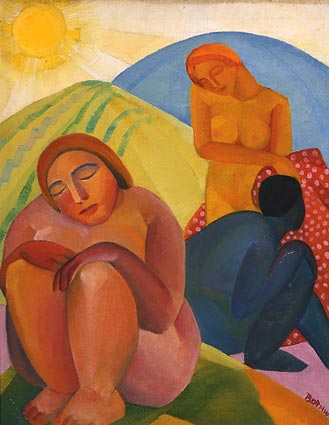
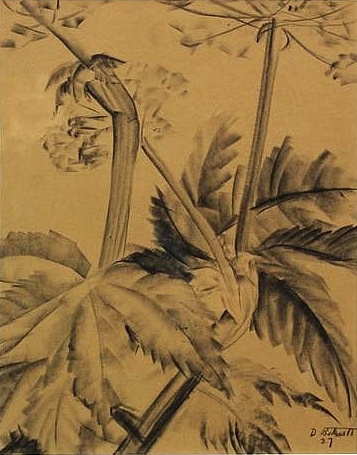
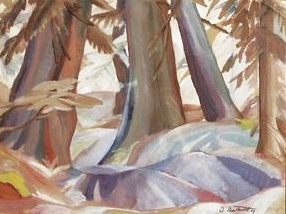
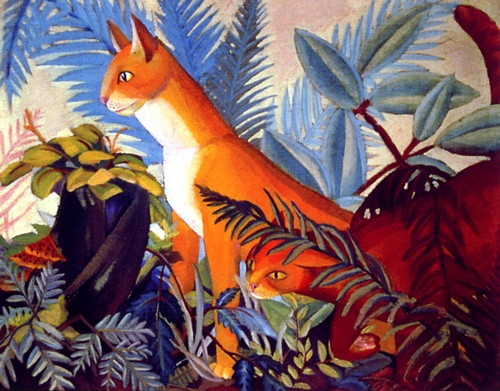
In San Diego we helped my mother get settled. My brother rallied around us and got a job loading mining timbers with Mexican labor. I got a job working at Ingersolls as a waitress. Ingersolls was a place something like the Pig and Whistle used to be (The Pig and Whistle’s gone, too!), a restaurant that had, not so much a breakfast clientele, but luncheon, tea time, later dinner, then was still open for after theater crowds. It also had a great soda fountain and was famous for ice cream and chocolates. I worked a split shift. I went to work about ten o’clock in the morning and worked through the lunch hour until 1:00 or 2:00 pm. Then I had a few hours off and started in again for the late afternoon tea shift that went to the evening. We had to stay and dry polish glasses. They didn’t have the kind of dishwashing system that is used now. I would catch the last streetcar and get home about midnight.
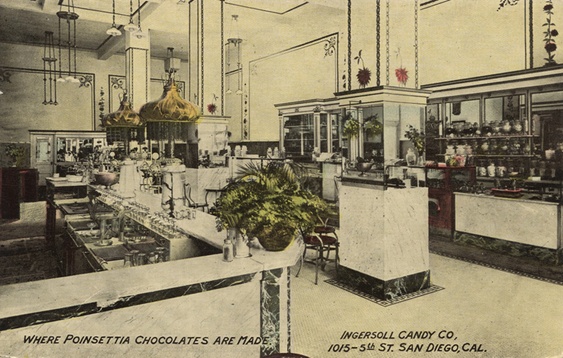
Then I’d get up early in the morning and paint until it was time to go to work. I was still exhibiting.
I tried very hard not to feel sorry for myself, but it was a tough time. Sundays I acted as docent at the San Diego Fine Arts Museum in Balboa Park, took people around and lectured on the latest modern shows and current exhibitions. I also gave some short courses for the Fine Arts Society in Color Design and Structural Color. Sunday was my day off as a waitress, then Monday I put the cap on again and went back to work.
It was a long streetcar ride from downtown San Diego out to where we lived on Juniper Street. To keep my mind from being depressed, and falling asleep, what I had begun to do, riding home late at night, was to visualize the South Seas. I had just seen Robert Flaherty’s black and white silent film, Moana, which was filmed in western Samoa, on the big island of Savaii.
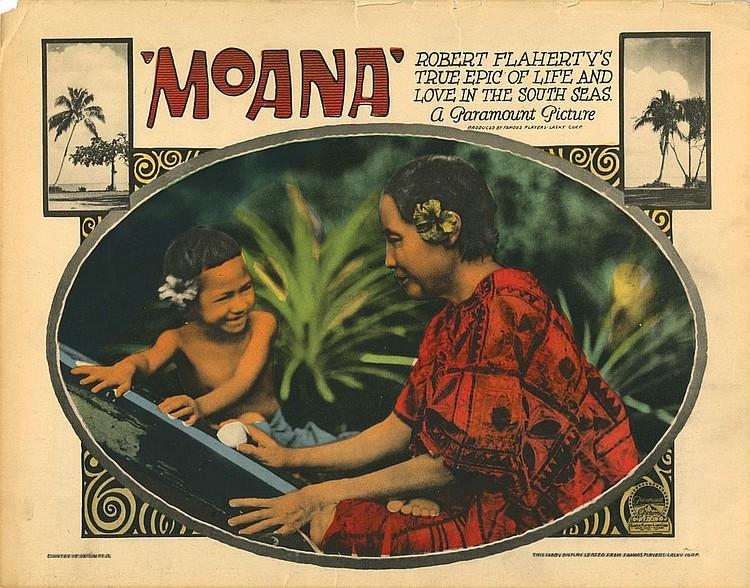
It is really a beautiful film, the first film I ever saw in which the photographer used a filter so that the sky was dark and the clouds were light. Of course the clouds in the South Pacific are really something, but they are never shown that way because South Pacific skies aren’t deep blue. You have masses of clouds, but you don’t see them like in New Mexico, where you have masses of clouds but the skies are deep, deep blue. Not in the islands, because there is so much moisture. It’s so humid that it’s kind of crystalline, a pale blue sky. Flaherty darkened them and it’s fabulous. The attention to detail of the values of black and white, and the way the film was organized, was astounding. He used native people who had never been actors.
I had never seen an ethnic film before and Moana was delightful. There was no recorded Samoan music, but they used recordings of Tahitian music, which fitted in, and had been adjusted to fit the actions of the dances. This movie was magical and seemed symbolic to me. I found that when things got too difficult, I could relax by thinking about the scenes. I saw the beautiful landscape, the dances, and especially the amazing dark skies and light clouds.
I think I saw Moana five times. Then I tried to figure out how I could get to the South Seas. Each night when I came back from the restaurant I’d pretend I was sitting on the beach and could hear the waves and was listening to music and could see the people. To take my mind off my feet, which sometimes rebelled at being stood on all day long, and to just forget everything else, I would visualize scenes of the life of the Samoans in Savaii.
I imagined those things so I wouldn’t think of this incredible yet very real vision of my future that haunted me. I can see it right now—the sky was absolutely gray-white, more gray than white, no bushes or anything on the ground, with nothing on each side, just darker gray. Then a long terrible bare gray path came to a point, right dead center of a horizontal canvas. And that was all. I wouldn’t dare paint it.
On Christmas Eve I was on this last streetcar and it was filled with kids home from college. They seemed to be having a wonderful time and I was suddenly overcome with self-pity. I really couldn’t stop getting more and more depressed and I realized that soon I’d be crying. We were all standing—it was crowded on the car–and I moved toward the front where the motorman was. It was starting to rain. I was hanging on. He had his window open and just a few sprinkles were coming in and I thought, “I’ll stand here and if I cry, they’ll just think I’ve got rain on my face.”
As usual to take my mind off my troubles, I started thinking about Moana and I wondered what the Southern Cross looked like, because I was sure you could see it from that part of the South Seas. Samoa was about 300 miles below the equator. It’s upside down in the Northern Hemisphere. When you get below the Equator, you see it right side up. So I was visualizing the Southern Cross and I could just feel this thing fuse. I really was there! I really was right there! I was on the deck of a ship. I could feel the ship rolling (of course it was the streetcar swaying back and forth, because the conductor was making up time, back of Balboa Park). I could see the Southern Cross and I was there. I thought, “Well, it’s going to happen.” Suddenly all the depression left me and I felt light hearted. The whole idea of the Southern Cross and the South Seas just seemed delightful. I imagined that I was sitting down on the white sand with black velvet shadows.
I didn’t let myself get into it too deeply because I was afraid I would miss my stop. By then the streetcar was almost empty. I went back and sat down and felt happy for the first time in months. As I got off the car and walked home, the bells in the Catholic church began to toll, for Christmas Midnight Mass. After I got home I distressed my mother a bit because I seemed to be lighthearted, and this was the first Christmas since my father’s death.
This experience taught me something, because a wonderful thing happened to me. I’m a great believer, you know, in what you visualize, you get, if you fuse it with emotion. If you’re just daydreaming and it’s a pleasant thing and you’re seeing it in the future, it stays in the future, and is only a pleasant thing. A lot of people’s ships never come in. They stand outside the harbor, because that’s where they see them. But I was more or less trained to visualize the things I wanted—and sure enough, they came to me.
About three months later I received a letter from a lawyer in Chicago, who said that my Aunt Maria Theresa von Lushcka had empowered him in her will to give me three bonds that she had purchased on a new building being built in Chicago. Each bond was worth $1,000, which in those days was real money. I was astounded! I heard all kinds of suggestions as to what I should do with this money. But I already knew what I was going to do, because here was this long gray road. I realized I didn’t have the education, I didn’t have the degrees, I didn’t have the ability to do anything—and I didn’t really want to do anything—except paint. I thought, “Well, I just don’t know what my future will be.” What I had to do was go away someplace—and paint! No interruptions. I wouldn’t know anybody.
My father taught me that you should always treasure the experiences you had because they were riches that couldn’t be taken from you. The books you’d read, the things you knew, the places you went—you could be in solitary confinement and everything could be stripped away from you, but they could not take away what you had in your memories and in your head.
The extraordinary thing was that the gift of the three bonds was from my Aunt Maria Theresa von Lushcka, who lived in Switzerland—all because she remembered that a few years earlier, when I was living in San Francisco, I had given her what she called “the most interesting and exciting day” of her life.
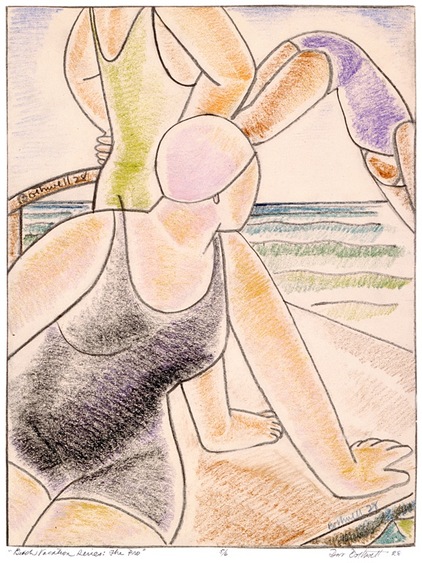
Aunt Trissie had married the inventor of the meat slicing machine, the man from whom my grandfather had bought the patent. Von Luschka was a Prussian who, to avoid being drafted and doing his military service, became a Swiss citizen. After her husband died, Auntie Trissie had come out to the Coast because she wanted to see life in California, where she had never been. She was on her way to San Diego to see her sister, my mother, and stopped in San Francisco to visit me At that time I was having a difficult time keeping afloat financially. I had a series of little daytime jobs but there were none that I could quit. Naturally I was still painting. I was going to be paid that day, on Friday, and I borrowed a car so I could take her to dinner. But first thing in the morning I had to go to a life drawing class because I had already paid for the model.
I met Auntie Trissie at the train station. I had never seen her before, but I knew who she was. I told her that I had jobs to do but they were not routine jobs and I thought she’d like them. She’d had her breakfast on the train before she came in. I said to her, in false gaiety, “Well, you’re going to have to live through the life of a budding artist, and we’ll have lunch with artists.” She thought that would be “veddy veddy nice!”
First we went to the life drawing class. I thought she would go straight through the floor because of the nude model, but she sort of clamped her teeth shut and sat with her eyes closed part of the time. She said she found the train trip fatiguing. I said, “Well, take a little nap. We’ll be through here in about an hour and a half.”
Then I took her out for lunch to an artists place called the Iron Kettle and we had one of these pseudo-Italian lunches, which she seemed to enjoy.
After that, I had a real job. I was working in a theater painting props and some of the scenery. Fortunately that was the day the cast was rehearsing Gilbert and Sullivan’s Princess Ida. Auntie Trissie sat out in the audience and listened to them stumble around in their singing, while I was back stage painting the flats. It was a long afternoon, but finally we went to tea downtown at the Temple Bar Tea Room, on Grant Avenue. Now it’s galleries and stuff. It was a tiny little place—pseudo oriental—real chic for cheap rice cakes and a cup of tea, but it had a lot of atmosphere. Auntie Trissie was entranced. After all, she came from Zurich and that’s very conservative.
I drove her around San Francisco, and finally out to the ocean, where she saw Ocean Beach and Playland. I decided we’d go for dinner at the Cliff House and was praying that there would be seals for her to watch. Sure enough, the seals were barking and we watched them out the restaurant window. My aunt was intrigued. She was taking the night train— the Owl—down to San Diego. I drove to the station, put her on the train so she could sleep and recover from a tiring day, and sent her down to Mother.
Everybody gave me advice as to what to do with the bonds. Buy a lot. Buy a house. You could buy a small shack-type house for $3,000. For $2,000 I could have gotten a decent little place. Buy a car. Do all these different things.
I knew exactly what I was going to do. I immediately went to find out about steamships going to Australia that would stop in Samoa. The Matson Lines had a small commercial steamer named the S.S. Sonoma. It was called a cargo ship, that stopped in Honolulu, American Samoa and Sydney and took relatively few passengers. The ship needed to be retired—it must have been 25 years old—but was still chugging along. Imagine, the fare was less than $250 to cross the whole Pacific Ocean. I sent them a check and arranged for passage. One good thing was that the ship left from San Diego.
The three bonds were worth $3,000, but they were sold for a little less because I wanted a fast turnover. I put about $1,000 in the bank and kept out $2,000. I got a letter of credit for about two-thirds of that, and had the rest in cash.
Why did I so badly want to go to Samoa? Well, I had a job as a waitress, working a broken shift, and was still trying to paint. I didn’t know how to do anything but paint. So I thought I had better create some good memories, because otherwise there was a long gray life ahead of me. I would get out of it and I would invest in myself.
I had to be vaccinated. I didn’t know how to tell my mother. The vaccination was a little sore and for some reason she grabbed me by the arm, perhaps to steady herself, and I flinched or said, “Ouch.”
She said, “What’s the matter?”
I showed her my vaccination and said, “Mother, I’ve been vaccinated.”
“Why?”
“Well, this is as good a time as any to tell you,” I said, “I’ve booked passage to go to the Samoan Islands.” She only vaguely knew where they were. She was stunned.
You’d think I was jumping off the edge of the earth, the way my friends acted. First of all, for a young woman from a decent family to go off by herself without an older woman or a companion of some kind was horrifying—nice girls didn’t travel alone! That was the first strike against me. You had to face groping hands. Men would size you up. But I learned a very determined sort of way. I never flirted. I was all business.
Secondly, in those days tourists didn’t go to the South Sea islands, because nobody knew anything about them. They may have read some stories, like Somerset Maugham’s Rain, but that was all they knew. Even the National Geographic didn’t publish much then and what they had wasn’t as exciting as showing people from New Guinea. Their articles used black and white photographs. Not until the ‘40s did the National Geographic reproduce color photographs, which were still pretty dull.
But in spite of all the negative input that my friends, and her friends, gave my mother, I persisted, and in May of 1928 I sailed for American Samoa.
MY SAMOAN ADVENTURE
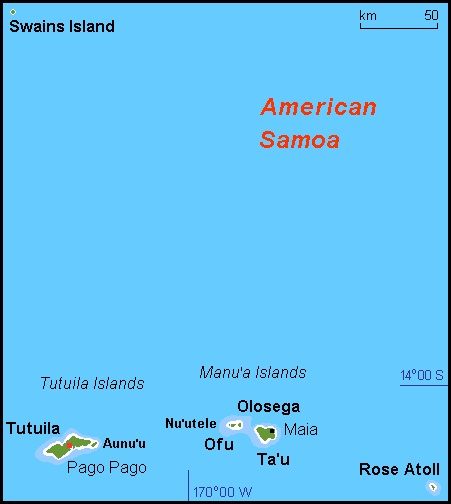
The voyage took 13 days, with a stop at Honolulu. On the last night we were informed that we would sight land by sun up. Together with some other passengers, I was up on deck waiting to see it. At first the mists seemed to thicken along the horizon. Finally, they threaded themselves and faded away and the light had an iridescent quality. Gradually this great green forest appeared, sitting in the middle of the ocean with a big mountain to one side. There was a slash of brilliant white where the white sand met the almost peacock blue water. It was extraordinary and so silent. Suddenly we began hearing the birds—the seagulls came to meet us. We realized that we truly had sighted land. We could smell a certain kind of green smell, that I always called the leaves of trees. That was my first sight of the island of Tutuila.
As we entered the harbor of Pago Pago, to our right was this enormous mountain, called The Rainmaker. A forest of palms and green trees surrounded us.
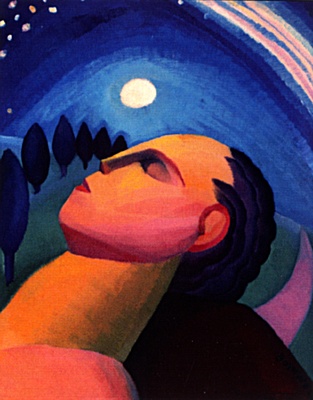
What I hadn’t bargained for was that American Samoa was run by the United States Navy. Before the First World War Western Samoa belonged to Germany. After the war New Zealand was given a League of Nations mandate to Western Samoa. The United States acquired American Samoa in 1900, for use as a coaling station for the American Navy, which ran it exactly like a foreign country from a big naval base at Pago Pago. Most Samoans, however, just referred to it as Samoa. They had never been officially ‘adopted’ by the United States Navy.
I came ashore on the island of Tutuila. (The Navy men called it ‘Too Too Twila’—they never could get it right, which is too-twee lah). And, to my surprise, I discovered that being an American citizen didn’t count. I had to show my passport. I had to make a deposit of $250 in case I was considered an ‘undesirable’ and needed to be shipped off the island.
When I checked in they asked, “Where are you going to stay?” and “Do you have friends here?” thinking I had friends in the Navy and had come to visit them.
“No,” I blithely answered, “I don’t know anyone here.”
They said, “This is a Naval Station.”
I said, “Yes, but I’m an American citizen.” When I asked if there was a hotel, they said no. I asked if there was a restaurant, they said no. I was hungry. “What about food?”
“No,” they said, “The commissary is closed to civilians.”
Finally somebody volunteered that there was a place that sometimes put up visitors. “Maybe you can stay over at the store up the road, if you want to try that.”
“Well, can I leave my trunk here?”
They said I could leave my trunk there.
I walked up the road, in two minds. First of all, I was thrilled! I was in the South Seas! Second, the South Seas were pretty grim as far as the reception I had received.
I walked past trimmed white houses where the Naval officers lived. Some of the officers’ wives were sitting on their screened porches. When they saw me they immediately went inside. Nobody even said hello, just, “Oh! Who’s she?” I really was somewhat disappointed.
When I got to this place, it looked like the typical houses I’d seen when the ship had stopped in Honolulu, with a rusty corrugated metal roof. Most of the houses had a living room downstairs, but a great big porch upstairs. Part of the roof was covered with palm leaves—it probably leaked.
It was owned by a Swiss man named Kneuble, who settled in the islands years before and had married a Samoan. He had a store right there in Pago Pago, because of the large Samoan population. Some of his relatives worked as servants on the base. The rest were quite self-sufficient, because they had their own taro patches, grew their own papayas, and had their own coconut plantations.
I went in and said I needed a place to stay over night. I didn’t know how long I would be there, because I wanted to get to a smaller island. Kneuble spoke a little English and said I could stay, for a very nominal fee. I was glad to get a roof over my head. I walked back to the base for my suitcase, checked the trunk in a storage shed, then returned to Kneuble’s.
I was extremely hungry and finally I went back to the Navy Office and talked to one of the men, “What about your canteen?”
“Oh, no,” he said, “it’s not open to civilians.”
“Couldn’t I pay someone to go in and get me a sandwich or something?”
“No, ma’am,” he said, “The canteen is closed and not open to civilians.”
I think they must have thought I was an adventuress or something worse. I got a very cool reception. Of course, it was perfectly true that nice women—after all this was 1928— didn’t travel alone. But an officer standing nearby heard the conversation and later on brought me some sandwiches to the place where I was staying. I wolfed them down with some lukewarm coffee. I hadn’t had anything to drink, either. I was a little squeamish about the water situation, not knowing what to expect.
That was my first night. Upstairs over Kneuble’s the bed was just a flat four post wooden platform with some mats on it. My little bedroom opened off a tiny living room that abutted the porch, which I could see outside. I opened the doors to get a little air in the place and suddenly thought—this looks very familiar. I remembered it kind of fitted the description that Somerset Maugham had written of Sadie Thompson’s room in Rain. Whether or not that was true—somebody told me afterwards that the description had been modeled on this room— I’m not sure, but I told myself that it was.
I was 25—and all alone in the wide, wide world. It looked awfully wide at the time and I think I cried myself to sleep, because things weren’t working out the way I had envisioned them. I was so fatigued from everything that had happened that I slept like a log and woke up early in the morning, really hungry. I could hear voices—everything there starts early in the morning. There was a lot of talking. I saw a little boy coming out of Mr. Kneuble’s grocery store, eating a piece of sugar cane. I thought, “Well, that’s something that will sustain me.” I went in, bought some sugar cane, and asked Kneuble about the situation.
He said, “Well, this is a Naval Station. It’s really not set up for civilians. What you need to do is to find a Samoan family to stay with and then you can stay.”
I had told him I was an artist and that I wanted to be someplace where I could work and paint and naturally leave the Naval Station.
Kneuble didn’t have anything in small amounts. He sold groceries when people had a feast, like five pound tins of corned beef and two pound tins of peaches—great big can-ning-size containers.
As I was sitting on the front steps eating the sugar cane, a small Ford flatbed truck with two seats and a little canopy on top drove in. People jumped off and other people jumped on. “What’s that?” I asked.
“That’s the stage to the town of Leone,” Kneuble answered. “There is Mrs. Falke. Now she might take you. She has a nice place out there.”
“Falke?”
“Yes,” Kneuble replied, “She was married to a German commander in Western Samoa.”
He pointed at this tall robust gray-haired Samoan lady.
Samoans, who are pure Polynesians, are very tall, taller than Hawaiians. The men run six feet, six feet four, and weigh about 250 lbs—they’re not skinny. They have big bones, rounded muscles and a layer of fat which protects them from sudden chills. If they ever lose that layer of fat, they’re prone to get cold. A common cold can lay them low.
Mrs. Falke wore a Mother Hubbard dress and her hair was done up. I explained to her that I was an artist—a painter— and that I wanted to paint the people and the scenery and that Kneuble had told me to ask her about lodging.
She said, “You can come out to my place for a few nights and we’ll see how it works out.”
I got my suitcase, arranged to have the trunk brought the following day, and got in the bus, which was filled with people, chickens, all kinds of groceries, fruit and vegetables. Mrs. Falke pretended she didn’t know me—she sat in the front seat with the driver. I was in the back with everybody else.
I expected the bus to go to Leone, but it stopped after a few miles. A large girl and two young boys waited at this little path. Mrs. Falke got out, everybody greeted her, and she rapidly told them what she had. They loaded up baskets woven of fresh green palm leaves containing, I think, breadfruit. I wasn’t sure, because they contained things I’d never seen before. Samoans don’t carry things on their heads. They carry them in their arms, or go two by two, with a stick over each shoulder and they sling the baskets on the stick.
It was just a short walk to her place and I couldn’t believe it. We turned into what looked like a garden of all kinds of flowers and trees—large hardwood trees, that I think belonged to the chestnut family, wide heavy-leaved breadfuit trees, and a couple of palms. And, of course, banana plants, and papaya shrubs and smaller bushes. In between the red-flowered hibiscus and other flowering plants was a large tree that looked like it belonged to the avocado family.
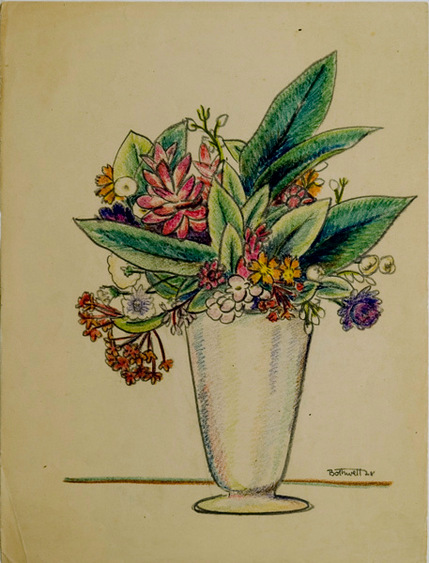
Mrs. Falke’s house was squarish with a porch and low roof, again of corrugated iron, with Samoan woven screens or shutters. They were actually a series of mats about 2’ x 1’, slung together so that they slid over each other to make a kind of a shade that could be pulled up or lowered and give some privacy. Nodding with her head she showed me the guest house, which was just one small room with a corrugated iron roof and these shades. They didn’t have screens, because the humidity would have rusted them out in no time. The mats sort of inhibited some of the flying insects.
There was a white style bed, but instead of a mattress it had planks and mats on top of it. She asked if I wanted a mattress, but I told her that I’d been sleeping on mats and found them comfortable.
Mrs. Falke mentioned that dinner would be at sundown, and I realized that they only ate two meals a day. My breakfast was only the piece of sugar cane but I decided that I could stand it, and besides I felt that I needed to lose a little weight anyway.
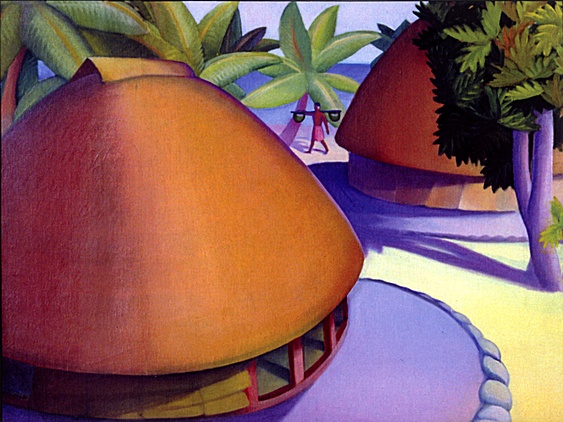
There were two Samoan-type houses in her compound, beautiful circular houses with palm roofs built with tree trunks all the way around. The roofs came down within about 3’ of the ground, so to enter a Samoan house you had to stoop down and enter bent over. You didn’t straighten up if anybody was sitting in the house—you kept your head on the same level as their head—and they would be sitting on the floor, which was covered with mats.
She had a typical Samoan house as well as what they called the papalagi house. I was intrigued by this word and since she spoke some English, I asked her what it meant. It’s two words. Papa is a lava rock with holes in it—Lagi is the heavens. It seems that in ancient times, great rock—papa rock, lava rock, came down from the heavens and landed on one of the islands. Out from the rock came these white people. Then they went back into the rock, which rose back up into the heavens. Ever since then white people have been called papalagi.
I was amazed. Of course, this was long before the idea of flying saucers, but when the flying saucer thing began, I immediately wondered about the Samoan words for white people.
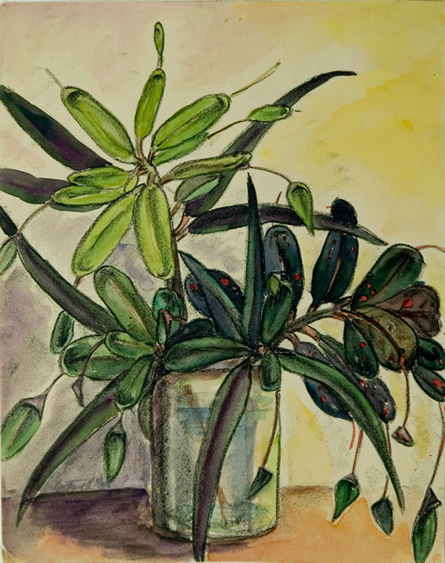
That first night I showed her some of my work. She was impressed by the drawings.
I made a point of picking up Samoan—how to say “thank you” and “please,” “yes” and “no,” “good” and “bad”—very basic things, but I was trying. She decided to let me stay and charged me on the basis of $21 a month for room and board.
There was a chest of drawers in my room, in the guesthouse, and I took some of my things out of the suitcase. Outside was a pitcher and a bowl for water where you could wash and a sort of shower. A pipe brought in fresh water from one of the streams that I could hear nearby. Most people, when they washed, simply took showers. They loved being in the water. So I took showers. There wasn’t much privacy, but enough so that I was able to relax.
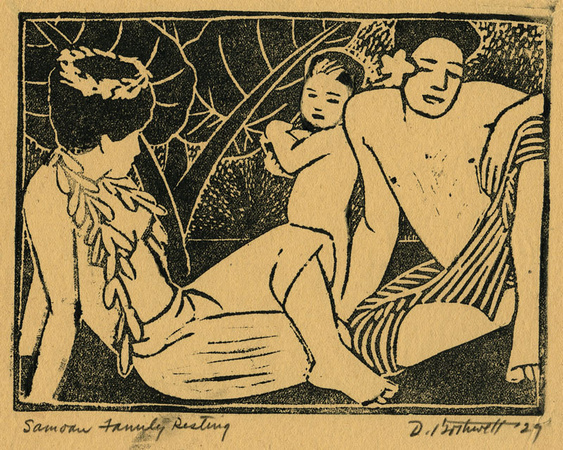
Next morning, early, I went out and made a little sketch of the copra sheds. Copra is dried coconut and then the main export from the Samoan Islands. Almost everybody who had land owned a coconut grove.
My mother hadn’t heard from me since I had arrived in Samoa, and I knew she’d be worried, so I did a sketch on a piece of typewriting paper. I sketched something that looked fairly civilized and sent it to her, telling her in the letter that I was all right and had arrived safely.
I didn’t stay too long with Mrs. Falke. After about two weeks she said that she thought the best thing for me was to go to one of the smaller islands, in the Manua group, because it was old fashioned. There they did tapa cloth work, performed early songs and dances and spoke a very classic language. She said that the high chief and his wife, who was the sister of the last queen of Samoa, and a nice lady, would be arriving soon. Mrs. Falke was related to this woman and would ask her if I could go there. I was delighted because that’s exactly what I wanted—someplace that wasn’t immediately accessible to the Navy or anything like that.
A few days later Mrs. Falke and I went back to Tutuila, where she introduced me to Sotoa and his wife Toaga. Mrs. Falke, of course, spoke Samoan to the chief. I didn’t understand what was said, but Sotoa and Toaga looked at me for a while, sort of up and down. Then Sotoa said something to Mrs. Falke, who told me, “They say you can come over until the ship comes again.”
The Navy didn’t want to bother looking for Samoans who might be lost in heavy seas in their own little boats. So by law, if Samoans wanted to travel, the Navy would take them wherever they wanted to go, on the one ship there, the small destroyer with four mounted guns, the U. S. Ontario.
Mrs. Falke was a big help. She told me there wasn’t any reason to give people money, because they couldn’t use it. She suggested I order a case of salmon, which was pretty expensive, even in those days, and a big container of kerosene for the lamps. Through Mrs. Falke, I asked Toaga what she’d like to have and told her what I could get for her. She was very pleased with that, for the month. It wasn’t over $20 when I was through. But, still, $20 then is like $80 today—especially there.
The Ontario would leave for the outlying islands in two days. I went back and rapidly put myself together again and packed my trunk, which was off the back of my mother’s Chevrolet Deluxe Coupe (Does anybody remember that trunks used to be on the backs of cars?). The trunk was dustproof and long and narrow and more or less waterproof. If I was going to have to take a canoe or boat to get to an out of the way island, I thought that trunk would fit better than a steamer trunk and I was right. The trunk wasn’t burdened with clothes. It contained rolls of canvas and stretcher bars and paints and a couple of coats—I don’t know what I thought I was going to do with those. And some clothes, naturally. Mostly my painting supplies and things I thought I’d need to do some work.
I had some very good letters of introduction that I was supposed to deliver to the governor of Samoa. While we waited for the Ontario, I asked the commander at the station about a governor. There was one, but he was on vacation. I asked if there were any personnel representing the United States—someone that I, as a civilian, could report to. He said, “I don’t know what to do with the letters—you keep ’em.” So I went over to the islands without anybody, except for the Navy, knowing that I was there. It made for complications later on.
Two days later I went back to Tutuila to meet Sotoa and Toaga. I must have looked suspicious because I was carrying a bottle of turpentine. It was my most precious thing—I didn’t dare leave it. I didn’t know whether I could get any more. This was before the days of acrylics—nothing except watercolors, which I had, and oils. I couldn’t paint without turpentine.
I had brought one bottle with me, which was packed in my trunk. I bought a second bottle in Tutuila. Kneuble had emptied out a square Dutch gin bottle, with a long neck, then poured a quart of turpentine into it. What I didn’t realize was that the turpentine would take on the odor of gin.
The Ontario left Pago Pago. We were just deck passengers. That was all the Navy offered the natives and they treated me just the same. It’s a rough 75 mile trip over open seas to the island cluster of three islands called Manu’a. Manu’a means a form of bird. That part of the Pacific has something called ‘deeps.’ The islands are the tips of a huge, extinct volcano, an area with a then unmeasured drop-off to the bottom, which could produce tremendous swells. You could really tell when you went over one. Maybe it’s my imagination, but there seemed to be higher waves and a tremendous feeling of a great swell coming from heavens knows how far up, because the whole motion of the boat changed. We weren’t traveling over the deep proper, but along the edges.
I’m always talking about food, and I don’t remember that we had anything to eat on this trip. Or maybe they did give us water. Maybe they took pity on me and gave me a sandwich. Everyone else brought their own food. I began to realize that you had to prepare for meals, otherwise you’d simply go without.
By then it was getting dark and beginning to rain. There was supposed to be a moon, but it was hidden by clouds. We stopped at the first island, Ofu, which means ‘dress.’ We unloaded lumber there. It was still light enough to see. They just dumped the lumber over board and kids swam out a quarter of a mile or more from shore, grabbed a piece of lumber, then waited for a wave to swim in with it. They were still working with the lumber when the ship pulled out. She just had some cargo for the next, small island, Olosega, and men came out in what looked like a lifeboat to pick up the freight.
It was totally dark by the time we reached Tau, the third and largest island. There were little splatters of rain. By then I was numb. It was cold and rainy. At about three o’clock in the afternoon the trade winds come up and they change. At three o’clock in the morning they change again. They bring in cold air. This was the end of May. But I’m 300 miles below the equator, so it’s the cold season, the rainy season. It was dark, but the moon would come out occasionally.
Quite a lot of supplies had to be unloaded. People were yelling as they got those supplies over the edge of the ship and were getting off. The chief and his retinue were readying to leave. Finally Toaga spoke to me, in broken English. She had been educated in Auckland, but was so mad at the papalagi that she wasn’t about to talk much in English if she could help it. She said, “We go now.” They gathered up their things and we went over to the edge of the ship. I will never forget it. Just about that time they turned on a big searchlight. Every time the ship rolled, the light went up. Every time the ship rolled down, the light shone on the water. It wasn’t like it was a nicely lit scene.
One of the reasons I hadn’t gotten up earlier was because the ship was rolling heavily. We’d had large swells anyway, but now heavy swells came from the island. When I looked over the edge of the ship, I saw what I would have to do—which was to stand on narrow wood slats and climb down the side of the ship on a rope ladder. That wouldn’t have been too difficult, except that one minute, as the ship rolled, half that ladder was submerged in the water. Then, as she rolled back the other way, the ladder slapped the side of the ship.
They had what was called a whale boat—an open dory with eight rowers. The boatmen were yelling, “Jump! Jump!” and people were trying to jump. Well, they don’t care if you fall in the water or not, except it would be dangerous if you fell between the rolling Ontario and the boat, so the rowers held oars out. When people let go of the rope ladder, they would grab an oar and jump. I just couldn’t imagine how you got from the rope ladder to the boat, but some people had already done it.
There I was, properly attired in my gingham dress, with the wind and the rolling ship blowing my skirts up (which must have been interesting for the boys). I think I must have worn stockings—we didn’t do bare legs in those days—but fortunately I had on tennis shoes. I wore a raincoat and held my bottle of turpentine. I tried to explain the bottle of turpentine to Toaga, because she was curious. When I opened it up, she gave me a dirty look.
It came my turn to get over. Everybody else was down in the boat. I gave the bottle of turpentine to the sailor who was standing where you went over the rail. I said, “Hold it for me until I get started down.” When he handed it back to me, I only had one hand to hang on to the ladder. In my other hand was what looked like a bottle of gin. I’d watched to see that you only went half way down the side of the ship, which seemed like an awfully long way down. As I climbed down, the ship gave a tremendous roll over, then rolled back. I was fortunate to have held on.
All I could think of was the Robert Louis Stevenson poem from A Child’s Garden of Verses—“How do you like to go up in the swing? Up in the air so high?”—as I was rolling over. I didn’t try to answer the question.
The oars were slanting in the swell. They were yelling, “Jump, jump!” I knew I couldn’t make it. So I rode up again and this time the ship came down steady at the same level as the boat. One boy pointed an oar towards me. I let go of the ladder, grabbed the oar, aimed for the thwart and just slid. Somebody grabbed me just as I was going over on the other side of the boat.
It took me a long time before I had enough courage to get off that island, because I knew what I had to go through. I still had the turpentine but could hardly pry my fingers off that bottle’s neck.
There were two small boats, filled with passengers and goods from the Ontario. We pulled away from the ship and the men began rowing. One man knelt at the prow of the boat, calling out to the rowers. The water was so clear that he could see the reef down below the water. He gave them directions, which way to row and what to avoid. He was looking for the channel that would let us turn the boat and go directly to the island.
We were rowing parallel to the island and these great swells would boost us way up in the air, then drop us down again. This seemed to go on forever.
This means that the reef comes right up to the beach. Tau is what they call a ‘poor island.’ On the bigger, ‘wealthier’ islands the reef is as much as a half a mile away from the beach. This ‘lagoon’ fills up at high tide and at low tide traps fish—they don’t have to go out deep sea fishing. But on Tau they used what they called a bonito boat for ocean fishing.
All of a sudden the moon came out and everyone sort of heaved a sigh of relief. The boat is rowed so that the swells are along side or under the boat. When that happens, the rowers stop rowing. In the trough of a swell the rowers can row two or three strokes. As they rowed they sang, to keep the pace even. The song indicated when the rowers should pause and when they should row. The pattern was: pause (with oars up)—they sang sangsaiula, a boy’s name meaning “Earflower”: three oar strokes—saiula omai, which means “Earflower bring”; pause-omai tato, which is “Bring us all”; three oarstrokes—omai tato-o, which is “we go.” The entire song said, “Earflower, bring us all the news of government affairs.”
It sounded lovely and I was trying to concentrate on the singing when I suddenly realized that the boats weren’t going up to the shore. They were heading through the opening of the reef—but our boat didn’t make it fast enough! The man kneeling at the prow frantically cried out something in Samoan. Like the rowers, my back was to the direction in which we were heading. I turned around and saw that everybody had stood up and they were jumping overboard. Just then Sotoa yanked one sleeve of my coat off of me. I rapidly changed the bottle from one hand to the other and he pulled the other sleeve off. Then I saw why people were jumping. This tremendous 10’ wall of water was coming towards us.
The chief yelled “Oso! Oso!” which I thought was Spanish. It is, for ‘bear,’ but not for ‘bare,’ which, for some reason, is what I thought he meant. I started taking my clothes off. But what Sotoa really meant was to “Jump!” He jumped overboard. All these people jumped straight into the water so that big wave wouldn’t crash down on them—so I jumped, too.
A few seconds later I came up and there was Sotoa, who reached out and grabbed what looked like a floating toupee. It had a boy attached to it. Sotoa pulled the boy up and shoved me on his back. The boy swam in and when he got to a place where he could put his feet down on the reef, he turned sideways and dumped me off in the water. Without even looking back, the boy ran ahead onto the beach. I came up sputtering. But I found I could touch the ground, so I walked out.
Oh, the moon was glorious. Incredible moon! The shadows of the coconut palms were velvety dark. A group of little girls, five to maybe eight years old, came out to say, “Talofa makaliki, talofa makaliki. Hello, Margaret.” They thought that Margaret Mead, who had left the island about three months before my arrival, was returning, but they soon realized that I was someone else.
All my things arrived in the second boat, which didn’t capsize like ours had. I never saw my raincoat again. But I had kept the neck of the turpentine bottle under the poor kid’s chin, hanging on.
Such was my arrival on the island of Tau, Manu’a, in American Samoa.
Everyone came down to greet the chief and his wife. So we were a large crowd of people walking a fair distance up the road. We came to the chief’s house. I was thrilled to see that they not only had Samoan houses, but also had the best built white-style house I’d seen. It was the same pattern—a sort of family room downstairs and upstairs a large porch with a room behind it.
The chief’s house was built from big metal posts salvaged from a Navy accident. They held a kind of platform and on top of the platform were four walls and a corrugated iron roof. It had a cement floor. They had done some lath in between.
There was a table and their daybeds. They didn’t sleep on them. They sat on them. They were made out of trunks of trees—four little round legs and a wooden platform, and a pile of mats about six inches deep. They slept on mats on the floor.
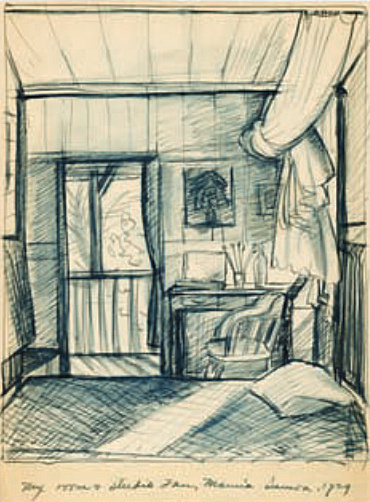
Being Samoans, they preferred to sleep downstairs, so I could use the upstairs room, which, like Mrs. Falke’s house, had a western style bed, floored with planks and covered with piles of mats. At long last I had arrived in a real Samoan house. I didn’t know how long I would be there, but I was really thrilled.
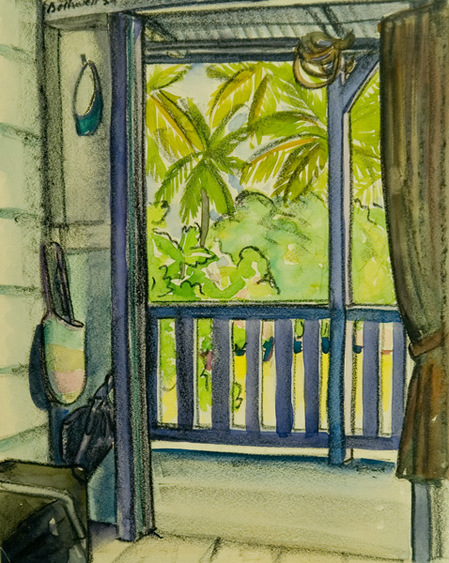
I was also very hungry. I heard commotion and movement downstairs and thought I’d see if any food would be offered. The house was circular, so there was no head to the building, as it were. Sotoa was sitting down, almost by himself. To his right Toaga was sitting and she indicated that I should sit to her left. She was a little distance from him. The protocol was that Sotoa was served first. A food mat was brought in with baked taro on it and a little green package, baked in a breadfruit or taro leaf. I couldn’t quite see what it was. Then two tiny fish on a leaf, fish that are all head and practically no body. But they were protein, at any rate.
There were other foods on the mat. Sotoa took a few things, put them on his mat and ate them. Then the mat first placed before him was moved in front of us and we took things off of that. Finally, other members of the family—I hadn’t sorted them out yet—finished the food. The very last were the people who didn’t sit in the inner circle, but were crouched outside. The mats were passed to them and they ate all the scraps.
Some of the lamps were extinguished and friends came in to talk to Sotoa, others to talk to Toaga. I excused myself and told Toaga I was going upstairs to go to bed. She sent a girl to show me how to undo the mosquito net, which was rolled up and tucked at the top of the posts in such a way that nothing could get in. There was a certain way that you had to get it down. The girl showed me how to fix the net so there was no chance of any insects—mosquitoes mostly—climbing in. With the end of this day and with a full stomach, I climbed onto the mats, went to sleep and never moved ’til early the next morning.
Later I discovered that you don’t lie down in the bed without putting the net down. The idea was that there were no divisions, no rooms, no walls. There was no way to have privacy except where your bed space was. It was hard to see into the mosquito netting, especially during the day, and that was the sign that you wanted to be left alone. If people looked in the door and saw the mosquito netting down, they did not disturb you, because that was the sign that you were either sleeping or reading or eating or making love or something. In other words you were not available to be visited with.
For breakfast they ate food warmed up from the night before—some fish, taro and one of the little green packages, that tasted like a coconut cream custard in spinach leaves.
Then Sotoa and his wife left, to visit other villages to get all the gossip—leaving me with 14 people in the family and no one who spoke any English. Right away I tried to learn some words.
Nothing to drink was served at the meal. I was very thirsty and made drinking motions. A boy climbed a coconut tree and brought down a beautiful yellowy-orange unripe coconut. He was about to open it with his knife, when I shook my head no.
Then this older woman, a cousin, decided she was going to teach me things. She’d poke me and say, “Inu.” And I’d say, “Inu.” That was “drink.” Sinu inu was “a little drink.” Then you’d have to say “fa’a mole mole,” or “make smooth your heart,” which is the equivalent of “please.” “O mai” was “bring me.” “O mai sinu vai inu” was “Bring me some water to drink.” And they run everything together. For a long time I thought “fa’a mole mole omai sinu vai inu”—“Please bring water to drink”—was one word. The Samoan language is a real job and I never attempted to master it.
She got a key, carefully unlocked a cupboard and picked up a glass. I looked in the cupboard. There were four glasses, some of them chipped, none matching. I suddenly realized how precious fragile things like that were on the island. She disappeared out of the house and came back with a glass of water. I held it up to the light and it was clear. Nothing seemed to be floating in it and it didn’t smell, so I drank it. The water tasted fine.
I carefully handed the glass back to her. She waved the glass in the air, put it back in the cupboard, locked the cupboard door, and hung the key by the post right by Sotoa’s bed.
I unpacked my trunk, took out my easel, and went out to paint—and made the unhappy discovery that because of the humidity, which is generally 90 percent, all my watercolors had flowed out of their pans and were mixed. Luckily, I could still use them and I also had tube watercolors which were okay.
I got my sketchbooks and began doing drawings of the people and plants and everything else. I drew a lot of people. I was always very careful to ask their names and write them down. Some of those drawings I did in red chalk—a few are in the San Diego Museum. Altogether I think I have about 150 drawings, most of them mounted in pairs. I worked hard.
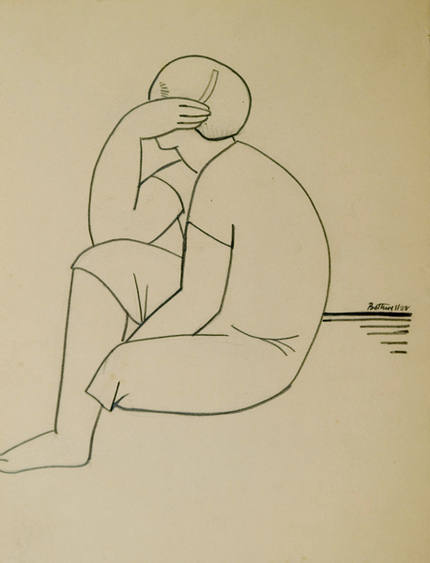
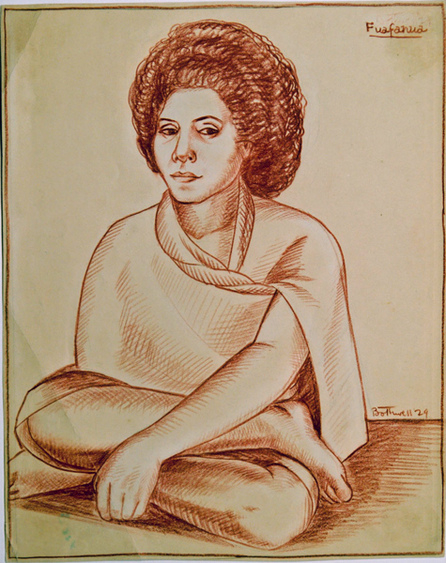
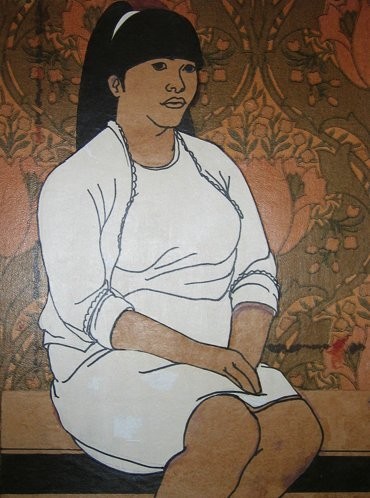
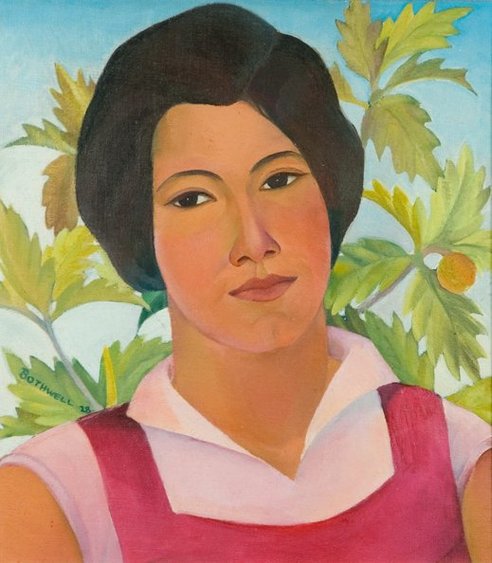
One of the things I just loved about the Samoans is their terrific names. When a Samoan child is about to be born, especially if it’s a first child, all the relatives gather around—the girl isn’t alone. There are always two busybody old ladies watching. If it goes on for a long time, they talk and have something to nibble on, maybe sugar cane. One woman is doing nothing but listening to the conversation. The moment the child’s head appears, whatever word was said at that moment, is that child’s name. I knew a boy named Sua Esi—“strange soup”— because one of the old relatives there was tasting soup. An awfully nice man was named Togi Manu. Manu is bird and togi means to fly up suddenly. His uncle was coming to see if the child was born yet and he went underneath a tree, touched the branches, and the birds flew up. Just then the child’s head appeared, so the old woman watching said togi manu.
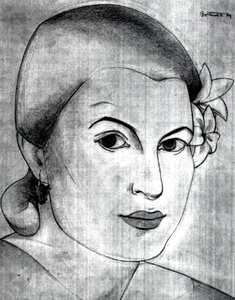
The name of the woman who tried to teach me Samoan was Uaialu. When a tremendously high wave hits the reef, which is like a shelf stuck out, it makes a hollow pounding sound. That term is uaialu. This child was born just as a tremendous wave hit. A girl was named Uaialesi, which is “wireless.” Somebody said, “Turn on the wireless.” The kid was born.
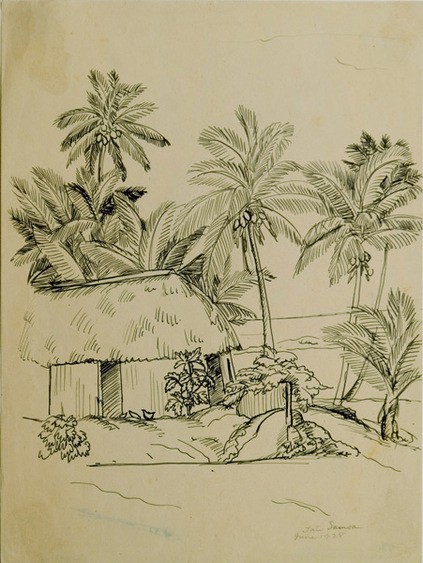
There was no doctor on the island. The sanitary inspector was supposed to come overevery six months. After I was there, it seemed like they came over every three months. There was a little white house with a dispensary that he used when he treated people. Mostly they had sores and abscesses. A lot of it was yaws, which was actually a dietary sore and could be cleaned up. He wasn’t a doctor, only the sanitary inspector, a Chief Pharmacist Mate in the Navy. When the radio said that he was coming over, all the pigs were penned. They checked everything.
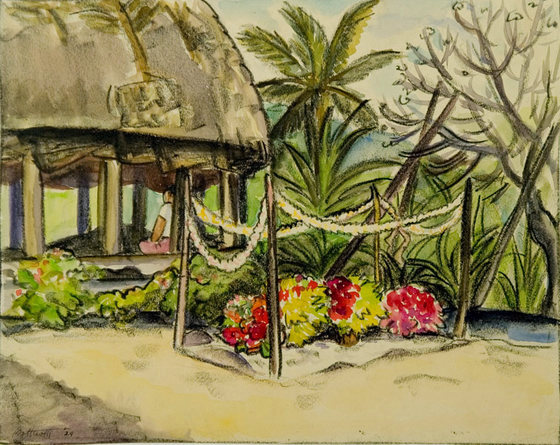
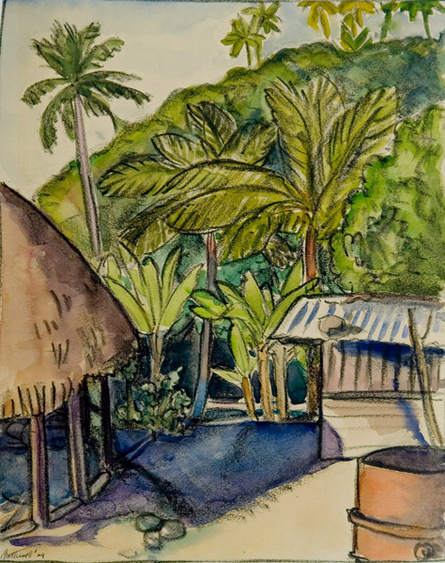
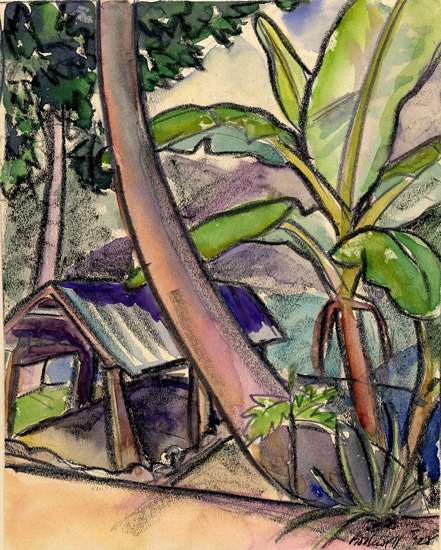
They had mosquito nets for the three varieties of mosquitoes. One variety carried elephantiasis. It was enormous, but that kind seldom came down from the bush. The best workers, the ones who worked in the upper taro fields, were the people mostly bitten by them. It gave them something like scarlet fever, then they would peel after that. If they could get as far away as, say, Honolulu, before the lymph glands began to obstruct, they could get it out of their systems. The terrific humidity in Samoa kept them from drying out. It was tragic, because some of the smartest kids would get it.
We had communication with the Naval Base via radio. Remember, this was in 1928. The first crystal sets—‘cats whiskers’—came in 1925. Eleven o’clock every morning they cranked up this radio and it gave them three minutes of conversation. They could send the first minute and the Navy people took the last two and gave information and directions. They would tell them if somebody was coming over, so everybody would be ready. If the destroyer was coming, you sat down and wrote letters like crazy. A plastic ziplock bag would have been ideal, had they existed, but we wrapped the mail in anything that seemed waterproof, because those were open boats and it could be pouring rain.
One time dysentery broke out on one of the other islands and we were marooned for four months. This meant that the Ontario would not visit us until all the danger from the disease was over. We ran out of all kinds of supplies. I had my drawing paper and needles under lock and key in my trunk. I’d lent someone a needle and they had to sit right there and sew. You couldn’t get anything like that—it was tremendously valuable.
They ran out of matches and went back to the old way of rubbing pith with a fire-sharpened stick. It doesn’t take long to get down to basics.
Samoans didn’t seem to have many holidays. Christmas was celebrated in the school and in the church, naturally, but not necessarily by anything in the peoples’ houses. No special decorations. I don’t remember that Easter was celebrated at all. They may have had a special service at the church. My attendance at the church was somewhat spotty. I didn’t go every Sunday, so I might have missed something.
The big holiday, called Flag Day, occurred in July. It didn’t have any relationship to the Fourth of July. It just happened that July was a good time to go to the big island. What they did was to start training bands of dancers. Each village and each island had a group of dancers that worked out different kinds of dances. They also worked on songs, because they would sometimes sing a so-called sitting dance, plus gestures in the air.
They had individual dances, like men’s dances, dancing with incredibly razor sharp knives that were a form of machete, with a sharp hook. The knife was about 2’ to 3’ long, a real weapon. They had a knife dance that I could barely watch, especially when they swished the knife and the other person jumped up in the air. If his timing was the least bit off, he would have practically had his legs cut off. However, they had a wonderful sense of rhythm and timing.
There were drummers, whose drums were made out of square tin gasoline and kerosene cans. The cans were filled with sand at different levels, laid on their sides and beat on with narrow sticks. It gave them different sounds in beating, usually three-part rhythms. The main beat was the main high drum and the other two were the middle drum and the very low booming drum. Each drummer had a different pattern but together they made this incredibly complicated beat.
I had studied dancing all my life, so I picked up the dancing and learned the story behind each hand motion, which Margaret Mead hadn’t learned. I concentrated on that. Toaga helped me by translating into English, so I more or less knew what I was doing. The Samoans have no patience for teaching the dances, so one learns by trial and error. A spirit of infectious gayety marks their lives. They have a gorgeous sense of sheer fun, and make jokes out of everything. A man will make a joke even about his own physical disability. Perhaps he has lost a leg. During an evening’s entertainment, when his turn comes to dance, he will improvise a dance which he calls, “Fish with One Fin.”
And everybody sings. A small boy might be walking down the main street of the village and he starts to sing. Immediately there are voices from within the houses who harmonize with him, until it seems as if the whole village is singing.
But because of the dysentery, Flag Day wasn’t in July the first year I was there, but delayed until September. The family and I went over to Tutuila and I discovered that gossip had been busy. The wives of these officers had nothing to do. They would either be having affairs with other officers or with Samoans or with sailors, and there was a lot of gossip. Toaga was the first one to find it out, because she could understand English.
The governor of Samoa, Commander Graham—who had been absent when I first arrived in Tutuila—had returned. His aide-de-camp, George Peters, was a half caste, more white than Samoan, and very sweet. He came over and talked to Toaga. She got very angry and spoke with her husband. Sotoa had a finely braided fly switch, a sign of rank, made out of sinnet, which is the insides of a coconut. It hung over his shoulder. When he was upset, he would switch it around. I could see him switching it. Then he got up and left with George Peters. After a while Peters returned and said, “The judge of American Samoa want to see you.”
“I didn’t know you had a judge.”
“Oh yes,” he answered, “We have a judge.”
So I went to the Naval Base. The officers were there in their white uniforms and white shoes. Sotoa was standing next to George Peters, who was translating. Sotoa spoke very elegant Samoan, but no English whatsoever.
The judge, Commander Fox, said, “Okay, George, you can leave now.” All of a sudden I was left with this man whom I had never met before.
Sotoa looked distressed. Sotoa must have weighed about 350 pounds. He was a good six feet two, with big bones—an enormous man, with a short gray haircut. He was in his ‘60s but in good condition.
The judge said to me that I’d been there since such and such a date.
“Yes, that’s true,” I replied.
“You’ve been staying with Sotoa and his wife Toaga?”
“Yes.”
“Did it ever occur to you,” he queried, “to ask them if they would like you to leave?”
“No, it didn’t.” I said, “I paid them what they wanted.”
“What did you give them?”
“Well, I gave them kerosene and a case of salmon and two cases of pisupo (A Samoan name for corned beef that comes from New Zealand).” I knew that I had over paid them. There was no question about that.
He said, “Umhumm, but did it ever occur to you that you might not be welcome in their home?”
It just hit me. I hadn’t had any kind of emotion. I was living in a dream and I started to cry. I couldn’t even answer. The tears spurted out, then Sotoa leaned over and with his great ham-like hand patted my knee and said, Mama oki? “Your mother die?”
And I thought to myself, “Sotoa hasn’t said anything. This guy’s just picking on me.”
I told the judge, “I would like to talk to Toaga and George Peters. Also, you were not here, nor was the governor, when I wished to present my credentials. I have them now. Here they are. I would like the governor’s ADC to take them to the governor.” I wasn’t going to let this guy read them. I said, “Would you call George Peters?” He called Peters, “George, take these letters to the governor.”
I had letters recommending me from the City of San Diego, the California School of Fine Arts, the San Francisco Society of Women, Rudolph Schaeffer (who signed his letter ‘Professor of Rhythmo-Chromatic Design) and others.
After Peters and the letters left, the judge said to me, “I’ll keep in touch.”
The next thing I knew I was given a slip of paper saying to prepare to board the next Matson ship that came in—to leave! I was being deported! Toaga was furious, because she’d been around the storekeepers and heard the servants’ gossip—which was that I had been living with a native, that I had been pregnant, that I had a child, that I had drowned a child! Incredible stuff!
I came over with a whole exhibition of paintings ready to be shipped to San Francisco. I really was angry. I thought, “If the governor demands it, I will open these packages and show him my work.” But I really didn’t have to.
Sotoa was the head of the Manu’a island group and had originally been the chief for the last king of Samoa. The king of Samoa had never been crowned king and when the Queen of Samoa went back to Auckland, New Zealand, the king was deported, because the New Zealanders didn’t want any trouble. The Samoan King had two counselors—the counselor of peace, who spoke first, and the counselor of war, who spoke second. Sotoa was the traditional counselor of peace. Next to the king, you can’t get any higher. He married the sister of the last queen of Samoa, so he had a double whammy there. His wife also had a certain degree of rank.
Toaga wrote a note, called George Peters (who’d never been so busy) and sent this note to the governor. Back came the governor’s big limousine with chauffeur and George Peters riding in it. The governor wanted to see Toaga right away. He realized that something was wrong. George Peters translated and Toaga told the whole story. She said that they were Christian people, that this was a slur on their family name, and that they would never have had such a creature—as the gossip had made me—under their roof!
We’d come over for Flag Day with about 150 dancers and many people from all three islands. Toaga said neither she nor her husband nor any of their entourage would leave until they had an apology. As for my being shipped out against my will, they absolutely protested that order!
Sotoa and Toaga came back and sat tight on Kneuble’s store porch. In the meantime, the judge of Samoa called me in again and said, “You’re not going back with them.”
“Well, I have to. I have all the work of a year. Part of it is ready to be shipped. It’s going to be shown in a museum.”
“No,” he replied, “we think it better if you don’t. You’re a disturbing element.”
“I didn’t disturb anybody. I certainly didn’t disturb Sotoa and Toaga.”
I told him I was doing work for the Bernice P. Bishop Museum in Honolulu. I had written to them about their analysis of Samoan designs. I was doing measured drawings of the hand-painted siapo mamanu and hadn’t finished my drawings yet.
Well, the Bernice P. Bishop Museum sort of rang a bell to the judge and just then George Peters came in. The two men had a little conference and the judge backed off—his decision had apparently been overruled by the governor.
The contract Samoans had with the American government—not just the American Navy, but the Navy representing the American government—was that any Samoan, as long as he abided by his promise not to use his own boat, had to be given passage on U. S. Navy vessels. That’s one of the reasons why the Ontario was there, to take Samoans back and forth to their different islands.
Sotoa and Toaga felt that the only certain way to prevent the Navy from forcing me to leave was to make me a Samoan. All I had to do was to be tattooed with the chief’s pattern. Tattooing was forbidden on the island of Tutuila, so that night I went to a smaller island and this design was tattooed on my legs, Samoan style—which not only made me part of the family, but also gave me property in Samoa and a name.
It was painful, but I did it. Two or three or four W’s is the best description, over a series of short strokes. Sotoa’s family symbol was the bonita bird. When the bonita fish run, a certain kind of bird appears that feeds off the schools of fish. So his symbol was this bonita bird, and the little dashes represent the fish.
I was given a beautiful Samoan name: “Soai fetu.” “Soai” means companion. “Fetu” is a star. So I was named Companion Star and made a Taupo, which is the title of the chief’s hostess, who is hostess as well for the entire village and must make the ceremonial drink of kava and perform the siva, or native Samoan dances for the chief’s guests.
After nine months I had learned to speak the language— somewhat! I wore native dress—a lava-lava, which is a two-yard length of cloth wrapped around the waist and falling below the knees—and a short sleeveless blouse. Bare feet. I lived on native food: taro, breadfruits, boiled green bananas, fish, and when there was a feast, chicken and pork.
Toaga said that if there was any further question about me, they would point out that I was now a Samoan. So the Navy had to let me go back to Tau.
But even with the tattoos, I wasn’t sure what to do. If I went with Toaga and Sotoa and their party on the Ontario, I thought there could be a confrontation. After all, it was a Navy ship—they might refuse to take me and I would be left at Tutuila. If I was then deported, my whole year’s paintings, all packed and waiting to go, would be left on the island. I was really distressed. It was a difficult thing to explain even in English and I certainly couldn’t do it in Samoan.
I heard about a copra launch, maybe 15’ long, that went around the islands and picked up copra. It had a small housing where the steering wheel was, with room for two people standing. Curved covered hatches protected the copra from getting wet. There were four young men on the launch who were going to Ofu. So, for a reasonable sum, I decided to go with them. It was really foolhardy. I just was not thinking clearly. But I jumped on and that was it.
I had no food, but fortunately had several drinking coconuts, so at least I wouldn’t suffer from thirst. By that time I was used to missing meals so this didn’t bother me. I didn’t let myself think about rainstorms or windstorms, even though we were going 75 miles on this little chip of a boat.
I grabbed a post, because the curved hatches were very difficult to balance on—when the boat rolled you were liable to roll right off the boat—and held on tight. The trip took 17 hours. I was invited into the little cabin where the captain and the navigator were, but the captain, who was part German and part Samoan, had been drinking beer steadily. I didn’t want to get into close quarters with him, so I elected to stay on the hatches along with the young men, who finally grabbed onto the edges of the boat and spread out. We had to cling to the hatches, exposed to the lightning and pelting rain. A shark followed us hungrily all the way, as the dot of a boat rose and fell with the giant black waves, shutting out our view of the sky when we were in the trough. It was a medium-rough but not a dangerous trip that way—only I was worried that they might not remember how to get to Ofu. However, the young half-caste navigator carefully watched the compass and the stars after it got dark.
We finally got to Ofu about dawn the following day. I had to get somebody to help me unclasp my hands. They wouldn’t obey me and stayed tightly gripped on the wood. They had to loosen them one by one so I could finally sit up.
An outrigger from Tau came to Ofu to take me off the launch. The boats were made of hollowed-out tropical hardwood, very light, with quite thin sides. Two pieces of large bamboo had been bent into an arc and lashed to another piece of wood and that acted as the balance. Even so, they had a great tendency to roll over and I had heard that a passenger should sit absolutely still, because even a chance fast movement of their head might tip the whole thing over.
At that point I had no desire to fall into the ocean. So I waded out and carefully got in the middle of the boat. You had to sit cross-legged. I hung onto my ankles. Somewhere along the line I had lost my hat. It was a bright sunny morning. I lowered my head and closed my eyes and just sat.
One paddler sat at the bow, another at the prow. They had to do fast movements. They would do quick dips and paddles, then change over to the other side. They had to keep the boat steady while we went with the ground swells that passed underneath us, then maneuver a sharp right-angled turn— they didn’t really need an opening in the reef except that this also broke the rhythm of the rolling swells of the ocean and let them get on the back of the wave. When we came in I could feel the air just rushing by me, at express rate, and we arrived safely.
I had to be helped out of the boat because I was really stiff. I waded in and walked to Sotoa’s house. There wasn’t a soul there. I climbed the stairs and just threw myself down on the pile of mats. Of course, nothing goes unnoticed in the islands, so within minutes Uaialu appeared. I could see her looking through the railing to see who it was.
I waved and pointed to myself and said “Soai fetu.” She smiled and went down the stairs.
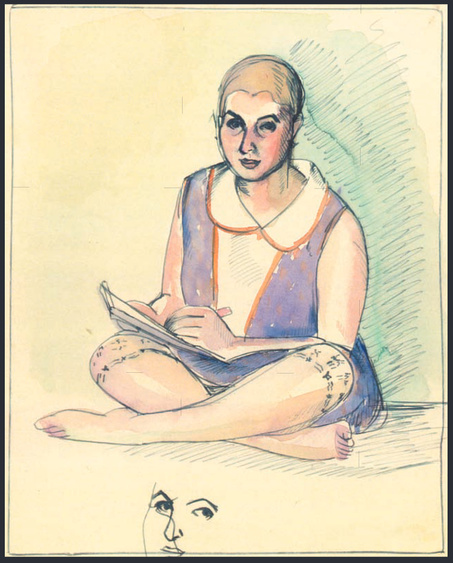
Sotoa and Toaga returned the next day. The Governor had asked their pardon and Toaga had forgiven him. They thought nothing of my leaving, because it was a typically Samoan thing that I had done.
The three islands of the Manu’a group are all that is left of a mountain that once surrounded a huge volcanic crater. The only flat spaces were the beaches and three to five hundred feet of land behind them. The villages were built on this piece of earth and backed up closely to the mountain, which gave them some shelter from the trade winds. The coconut and taro plantations over the centuries had developed into not true terraces, but little flattened shelves on the mountainside, where workers climbed steep paths to work in the gardens. The coconut plantations needed great care.
The few books that I’d read on the South Seas—there weren’t many written—gave the impression that the islanders were indolent, had no daily pattern to their lives and just sort of played and slept, day after day. I soon found out that was not the case. Contrary to popular opinion, the Samoans were a very diligent people. They awoke at 4 am in the morning and climbed the hill to go to work in the fields, eating nothing until 10 am. After a siesta, they returned to work until 6 pm.
On moonlight nights the chief policeman made the rounds and ordered the people to work, tossed a tune of a weird chant or song. “Why are you sleeping? It is a beautiful night, the moon is shining brightly—get up and work!”
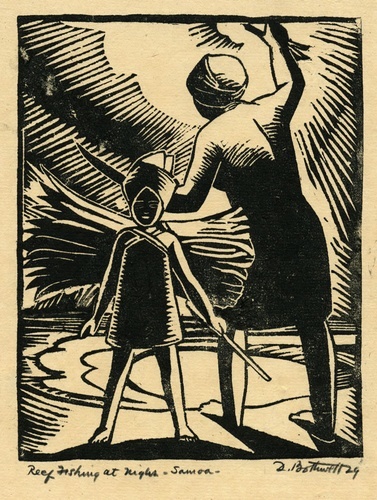
The servants in the house also had to be up early, to prepare the oven to bake the food, which generally took about three hours. A big depression was dug in the back of the yard, where they built a fire. They carefully laid rocks on top of the fire, putting them in order to make a rather smooth layer. They fanned the fire to keep it going and occasionally would splatter water on the rocks to see if they were hot. After they began to sizzle another layer of rocks was placed around the edges, until they splattered, too. They made tongs out of green palm branches, bending them in half, to be able to pick up the hot stones.
Women would carry out baskets that held taro root, all washed and cleaned with the ends cut off. Taro roots are shaped like yams or sweet potatoes. I never saw them with the ends on, and now that I look back at it, I don’t think I ever saw a freshly dug taro, either. The Samoans can’t say ‘r,’ so in Samoan that was a talo. It took me a while to get used to that.
They put the taro down, together with fish folded into big taro leaves and a banana leaf was wrapped over that. Some of the fish was wrapped in young taro leaves and tied with strips of banana leaf, which made those little green packages of food.
With the tongs they lifted up the hot rocks at the edge and put them on top. Above that they laid green banana leaves, then placed clean gunny sacks on the banana leaves. Finally, some green palm leaves were placed on top and the oven was done.
When the workmen came back from the coconut plantations, they showered and put on clean clothes, then sat down for the first meal of the day. They had probably worked four hours before they ate their breakfast, so afterwards they took a short nap. That is what I think most those writers misunderstood as laying about and being indolent. The mosquito nets were not put down during these naps, nor did they use a blanket or covering. They simply lay down on a pile of mats out of the direct wind.
Later in the afternoon, but well before sunset, they would go back for the second half of the day. They put in a good six to eight hours of work, depending on the weather. They were not lazy. When they came back, they again showered, put on another fresh lava lava, and ate warmed up food for their evening meal. No food was ever eaten as a cold leftover, particularly anything with meat, but also vegetables. Everything was put in the oven again and warmed up. It was a quicker, faster fire. Because everything was cooked it didn’t take as long. The evening meal was warmed up food that had been cooked in the morning, making sure that nothing had spoiled, with no danger of upset stomachs.
It took me a long time to get adjusted to only eating twice a day and eating large amounts of food at a meal. Normally, when I’d come to a slow place in my painting I used to have a cracker or a cookie or something to nibble on while I was trying to make up my mind what to do. So I was accustomed to eating little bits all through the day. But that was absolutely impossible in Samoa. There was absolutely nothing to nibble on.
Being so close to the equator, we had 12 hours of daylight and 12 hours of dark. Depending on the season, the dark generally seemed to start at 5:00 or 5:30 pm. There were no lights anywhere, except for the lamps lit inside the Samoan houses or if somebody walked along the road carrying a lantern. They had old-fashioned commercial lanterns that used to be hung on caution signs for street work in the United States. Farm lanterns, we called them.
At supper, after Sotoa was served food by himself, everybody bowed their heads and clasped their hands. Sotoa would give a prayer in Samoan. Missionaries belonging to the London Missionary Society (a branch of the Episcopalian Church) had converted this particular island. Its service had been carefully modified for this simplified way of living.
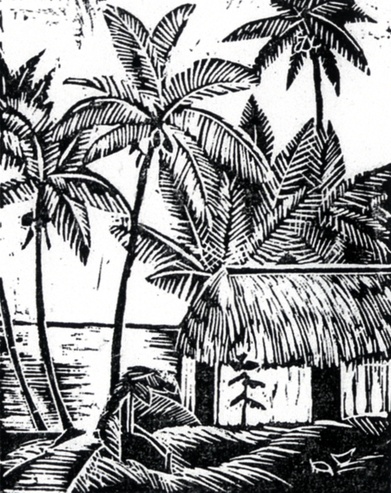
There were a number of churches and Samoans joined them for various reasons. They liked the London Missionary Society because it ran the schools and taught the Samoans how to read and write and had the Bible printed in Samoan.
The Catholics were runner-ups. They were very popular. First of all, they gave everybody a handsome medal to wear around their neck. Secondly, people were permitted to play cards and dance on weekdays and do some things even on Sunday. Some Samoans belonged to all the churches in the islands. The Seventh Day Adventists were popular because you could go to church on Saturday, then go to another church— the Catholic Church, the London Missionary Society or the Mormon Church—on Sunday.
The Seventh Day Adventists were great on teaching gardening and different ways of cooking. The Mormons taught the Samoans how to run their plantations.
Almost every big family had a plantation of coconut trees. Behind stone walls were a few pigs to route out insects that might damage the trees. The walls also kept the pigs out of the taro gardens.
Every family had a breadfruit tree, which wasn’t in season when I arrived, so it was a while before I saw how they were used. I saw banana plants and papayas and pineapple bushes everywhere. But I never saw anybody eating fruit. It was some time before I could find the words to ask the question, but I was told that children ate the fruit. When a lot of bananas matured at the same time, they would bring a bunch of bananas into our house. If it was inside a house, the children didn’t steal it.
If the fruit was in the gardens, the children stole most of it. It was the only kind of pilfering that I saw, except for certain things the children couldn’t get at. Something with sugar in it was a terrible temptation to a child. Things that we might think had some value, like a watch, for example, they weren’t interested in. Their diet was certainly plain and they simply could not resist anything sweet, like a jar of jam. The jams were always put away under lock and key in the cupboard.
After the evening meal they generally played simple card games, usually something called Sweepy, which depended on cheating the person and making them believe that you didn’t have the card that you held. They’d put their cards down and the person holding the concealed card would suddenly bring it out and sweep the other cards off. I don’t think they gambled for money because they didn’t have money. They didn’t have very many things. They just played cards to be doing something.
So there really was a pattern to their lives. And it was not a lawless life. People could choose their vocations. Not everyone wanted to garden. Some people were expert at deep-sea fishing, which meant using the bonita boats and going out into the ocean, beyond the reefs, to fish. The fish beyond the reefs were huge. Bonita are related to the tuna. When one was caught the whole village would feast. One man, and strangely his wife also, fished in the deep water. He never gardened, and neither did she. People traded them food like taro in exchange for fish. I think most villages had at least two fishermen who went deep-sea fishing.
The little outrigger canoe was used for fishing in the shallower water. The fish caught there were the small ones, little one-mouthful fish.
The only time we went out to the deep-sea was to go to another island of the group. Olosega was the closest to Tau and we went there in the whaling boat, with the rowers. The boats were stored upside down and covered with palm leaves. They were very valuable, because that was the islanders only escape hatch if they had to get away.
I went to Olosega once. After we had landed there, we walked over to this kind of a strait and I discovered, to my horror, that I was supposed to swim it. I don’t think I ever swam two miles straight ahead in my whole life. Most swimming pools you go up and down—unless you’re training for the Olympics—you don’t swim two miles! It wasn’t high tide and, of course, the water is very buoyant. It was so warm I really began to sweat. I gave all my things to the boys, who put them on their heads and swam with their heads up above the water, which was really incredible. Can you imagine doing that for two miles? Well, I made it. Again, I thought twice about coming back. I thought maybe I’d spend the rest of my life there, but I swam back. The tide was coming in and we went faster because it was carrying us in that direction. We were swimming against it going out, which made it tough. Every experience I had changed my mind about traveling.
As the year went on different things happened.
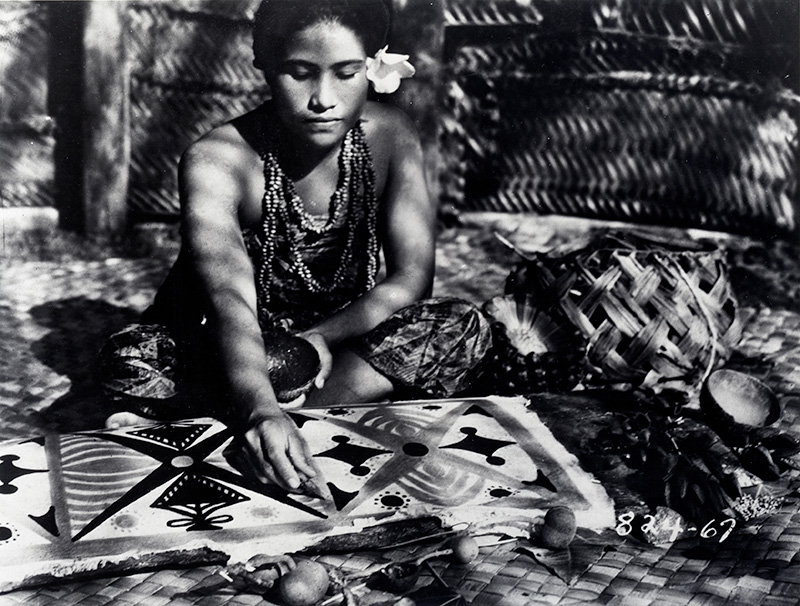
The making of tapa cloth was fascinating to me. The two things needed to make tapa cloth were mulberry plants and arrowroot. The paper mulberry looked like a kind of shrub—I guess it never had the chance to grow because as soon as it got a certain size the bark was stripped off. That was soaked in salt water for days. Finally, the outer part would rot off and very carefully they would peel the various layers out until they had a cobwebby sheet of fiber. A number of these fiber sheets were glued together to make something heavy enough for the tapa cloth.
For glue they used the root from the arrowroot plant. They peeled the root and rubbed it over the mulberry fiber sheets and put the fibers together. A piece of tin or wood and rocks were used to press the sheets together and these were left in the sun. The sun didn’t touch the fibers but it heated the boards and that way the sheets were glued together.
There were two kinds of tapa cloth. One was printed from a wooden block. The other was hand-painted. Getting to the point where they could either paint or print the tapa cloth took two or three weeks of endeavor.
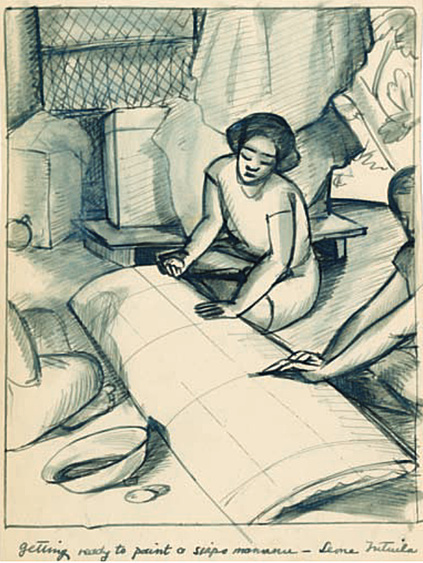
The hand-painted tapa cloth, the siapo mamanu, was probably the oldest of the arts practiced in Samoa. It was interesting to watch. They used a large curved board, probably 4’ to 5’ long and maybe 1’ to 2’ wide. They lightly adhered the tapa cloth to the board by dabs of arrowroot starch so it wouldn’t slide around. Then they chewed the pointed end of the nut or fruit of the palm to form a brush. They dipped this brush in one of the plant dyes and drew the grid pattern that would contain a design. There was always one person in charge, although they probably discussed what type of pattern they were going to use. They could invent patterns, too, but generally the grid background arrangement was more or less classic.
The printed tapa cloths were made by using a wood block carved from a piece of wood from a camphor wood chest that had fallen apart. It was carved like any other block and was about 10” by 20” in size. The block was fixed in some stones flat to the ground, with the carved side upwards. The dyes were painted on the carved face of the block, then the tapa cloth was carefully lowered on top of that, held firmly and rubbed so that the design was transferred. That’s the reverse of what we generally do, which is stamp the paper or cloth with the block.
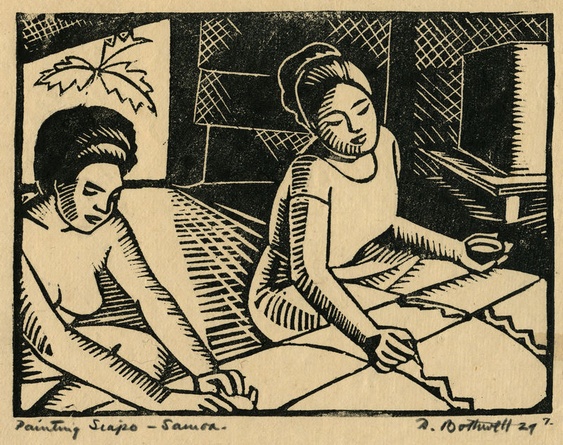
After the design had been printed, it was allowed to dry a little. Then outlines were painted on the stamped design. Sometimes bits of it would be over-painted to make a different or darker dot or darker line. They did a considerable amount of work. Almost all of the tapa cloths, whether hand-painted or stamped, took about a week to finish.
The reason I was in Manu’a was because the Samoans still did things in the old-fashioned way and were seldom visited. The only ship that ever came was the Ontario and the Navy didn’t bring tourists over. So there was no incentive to make tapa cloths to sell—they were mostly dowry cloths or part of the family treasures.
When I saw them printing the cloth, I suddenly remembered I had brought some linoleum blocks. I had tucked them in the trunk at the last minute, thinking it would be a wonderful idea to make some blocks from some of my sketches of various activities. The first block was very small and I just tried my tools out to see how it worked in the dampish weather. It worked all right, so I decided on my design. I had not done much work since I’d come back from Tutuila, with all the upsetting activities there, and was glad to begin something new. I had paper and ink, so for the next month I worked cutting blocks and printing them on paper, until I had a nice collection of Samoan linoleum block designs.
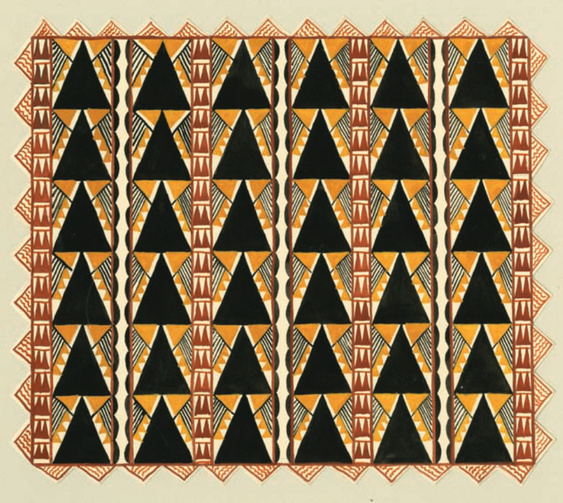
Those drawings of tapa cloths are collected in an unpublished monograph that is owned by the Bernice P. Bishop Museum in Honolulu. But I don’t have any letters after my name as an anthropologist, so the measured drawings I did of the printed and painted tapa cloths are good as far as an artistic job and for those early dates. But unless it has an anthropologist’s writings and descriptions, they would only use my description and put it in their own words—then it would be published. The manuscript is getting more valuable because those tapa cloths described what was being done in that isolated group of islands 70 years ago.
This was the time of incredible growth of the breadfruit trees. I never saw them blossom, so I don’t know what happened there, but a fruit quickly became the size of a green tennis ball on a very thick 7’ or 8’ long curving stem. It ripened and enlarged rapidly and within two or three weeks some of the trees had fruit that could be eaten.
They would pick the fruit, now the size of an overlarge soft baseball, maybe 4” in diameter. Then, using a sharpened coconut shell, they scraped off the green rind until the inside was kind of white. That was cut or broken in half and baked. What came out tasted like very dry mashed potatoes. Not quite a potato flavor, but that mild flavor that mashed potatoes have—you can’t quite describe it.
As soon as the breadfruit was ripe enough to eat in large amounts, a ceremony commenced. A special recipe was used by the men and the utensils were special hand-carved hardwood bowls. The breadfruit was mashed down, then baked and rolled into little balls. They took a big oval wooden dish and filled it with juice from the coconut. The coconut meat was not as hard and dry as we see it here. They used a softer stage of the coconut, which was grated, put in a fiber cloth, then the juice squeezed out. It came out looking like very thick white cream. The breadfruit cakes were placed in the bowl with the coconut milk and served. It looked like kind of a lumpy pudding with a cream sauce and tasted very good. It was not sweet, because although the water used to cream the coconut was salt water, the breadfruit roasted quickly and tasted a little smoky.
They sang a special song. The boys wore small green banana leaves tied around their hair, then a collar and necklace of the shredded banana leaves. Over their lava lavas they had kind of an extra skirt of banana leaves. This wooden dish was a couple of feet long and maybe a foot high. They marched in carrying the bowl up high and sang a song.
One day I was rummaging in my trunk and I noticed that I was almost at the end of my art supplies. That set me back on my heels and I realized that my visit to Samoa was drawing to a close. It was early June and I’d been there just over a year.
At the beginning of July it was time to go to Tutuila for another Flag Day. We felt free to go because Judge Fox was gone and by then Governor Graham and his wife had also left.
But when we got there, Toaga received a letter from a relative in Apia, in Western Samoa. She felt we should go there, so we just kept on going. We took a small boat—you couldn’t call it a ship—with gasoline engines, but larger than the copra launch, called the Lady Roberts.* It had a little tiny shelter at the stern and little benches we could sit on. I really disliked the fumes of the gasoline engines, which made me a little queasy, plus it was a long and rough trip. A number of people were seasick and that didn’t help me any either, but I was able to eat a sandwich.
*The Lady Roberts became famous in the 1960s when she was found floating, in good shape, without anyone on board (like the famous Marie Celeste). She had a little cabin and in the cabin the dishes were set for breakfast. The mystery was never solved.
Apia was like the Naval Station at Pago Pago, without the Navy. But were more stores, some called general mercantile, with anything from bolts of cloth to kettles to fishing rods to hammers and nails for sale. They had a draper who specialized in fabrics and I found some fabrics that I’d been looking for. They were white and one color, such as white and red designs, or a red background with a white design, large patterns, like the clothing worn by people in Tahiti that Gaugin had painted.
We stayed with Toaga’s relative for a month. One day, to my amazement, I met someone in Apia who I knew, a man I’d known slightly in art school. Since then he’d married. He and his wife were staying not far from us. He said, “You must go see Robert Louis Stevenson’s monument up the hill.” (Robert Louis Stevenson lived at Vailima in Upolu during the last years of his life and is buried on Mount Vailima).
He also said that the river near where they lived had a good swimming hole. That sounded good to me, because the weather seemed much warmer in Apia than in Tau.
I visited these people and we had paplangi, a regular white-style lunch, which was a real change for me. They had a green salad. Lettuce came to the Naval Station but it was very precious and you didn’t just casually make a big lettuce salad with it.
I suddenly realized that things I had been doing without were getting more important to me. As I talked to these people, I knew that I should think seriously of finishing my paintings and get ready to leave Samoa.
We got back to Tutuila just in time to catch the Ontario going to Tau. The ship was carrying a stove, for the pharmacy house. It was interesting to see how they unloaded it. They didn’t often have heavy things such as a crate containing a stove. As the crate was lowered over into the boat, part of the box fell apart, and the stove lids and oven door fell into this deep water. The boys dove for them but were only able to bring up the stove lids. The next day they found the oven door, which took considerable diving. The boys had to carry weights to make themselves go down deep enough and they could only stay down for a short time. We awarded each diver with a can of salmon because they worked so hard.
The season for gathering the fallen coconuts to make copra had begun. All the fallen coconuts had been gathered up. That meant searching among bushes in the coconut plantations. The boys and the girls gathered up the family’s coconuts.
Coconut oil, extracted from the copra, was used in all sorts of things, like medicines and cosmetics, and was mixed with other oils. The copra buyers would come with their weighing machines, weigh the bags of copra and pay the people immediately. They generally came in their own little boat. In this case the German captain, whose boat I had traveled on, came to buy the crop.
For the Samoans, this was the only way for them to have any money. Copra was the only thing they sold, so their income for the entire year depended on the quality and sale of the copra.
As usual, Samoans turned this into a family celebration. Those who owned no plantations, and belonged to a family, came to assist in preparing the copra. All the houses seemed full of new families and new faces of children. Cousins I’d never seen before suddenly arrived to help Sotoa and Toaga.
The men opened the coconut shell by giving it a whack with the back of the knife on a rib. It fell neatly in half, then they cut the coconut out in strips. That would go into a wooden bowl. As fast as that wooden bowl was full, the freshly-cut coconut was grabbed up, spread out on mats, then the mats were placed out to the sun. This went on with machine-like precision. The Samoans, as indicated by their dances, have a wonderful sense of rhythm. So when they got into this routine, there were just little spurts of conversation, silence settled down and they worked steadily and efficiently, not even stopping for meals. It took at least a month, if not more, depending on the weather, for the copra to dry.
During the copra harvest they cooked two meals. The second meal was not warmed up food, it was freshly cooked, so that took the whole three hours. They worked until it was dark, then bathed, put on clean clothes, came into the house and sat down. The lanterns were lit. Sotoa would say a prayer, say grace, and the food would be brought in. And that would be the end of the day.
Time went on, the months seemed to fly by. Suddenly it was the end of October and I still hadn’t made up my mind. My method, of course, was to wait for something to indicate which way to go. So far nothing had indicated anything. I had to make a decision, because it was necessary to get a letter to the steamship company, asking for passage, and I didn’t know which direction I’d be going.
But then the Ontario came with the mail. There was a letter for me from a friend, saying that a mutual friend, a sculptor we had known in art school, had moved back to Australia and taken a studio in Sydney. Maybe that indicated that I should go to Australia. I had been thinking of going there and although nothing specifically directed me, I thought, “That’s the straw in the wind.”
Straw number two was that I still had $250 on deposit at the Naval Station in Tutuila and would have enough money to pay my fare to Australia.
I was waiting for the third straw. It finally arrived when I saw the sailing schedule for a steamship going to Sydney. This dovetailed perfectly with the Ontario’s departure from Tau and arrival in Tutuila a month away. The Ontario would arrive at the Naval Station just as the ship for Australia docked. That meant I could immediately get my ticket and board the ship. I could sleep on the ship that night and she’d sail the following morning. That was the confirmation I needed to leave Samoa. I would be in Sydney for Christmas, on December 24, 1929.
Leaving Samoa was not easy. One realized that when you live on an island, when people leave, they really cut all the cords that bind. In the case of the South Sea islands, many people, when they leave, even family members, may never come back. Children especially—they leave, they get their education, they go on to Hawaii or to New Zealand, and some never return. So it’s a very emotional leaving.
As I walked down the beach at Tau that last day, crowds of people, children I barely knew, very shyly came and offered me little garlands of flowers. I was loaded with flower leis and wreathes and little bits of embroidery that they’d done. Toaga and Sotoa each gave me tapas. I was laden with stuff, more than I’d packed. After everybody hugged and kissed and cried, I finally got into the boat that took me to the Ontario. It makes me cry, even now, to think about it. I got onto the ship and everybody waved. Tofa is “Goodbye.” Tofa, tofa.
And for me also it was tofa. Goodbye, Samoa.
I left Samoa with thoughts of traveling to Java, after Sydney. It was winter our time, but mid-summer in Australia, about 101 degrees in the shade. I tried to wear shoes for the first time in two years, but my feet had grown a whole size. Besides, I had what is known as a Samoan sandal, which is a callus on my feet from walking in sand day after day. I was in misery. This friend had a studio over Grubbs the Butcher right on Circular Key. But he was leaving, so I sublet his studio, because I wanted to get some work done.
Then I ran out of money. I didn’t have much and I had forgotten that I’d given people cans of corned beef instead of money, so I didn’t realize how short I was. To make it to Java I needed more funds.
That didn’t really faze me. I put on my best clothes. My shoes were too small, but I managed to hobble down Elizabeth Street to a big store, where I asked for a job doing window decorations. They were bringing out special clothes, anticipating the fall season. I showed them some photographs I had with me—not in color, of course, and very bad—but I sold them on the idea that I would paint imitation tapestries from the Middle Ages. They were called mille fleur tapestry and would make a lovely background for their fall fashions.
They commissioned me and I got the canvas and went to the library for some research, then did it from memory. I worked all night long. At about 5:00 am I was giving a final look, when I stepped backwards onto a tube of paint, which exploded all over the whole painting. It was a green that I used to call malachite, kind of a poison green, and you couldn’t get it off. I cleaned up as much as I could and by working the rest of that day finally got the thing done. I was a day late. That was a traumatic moment, though.
I sent half of my work to San Diego and wrote to Mr. Poland, the director of the San Diego Fine Arts Museum, who said he would be happy to show it. Mother got the package and found somebody to mat and re-stretch the canvases. Poland gave me the show and a lot of stuff sold. So I had some more money and could stay a little longer.
But I received a letter from one of my mother’s friends, who said that Mother wasn’t very well, and that I should come home. Mother didn’t worry so much, but her friends sat and worried about me—and that worried Mother. I knew that by the time I got to San Diego she would be okay—of course she was. But that’s why I came home. On February 22, 1930, I sailed from Sydney on the Matson Line’s S.S. Sierra.
EUROPE
After I returned to San Diego, as I suspected, Mother didn’t need me, so I only stayed with her for about a month. By going to the South Seas I had pulled up all my roots—I wasn’t about to try to get a job and do something in San Diego again. I still had money in my bank account and this was the time to leave once more. My next plan was to balance the Samoan interlude with the source of painting and go to Europe.
I stayed awhile with my friend Ruth Cravath, who was married and lived in San Francisco. I gave a lecture at Rudolph Schaeffer’s School of Design and a public lecture, “Illustrated with Songs and Dances,” at the Fairmont Hotel, which was very well attended.
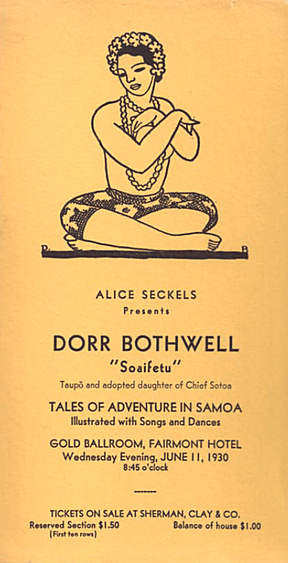
I even sang some Samoan songs on a San Francisco radio station. I also had a successful show at the Beaux Arts Gallery, run by Beatrice Judd Ryan, upstairs on Post Street.
I was invited to a luncheon given for Henri Matisse at the Stackpole Studio. Matisse was on his way to Tahiti. His son Pierre had been in San Francisco a few years earlier, thinking of opening a gallery but had decided against it. Pierre did open the Matisse Gallery in New York, but he came out to San Francisco to see friends he’d made and to guide his father around The City. Henri Matisse was about 60 then, a small man, who looked conservative and middle class and wore little round steel-rimmed spectacles.
Ralph Stackpole had made tables by using three long drawing boards on saw horses to make an open ‘U.’ In the ‘U’ part was a narrow table he used to set his sculptures on. He’d placed a mixture of fruit and vegetables on this table, something I had never seen done before. As a rule, if you were honoring someone from Europe, you had roses in crystal vases, with Georgian silver candlesticks and white damask tablecloths.
Everybody fell all over themselves. Some people in San Francisco even owned a Matisse. This was a studio party. One thing about Stackpole—he had a great sense of what was appropriate, so he made an inventive table setting. I think we ate off of pieces of cloth. I don’t believe there were tablecloths on those drawing boards. They could have even been pieces of drawing paper set down, with enameled plates and wooden-handled knives and forks on them.
How did Matisse react to that? I have no idea. He was a very dead-panned person. He had a sweet smile, but he didn’t smile often.
Matisse sat at the head of the table and on his right was Ralph Stackpole, who spoke fluent, though ungrammatical French. Lee F. Randolph, E. Spencer Macky and Constance Macky were there, because they also spoke French. There were a number of socialites. The tennis player Helen Wills had been invited. Talk about deadpan. No expression whatever. They even commented on this in the newspapers.
Adaline Kent and I sat at the foot of the two long tables. Addie spoke French. I was invited because I knew how to do the island dances. I finished lunch early, because Ralph had suggested that I put on my costume and begin dancing while his guests were still eating, just before coffee was served.
In those days there was no difference in the public mind between Samoa, Hawaii or Tahiti. They were just somewhere in the South Seas. The Samoan dance is somewhat similar to the Hawaiian. The hand movements are more explicit. They are really hand sign language that you’re using. When I was the chief’s hostess I sat in on feasts and it was my job to do a classical, welcome visitors dance, indicating which direction they came from and how they came over the water. The foot movement is very similar to the Hawaiian hula. It was mostly the arms and shoulders.
People make a mistake when they try to do Samoan dancing if they wave their arms in a limp way. In Samoan dancing it’s as if you’re pushing against the atmosphere. You push things. The gestures have tension in them. You just don’t wave your hands. For example, the light of the stars—you twinkle.
There was no recorded Samoan music. I had records put out by the Anthropological Institute of France, which I now realize were very rare, because that music has changed so much. I had no movements to go with the Tahitian music and I invented some to fill those gaps. Tahitian dancing had wild hip waving and I explained it would be much fancier.
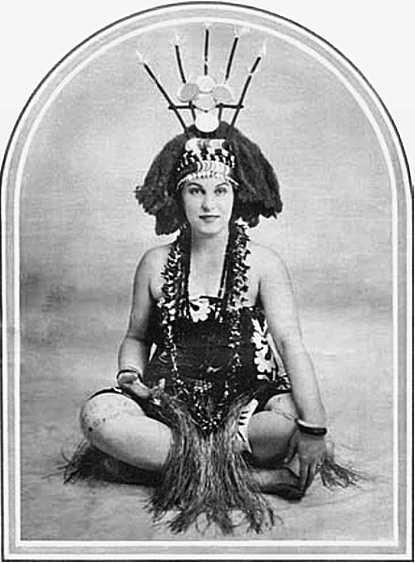
Stackpole told Matisse that this would be the music he would hear in Tahiti. The audience seemed to enjoy my dancing, but there was little reaction from the famous artist.
Afterwards, several people asked Matisse essentially the same question, in English. Lee F. Randolph turned to Matisse, who was still eating. Matisse had a good appetite and evidently the food was right to his taste. Randolph asked, in French, “Dear Master, what is your advice for the San Francisco artists?”
Matisse put down his knife and fork, wiped his mouth, and said, “Moins parler. Plus de travail” (Less talk. More work). Then he continued eating. After Randolph translated Matisse’s answer, there was a dead silence. That’s the famous remark, and that’s the whole point, not that I danced, which should have interested Matisse too, because he knew he was going to Tahiti.
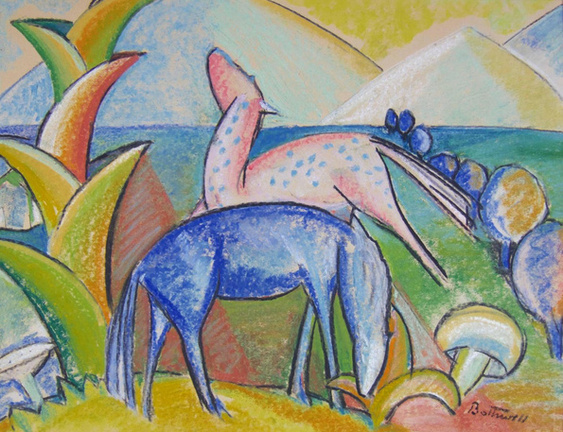
I left San Francisco for Europe in June, 1930, on a Swedish freighter, the Axel Johnson. The Axel was fairly large and carried about 60 passengers. It had a first class, where most of the passengers were, and a general third class—that was me. On board the ship I met this couple, Mr. and Mrs. de Civray, who were going to Paris. They told me where they would be staying and recommended their hotel in Paris. The ship stopped first at La Havre. I stayed on board until England and got off at Southampton.
There were a couple of college girls on board, but I didn’t see much of them. They were taking this trip as credit for a course so they were busy with their studying and writing. We agreed to meet in London.
I stayed at a hotel the girls must have recommended, on Bedford Square near the British Museum. That first day I went exploring, naturally to museums. I spent long hours in the museums. My folks did an awful lot of walking also. You can’t see museums from public carriages. I spent what was left of the day sightseeing in London. Nothing exciting happened. I just saw all the classical things. I went to the Royal Academy and the British Museum.
I have two vivid memories of that trip to London. The first was seeing the Rosetta Stone in the British Museum. The Rosetta Stone was sitting on a piece of wood, not even a stand, all by itself in an open space. There wasn’t a guard or anybody paying any attention to it. It wasn’t in a glass case—it was just sitting there. And I touched it! I could get close and look at all sides. It was incredible.
Now it’s roped off. You can’t get any closer than five feet so there is no chance of anybody touching it. Plus it’s covered with either glass or plexiglass, which makes it difficult to see because of the way the glass reflects. That incredible stone, that unlocked history, and is a most important element of the essence of human communication. I was so enthralled with the thing that I just reached out and touched it.
The two college girls were going to see Noel Coward’s Bitter Sweet. I hadn’t heard of it but the play turned out to be my second vivid memory of London. See, because of my trip to Samoa, I had been out of touch with the world entirely and was two years behind the time in everything—art, music, theater—let alone stuff in Europe. I’d never heard of any of these things. So this was the beginning of my education there. I went with them to see the play and I was thrilled.
Cecil Beaton had done the costumes and the settings. Beaton used a wonderful kind of what I call duck yellow, a strong yellow that was slightly neutralized, about as bright as a Yellow Taxi Cab, and a wonderful burnt orange in the costumes. I mean real colors. Now this was in the 1930s, and in the ‘30s in American art schools we had navy blue, and brown, and grays. Nobody wore anything in bright colors. Cecil Beaton was way ahead of his time—that’s why he was famous. It shocked people. I thought it was delightful, so satisfying, like eating color.
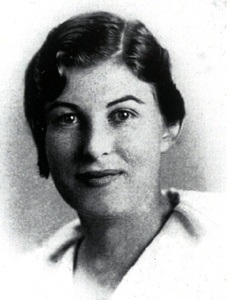
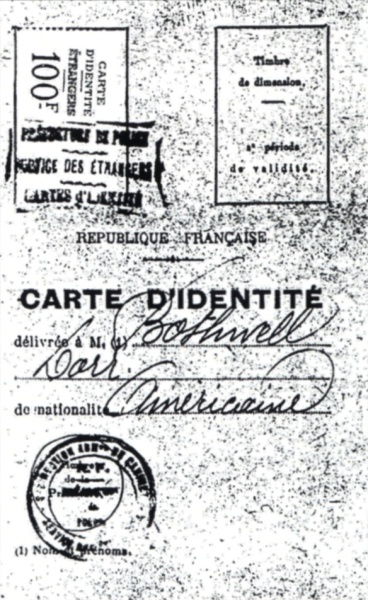
Then I went to Paris. The trip across the Channel was rough. I don’t get sea sick, but other people were sea sick. I went to the hotel that Mr. and Mrs. de Civray had recommended and sure enough they were there.
By the time I got to the hotel it was evening and I went to bed early. I don’t think I even had any supper. I slept in this darkened room and I really didn’t know where I was in the morning. The maid rapped on the door, opened the door, and I almost fell out of bed. She came in and pulled open these great heavy draperies. Then she placed my breakfast on a little table by the window. There was hot chocolate, a croissant and butter and marmalade on a tray. Beautiful little dishes. The curtains were heavy yellow brocade with dirty fringe that came down on to the floor. Draperies to the floor hadn’t hit America yet.
I sat down to breakfast and looked out the window. There was a man pushing a cart wearing a wonderful peasanty coat with a beret on his head. He was shouting, “Haricot vert! Haricot vert!” The cart was heaped with green beans. Those were the first French words I remember from Paris.
After breakfast I went out exploring. The de Civrays said that the first thing you buy is a Plan de Paris, the small red guide with maps of the arrondissements. That little hotel was on Rue Gay Lussac, just off Boulevard San Michel, very close to the Luxembourg Gardens. So I was in a good, nice area.
I smoked in those days and went to buy some cigarettes. I couldn’t afford American cigarettes, so it was a Gauloises Bleues, which was pretty strong. They were sold in the post office, where they sold stamps. There were little boxes of matches in a basket. As I started to pick up a box the woman said “Non, non!” I realized that they were not free. I couldn’t understand her—she must have used a slang word for what I had to pay. I held up my money and watched while she selected perhaps 25 centimes, a piece with a hole in it. She startled me, because she reacted so fast. I guess a lot of Americans take things.
I learned one thing.
The de Civrays had also said, “One of the things to remember, especially if you don’t speak the language, is to always be polite. Don’t just start saying what you want.” So I memorized bon jour, madame, monsieur, bon soir, etc. The next thing I saw was a man turning on what looked like a water hydrant but close to the curb, near the Luxembourg Gardens. He wore a blue heavy denim coat, with trousers tucked into short rubber boots, and a black cap with a black patent leather visor. What riveted my attention was the bundle of twigs made into a broom that he used to swish the water into the drain. They wear a yellow costume now and don’t use twigs for brooms, but the Luxembourg Gardens are just as lovely as ever.
Of course I went to the exhibits. I was alone, probably Mr. and Mrs. de Civray had put me on a bus. I got off at the Grand Palais and just by chance went in to see this show which I think was called Art Moderne—it was the first time I ever saw any surrealistic art.
The first painting was a small painting and it just blew my mind! It was a fur-lined tea cup. I was shocked. The cup was painted very realistically, every hair delineated, quite small, maybe 10 inches by 12 inches, with a big frame. You could see the handle, and part of the porcelain on the inside was meticulously done in rabbit fur. I couldn’t look at it too long—it began making me sick. I couldn’t take it in. I’d just look at it and go, “Ugh!”
The next picture was by Magritte, a small painting, maybe 11 inches by 14 inches. At that time I had never heard of him. The whole painting was nothing but this one oversized eye and the iris was a most beautifully painted blue sky with white clouds. The central part was black, with this jet black dot in there. I thought that was beautiful; what a wonderful idea, and I just loved it.
I went on, to Miró’s Dog Barking at the Moon. Some of it was painted, some of it he used a pure black that had been squeezed out of a small paint tube to make a small raised line. Some was heavier and sort of mashed down—the dog was black and the moon had yellows and red things around it. I remember the dog and the moon and the sky and the texture. I thought he was mad!
The next painting I think was by Juan Gris. Some kind of Cubist painting. It didn’t seem to me to fit with the rest of the show, but from the color and size of the painting, that’s what it looked like.
Then the great big Ozenfant painting. He did sections of wonderful vases and classic things. Some were slightly rounded; mostly they were flat. What riveted my attention was the surface and the fact that he used these rather strange pastel colors. I was used to pastels being pale pink, pale green, pale yellow—like we saw in candles or women’s clothes. These were pastels of different kinds of colors. A pastel brown, for example. They all had a lot of white in them.
I had never heard of those painters. They were totally unknown!
I later saw them and they seemed familiar. And I sort of dimly remembered, but it didn’t come to mind, really, what this experience had been. Subsequently, I knew the Miró from having seen it reproduced in books. I knew Magritte. I was not interested in the surreal. I’ve always been interested in symbolism. And the things I remember were more symbolist than surreal, like the eye symbol and the cup symbol.
The exhibit was on the Right Bank. I’d taken a bus over but I walked all the way back. I was in some kind of a fog and I crossed to the Left Bank. A little narrow street with three and four story, very old houses jammed together, opened off a boulevard. In the middle of the block was an open door and a nice woman in rather drab clothes was leaning in the doorway.
She had bare arms and I remember thinking it was chilly for that, because the weather was cold. She straightened up as I came by and said, “Mademoiselle, would you like to see a new kind of movie?” She addressed me as mademoiselle, the first person who had used that term to me.
I looked in and there were wooden chairs and little table with a small cinema machine on it. And a kind of homemade white screen no more than a yard square. Ten or so people were sitting there. I remember seeing the wooden chairs and figuring out where I would sit. I was trying to think of the word for price in French. She told me. So I paid and went in. Of course, it was Un Chien Andalou, the film made by Luis Buñuel and Salvador Dalí, which was then only a year or so old. It’s kind of a shaky film and actually quite short. It starts out with this man going across the roof. Not terribly exciting. Then it began getting more and more peculiar. When the knife cut across the eye I almost vomited. But I stayed for the whole thing until they turned the lights on. I thanked the woman and left and somehow found my way back to the hotel. I have no memory of what happened the rest of that day.
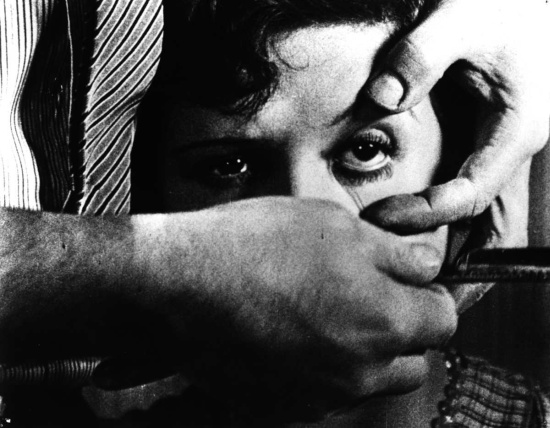
It never dawned on me until I was telling somebody about this sometime in the ‘50s that I realized what I had seen. I went to a museum and saw it again. I was all braced, for I knew it was leading up to the eye thing.
That day was a day that my head was really turned around.
The remainder of my time in Paris I stayed at #11 Rue Henri de Chevalier, a nice tiny place on the third floor of an old four floor building.
I had a schedule for my time in Europe so I couldn’t stay too long in Paris. I wanted to see Germany. On the way I went to Brussels. I don’t remember why. If I’m visually not impressed, I don’t remember. I don’t know what was wrong with Belgium, maybe bad weather. I don’t think I even stayed overnight, just got out, spent the day, then took the train for Berlin.
I ran into these Americans on the train. You know how you get to talking. Since I didn’t know anyone they said, “Oh, you must see the Duchy of Mecklenburg.” Somebody had a relative in Mecklenburg, where they were going, and they showed me around. It was a delightful old town, although the castle was closed during the winter. I had a chance to see the inside of a genuine upperclass German home and a real evening, formal supper, where you stood up, mostly, and ate dabs of sausages and cold food. The house faced on an old park with beautiful tame European red deer. The mansion was the home of their great-grandfather, who had been councilor for the Duke of Mecklenburg.
These friends suggested that I might want to go to art school in Berlin, but after I got there it was too late—rules and regulations. But I did do a lot of sketching at the school, even though I couldn’t enroll. The school was in an old classical building, with the front part open to the public. It was also a museum, with plaster casts of original-sized reproductions of Greek and Roman sculpture in place. You could come in and sketch if you wanted to, which is what I did, because I didn’t know anybody—and having a place to draw was a good idea.
I’d seen a copy of the Christian Science Monitor, with advertisements for guest houses in Germany. I found a room to rent and boarded in a house on a little side street, Tronsteiner Strasse, owned by a couple of old maids born and brought up in Argentina. They spoke good English, translated straight from the Spanish, and also spoke German, translated from the Spanish. When they showed me a room they had to rent, one of the women said, in German mixed with Spanish, “Nein, das ist de los matrimonios.” “That’s a couples bedroom.” What she wanted to show me was a singles bedroom. They told me the people next door were matrimonials—a married couple. They translated the Spanish matrimonios into English. They were very nice, very proud.
In the bathroom was a big bathtub, with a wide blue band around the inside. The hot water was heated by a machine run by gas. The maiden lady said that when you put the water in you should mix the hot and cold, and that the water should not go above the line because the heater would turn itself off. It was a nice little street, nice people there. But the house was cold.
There was a wonderful museum in Potsdammerplatz, with the best collection of Eskimo and Siberian native clothes that I ever saw in my life. They were on figurines as you came in. We in the United States hadn’t gotten around to doing anything about Alaska, except for husky dogs and sleds. But this museum had all this Northern Art.
The building had been a palace. Upstairs, the alcoves were closed off but guards would unlock them for you. You could go in and see their collection of Inca gold. With a big guard standing there, you were allowed to look. There were rare antiques, like feathered decorations and Inca weavings, all in these cubicles. We looked around, then we stepped out. They locked the doors and followed you around. I understand that everything there fell into Russian hands during World War II.
But things were very uneven and expensive in Germany. I ate in an automat, which was pretty good, but a cup of coffee was five marks. I moved to the home of a captain in the army and his wife and little boy. My room had more heat. That was the main thing, because it was so cold. It was Christmas time and I remember trying to find a present for the child, which was outrageously expensive.
The only people I knew there were a wealthy doctor and his wife. He was a child psychiatrist named Berenheim. It was the first house I had ever been in where they were very à la mode—much ahead of things. They had one wall painted a wonderful deep green and the other walls were tinted a different color. They invited me to a party one night.
In the ‘30s, when these new ideas were coming up, people gave parties to discuss them. Berenheim was married to a woman who spoke six languages fluently. Alicia Berenheim was very much interested in the arts and the political situation, the reason why these parties were important. An up and coming musician played the piano. It was light refreshments, with servants in uniforms, a very elegant thing.
One of their guests was a Dr. Himmler, who later was with Hitler. I don’t know why he was at that party. They could have been inspecting the place, it could have been anything. At that time the political lines of demarcation weren’t yet so plain.
Himmler didn’t join in the discussions and afterwards I asked Alicia Berenheim about him. She said he was brought by the musician, “who was a good friend of ours.” He was dressed just like everyone else, but he didn’t seem to belong—that was my feeling—and he didn’t say much.
They were talking about “this Aryan situation” and Berenheim, of course, was Jewish but married to an Aryan. He was quite well known and people from the United States brought their children over to be treated by him. So he just wasn’t any old doctor, and he felt that his importance, especially for the youth, would insure his position in Germany.
Himmler didn’t answer when Dr. Berenheim said that doctors and health cut across all lines. “They will always need us because doctors, whose lives are dedicated to save man, represent the humanitarian instincts of man.”
Berenheim soon found out that even doctors weren’t spared. He escaped to London, but their nine-year-old son unfortunately didn’t make it. Alicia Berenheim stayed with the little boy in Berlin but he was killed by the Nazis.
I later learned that Berenheim had treated Robert Flaherty’s 12-year-old daughter, after they came back from Savaii in the South Seas. I read a personal significance into this, a circle closed, because of my feelings for the maker of Nanook of the North and Moana.
One time I was on the Berlin Underground, which was very modern. An announcement came over a speaker that we would not be stopping at Wittenbergerplatz, which was where I wanted to get off. The train didn’t stop until the next station and I had to walk back to Wittenbergerplatz. I walked back on the main street, following the underground stations. It was late at night. They didn’t have a lot of street signs and I couldn’t read them anyhow. I thought it was safer walking that way. I knew exactly how to get to Tronsteiner Strasse, where I was staying.
There were many police and they were moving something. I couldn’t see what it was. It could have been a gun on a stanchion. They were folding something up that took two men to do it. Another man was sweeping up. I really didn’t hesitate at that point. I didn’t know what had happened. It could have just been a bad accident, but I didn’t think so.
One night I went to a concert and when I got off at my streetcar stop they had this machine gun mounted. I don’t know what they were quelling, but they were quelling something. It was about to turn 1931. Shops had their windows broken and had Jude written on them.
I have a visual memory. Everything I try to get into words I’m translating from visual memories. And I really can see what’s there. So I saw the window, broken, and got the same shock, because it said Jude.
Then I ran into Claire Turley, a friend from art school in San Francisco. She had just illustrated and published a children’s book, with wonderful drawings of cats and kittens, and was traveling on the proceeds.
One night Claire and I went out for dinner and we got lost. I hadn’t gone out nights much, except to concerts and a few exhibits. We found a night club called The Viking. Looked sort of Swedish, with raw wood furniture and seemed quite nice. It was about a quarter of six. I knew that dinners were served later. Claire didn’t drink. I don’t drink. We each had a cup of coffee. It was completely dead. Dinner was served at 7:00 pm, so we had an early dinner. As we finished eating, the place really opened up. The orchestra came in, these couples came in. Most of the men were in black tie. Really stunning looking women, wearing beautiful beaded and sequined dresses, with gorgeous hairdoos. In those days Paul Poiret sequined dresses were the rage. Then the orchestra began to play and people got up to dance—but the women seemed awfully tall.
I looked at Claire and she looked at me. I said, “You know, Claire, I don’t think those women are women. I think they’re men dressed up as women.” Suddenly it dawned on us that we might be in one of the transvestite nightclubs. The place didn’t look like a nightclub and was advertised as a restaurant with an orchestra. But actually the part that we were sitting in became the drink-serving section for the nightclub, and that’s why they let us sit down. But as neither of us spoke enough German, and perhaps because nobody of importance was there so early in the evening, they only looked at us strangely. It just was one of those goofy things.
We stayed awhile. I used to carry sketch books and I thought maybe I’d make some sketches. I started to get the book out but thought, “Uh no, I don’t think this is the place to do it.” So we paid our bill and left.
Later on I read that this was the most elegant, notorious spot of its kind. Not notorious in the sense of déclassé, but because it was so upper crust and so blatantly homosexual. Berlin was wide open at that time.
We went to the big Wertheim department store in Berlin. On the second floor was an orchestra and on the third was the konditorei, where you got goodies to eat. I decided that while I was in Germany I should have apple strudel. Now remember, this was during the Depression and everyone who waited on you was anxious to please, because they worried about losing their jobs. These countries had come through terrible times after the First World War and anybody who had a job was really lucky.
They brought the strudel in a soup plate and the waiter carried a soup tureen full of whipped cream. The bowl was at least a foot in diameter and looked like a silver wash basin. He ladled the whipped cream over the strudel and I didn’t know how to tell him to stop, in German. He just kept piling it on, hoping to please us. While this was happening, believe it or not, the orchestra was playing the Stanford University marching song!
Another strange thing—and I still think about this, there was a bookstore on a side street off Unter den Linden. I went in first because it had art books, but it also had history of art and art from other countries. It had a book about Samoan history. I don’t remember the author. It was a history of the islands, but what was good about it were the early photographs of people and costumes. I was interested in the book and bought it.
I asked the woman in charge, “Do you have any other books on Samoa and the South Seas?”
She didn’t know but said, “Just a moment, let me get the proprietor.”
She went behind a curtain and after awhile out comes this stunning looking man. He was tall, with blue eyes, and a real mop of whitish, grayish hair that had a kind of a natural wave to it. He looked familiar to me. I asked him a question and he answered in excellent English. He spoke to the girl and she brought some more books. Sure enough there was another one that I wanted to buy. While she was wrapping them up, the man said he was interested that I had purchased one book because he had read it and liked it. I told him I was buying that book because I had been in Samoa.
As I was getting my money out to pay him, I looked at him again. Even to this day I can see him. I said, “Haven’t I seen you before?” He stiffened right away. “Have you ever been to California? Were you ever in San Francisco?” He turned kind of blue white and perspiration stood out all over his forehead and upper lip. There was a counter between us and back of that was a narrow space, then a doorway with a curtain on it.
He said, “Excuse me,” grabbed the curtain and left. My first thought was that he was having some kind of seizure. Then he pulled the curtain aside and in what seemed like a normal voice called to the girl who was in the back. Then he said, “Would you excuse me,” and disappeared again. She came out and took my money.
While walking home I thought, “Now what on earth!” Remember, war was building up. “I wonder, could he have been a spy, with good English in San Francisco, posing as a German tourist or something?” I have no idea. Perhaps he had a heart spasm, a terrible pain, whatever. But that man turned white as a sheet. I for the most part don’t notice people’s faces so much—I’m more interested in the whole effect. He didn’t tremble, just turned white and called the girl and left. Of course, I never saw him again, but I’ve never forgotten.
Three or four days later, just before I left Germany, I told Claire about this wonderful bookstore so we went there. But the big plate glass window was broken and across it was written Jude. We didn’t go in but when I saw that I got this terrible feeling. So I could not help but visualize the word Jude.
I had three more pictures in my mind, really. Once I was walking near Unter den Linden at the intersection with the museum of plaster art, when young boys, maybe 14 or 15 years old, in brown uniforms, marched along the gutter, swerving out if there were cars parked. I hadn’t yet come to the corner, but I slowed down when I saw those boys marching.
They made no sound, except when two or three people went up to the curb and called “Heil Hitler.” Then immediately, without loosing a step, they raised their heads and arms up and yelled “Heil Hitler.”
Not everybody on the sidewalk saluted back, but a lot of people did. The other people just sort of quietly faded away and were back against the building when I turned the corner.
The next picture was the destruction of the window. The last was of my underground not stopping at the square. Putting everything together spelled, “Get out.” Hitler didn’t come up from Munich until 1933 but one night I heard shots. The shots weren’t necessarily related, but I was sensitive.
I told Claire I wanted to leave Berlin, to go to some place where it was warm and she agreed. It was terribly cold, getting towards January. I had Christmas all alone and was lonely. Claire didn’t come until after Christmas. But, of course, it wasn’t just the cold that made me want to leave there. And Claire felt the same way.
So at the beginning of 1931 we took a train to Lübeck. We weren’t thinking of home, just of getting away from Berlin. The railroad station in Berlin was brand new and very elegant. Over the top of each window, where you bought your ticket, was frosted glass and a section of the rail route showing the cities. They all went from left to right, horizontally. I had heard of Lübeck and knew it had been a free Hansa town, but it wasn’t clear just where it was. When I saw Lübeck, something clicked and I thought, “Oh yes, that’s a beautiful town, with wonderful copper roofs and red and different kinds of bricks. It has its own little gateway.” I looked at the map wrong. I thought I was going south. I wanted to go where it was warm. So we went to Lübeck, never dreaming it was as far north as one could go in Germany. Claire didn’t know from nothing, either.
In Lübeck we found a room in a small gasthaus that was owned by a doctor. But Claire was asthmatic and allergic to feathers—and they didn’t have a wool blanket in the whole place! Claire began having an asthma attack. She had her own ephedrine and had to give herself her own injections. Finally, the doctor got a wool lap robe, folded it up, then scrounged around for any wool blankets he could find. Then he opened the window. It was so cold! Claire slept with her head out the window with the wool blankets around her. I tried to keep warm, huddled down under those darn feather comforters, that were too short even for me to sleep straight out. If you pulled them up, your feet were bare; if you put them down, the top of you was cold. You had to sleep in a fetal position to really stay inside those feather beds.
However, it was such an interesting place that we paid for three nights. On the far side of the harbor were the old, old buildings that were just facades, the back part of them mostly gone, just propped up. They looked very much like the buildings you see in Amsterdam. We went up cobbled streets into a big restaurant, where ship captains used to sign on their cargo or were given commissions. There were models of the ships hanging from the ceiling and the original table was still there. Originally the plank tops must have been six inches thick, but the places where people had eaten had been wiped so many times that there were hollows in front of each seat. They had worn down to about three inches because, of course, it dated from the 14th century.
The Hansa fleet went to the near East during the 15th century and one thing they brought back was the recipe for marzipan, which is ground-up bitter almonds and honey. Regular almonds were grown in Europe, but not this special kind, and, of course, honey was available. Lübeck made (and still makes) the best marzipan in the world.
Marzipan Sculptures, Niederegger Cafe, Lübeck
I never saw chocolate-covered marzipan, but in Lübeck the real shops had nothing but real marzipan. They had paintings done in marzipan and scenes of Lübeck, the towers and the entrance gate and famous Hansa building. Some were of early ships. These paintings must have been very expensive. For Christmas they had bas reliefs of scenes in natural color, all made of marzipan. There were creatures, some sculptures, which looked old and dusty—they never sold those. There were natural fruit size and small baskets of fruit. And small compartmented boxes with little marzipan fruits in them.
I can still see the window I’m describing so plainly, but there were always people there, and the edges fade out and I can just see what I could look at. I know I bought one of the little boxes of imitation fruit to take to a friend in Paris.
Lübeck was wonderful, but we were freezing. I had everything on, including a pony skin coat. But I just couldn’t get warm and Claire couldn’t breathe. And we couldn’t sleep at night, because great chunks of ice were crashing in the Baltic Sea. Terrible sounds. Screech, scratch, bang! Blocks of ice the size of a house and thick. They had to be broken up for the ships to come into the harbor.
So we left Lübeck and headed for Paris. We had a terrible time getting there. We had to go through Hamburg. Claire was still in a bad state. We discovered to our horror that to get on the train for France we had to change trains. We came in on the lower level and had to climb up three enormous flights of stairs to the third floor where the train to Paris would leave. Claire was coughing so much you could hear her all over that station. She needed a shot of ephedrine but we couldn’t stop for it because we had to catch the train.
This was not a good time to travel. I wasn’t feeling too well myself. It was the cold. We just caught the train. Fortunately, we had reserved seats. We were, of course, in a Second Class car. The car next to us was a Third Class car with little wooden seats, that looked like something Daumier might have drawn.
At that moment Claire realized that she had to have a shot of ephedrine and asked me if I could do it. I couldn’t! I absolutely could not stab her with that needle, even though I knew she was suffering so! “Then help me and steady my hand,” she said. I braced her, the train was swaying, then she expertly gave herself the shot, which pulled her right out of it.
Chinese medicine used dried toad skins and dried snakes. Ephedrine is carried in the toad skin, from which it was refined, then artificially duplicated. But the original came from dried toad skins, which were ground up, then the person drank or ate it.
It was an ill-fated trip. All of a sudden, on the outskirts of Paris, smoke began pouring into our compartment! The train came to a halt, then started. The smoke got heavier. We couldn’t get out of our car and go into the next one until the conductor came. Finally he unlocked the door and let us into a First Class car with all the compartments.
Claire was just gasping. I said she was sick. My German wasn’t equal to it but said in French she was “malade.” The conductor switched to French from German, then helped her into the other car. I thought Claire was going to pass out. They detached the burning car, then shunted it onto another track, so they could put the other passenger cars together. When we passed the burning car it was in flames.
Finally we got into Paris, very late.
I don’t know where Claire was staying. I had a room at the Fondation des États-Unis on the Boulevard Jourdan.
About a week later I went to Le Havre and boarded the Margaret Johnson, another Johnson Line ship, this time home to California.
HOW I SPENT THE DEPRESSION
I had been away for three years when I came back to San Diego in July, 1931. The Depression began in 1929, and by 1931 it was really going strong. At first I had a little studio in my mother’s back yard and sort of holed up in there. I taught a short, extension course, in Painting at San Diego State College, then I went to Los Angeles.
The Government had a program called the PWAP. Not the WPA—Works Project Administration—that program didn’t begin until later on. This was PWAP—Public Works of Art Project. Artists were more or less invited to work and were given a small stipend and asked to contribute paintings. A museum employed an artist to make a picture for them and the Federal Government would pay half—that was the PWAP. The proviso was that the museum owned the painting. I did a painting on gesso with gold leaf background—14th century Italian style— of a Samoan girl holding a couple of fish on a leaf. I overpainted the gold leaf for the gold fish, with a silver fish, painted blue. But the program only lasted about a year.
In 1932 I married Donal Hord. We were both 30. His birthday was in February, mine in May. I had known him for many years. We had both been enrolled in the night school modeling class in high school in San Diego.
Donal had been modeling on his own with plasticine, just anything. He was doing very inventive things. He was an omniverous reader, a self-educated man, especially in Oriental Art, which I also liked, having seen a lot of it in the 1916 exposition. He was a born sculptor and he knew exactly what he wanted to do. He cut directly in stone and finally taught at what became San Diego State University.
He suffered from an enlarged rheumatic heart and could not attend regular high school. He was very careful about going up steps and things like that. When he had these attacks he couldn’t lie down. For maybe a week he’d try to sleep sitting up in his chair. There were no free doctors or clinics then.
We spent time together, because we didn’t know any other artists, but I didn’t see him continuously. We were just good friends. He finally brought me home and introduced me to his mother, who was a little French-Canadian woman. They seemed to have a good relationship. He called her pet names and was her only child. He leaned a great deal on his mother. She made the income and taught him to cook.
His parents separated just after he was born and his mother took Donal to Washington State. She got a job, but never had any money. Donal sold newspapers on the streets, caught pneumonia and wound up with a rheumatic fever, which resulted in an enlarged heart. Because of his health they moved to San Diego, where his mother worked at Woolworth’s.
But after he graduated from high school, Donal quarreled with his mother and never spoke to her again. Donal had been to New York and on the return trip he stopped in Ohio to see his father, for the first time. His father was a jeweler, had remarried, and Donal had a half-sister. His father asked about his mother and so forth. Donal said to him, “You know, because of my heart, I’ve never been able to go to school. All of my life I’ve wanted to go to college. I’ve never been able to, even though I’m stronger now and could do it.”
His father said, “What? I sent money to your mother every year of your life. Let me show you my books!” And sure enough he got an old ledger down, which showed what he’d paid.
Donal said, “Well, she worked at Woolworth’s and we never had anything.”
“That’s impossible!” his father said, “I just don’t understand it.”
Donal didn’t understand it either, but it came out that his mother played the stock market. So he never had the clothes to go to school. He had it out with his mother. They owned this little place. With sales from his work, I think he bought the lot. He ordered her out of the house. It was a terrible thing to do, because she had no relatives or anything. I never did know what happened. He just said, “She left.” He couldn’t talk about it. It was a great scar. I never asked—I should have.
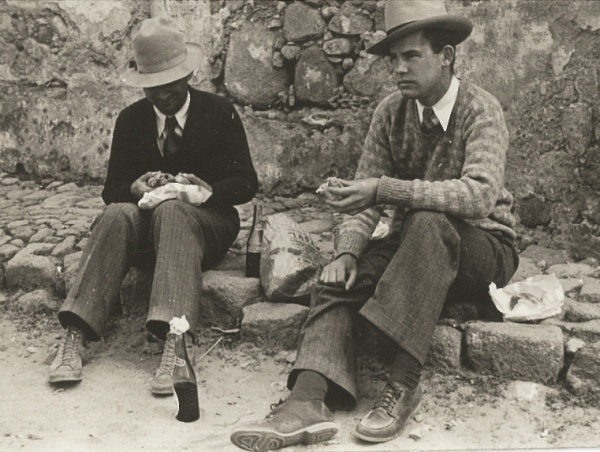
Right after high school, whenever I’d go to San Diego to see Mother, Donal and I would take up the conversation where we’d left off—but I hadn’t seen him in a few years. When we re-met in 1930, he’d received the Prix d’Rome and been in Rome. I hadn’t kept writing to him. I was doing my thing in the art world, he was doing his.
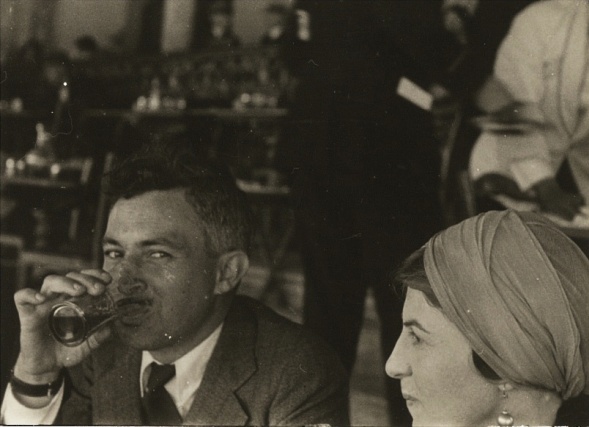
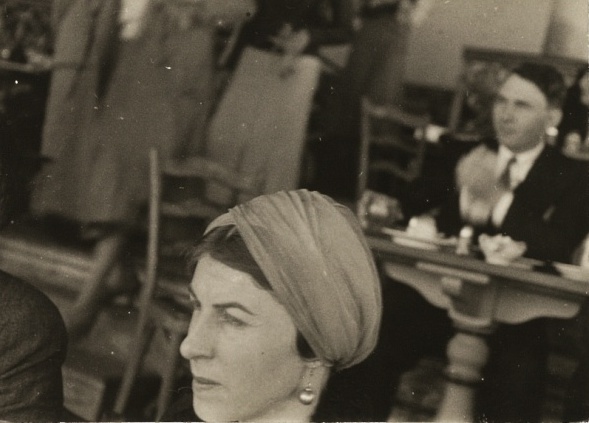
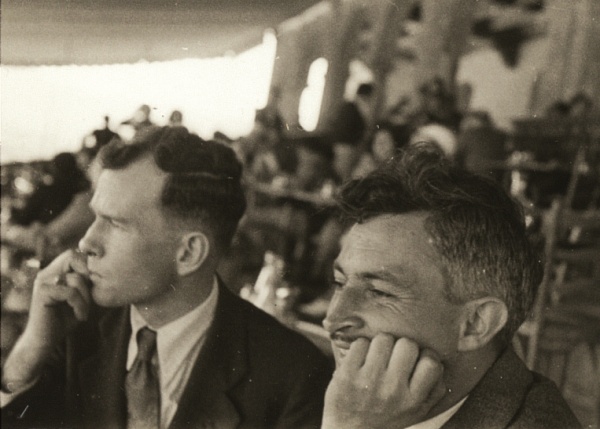
I was so amazed when he proposed, because I didn’t think he was that kind of a person. It’s what often happens when people have had a bad marriage or, in this case, a bad relationship. They get married, or get married again; then they take their frustrations out on that person. We were photographed for the marriage and made the front page of the San Diego Union.
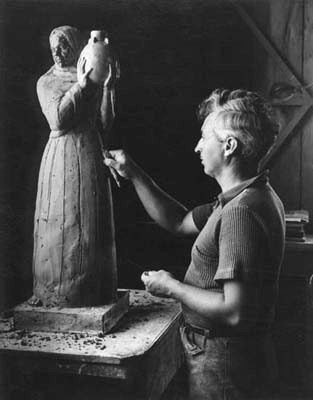
It wasn’t that bad. It was very nice. It was me, too. I wanted 50/50. I knew he could cook. I could cook and I wanted him to do half. I wanted to get together on the time thing, instead of his working, then saying, “Dorr, get in the kitchen and cook dinner.” I couldn’t do it. I would have left in six months time but my mother was alive and in those days divorce wasn’t done at all. And the divorce thing was also photographed, but not on the front page.
Something I should add—when I was growing up, all the problem movies were about the ‘career woman’ who made a whale of a success in business, then gave it all up for some good man—or else lived out a lonely old age peeping through the windows at happy grandmothers taking care of their children’s children. I could never figure out how to keep house for a man and adjust my drives to someone else’s desires without blowing my top. I still see no solution to the problem, unless men are emancipated from the necessity of being male all the time and become not just helpful but also understanding humans.
Of course, I painted during those years. One painting was a self-portrait, which was symbolic. I had my hair tied up with a white linen towel. I had a yellow green dust cloth and I was dusting a small Chinese gold wooden figurine, the kind that comes off a Chinese carved frieze of figures.
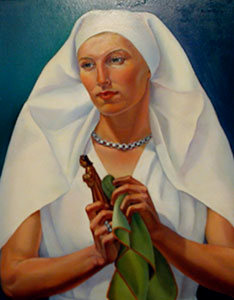
Materials from those years are in the Archive of [American] Art in the Smithsonian in Washington. They requested personal stuff, from before you became known. I turned over my press books and everything. It’s all there, anything you want about my background. I’ve always made the newspapers.
Don’t ask me why but I always have. When I came back from Samoa there were newspaper articles. The press books covered stuff in San Diego and the prize winning things. The picture of me doing the dusting won a prize. Not a purchase prize.
Another good painting that I did in 1932, called Cultural Affinities, is lost. It was stolen. It had won a prize and was exhibited in San Diego. In the ‘60s it was in the Oakland Museum. A man came to assist in a big show of California artists and picked up a number of canvases. We gave him the pick-up slips, too, so he’d pick the paintings up when the exhibit was over and bring them back. I have no idea what happened, but a man went into the museum with the proper pick-up slip for my painting.
Naturally, they gave it to him and he signed for it. But I never saw it again. By the time I realized it was lost, I didn’t know what had happened.
My philosophy is that there’s nothing lost in the universe. I believe that what most people call God is an incident intelligence that is everywhere present. And we’re tied into that intelligence, too, because it knows us. If you don’t like the words God or universe, substitute universal computer and you’ve got the reason why nothing’s lost. See, I believe that the instant the first cell is fertilized, the universal computer swings in. This is in the invisible, where there’s no time and no space, where we get all our ideas from. So the idea of a computer existed long before computers and that’s why, in the Bible, it says, “Not even a sparrow falls without the Father knowing it.” That bothered me so much as a kid, because I knew all about sparrows. I kept saying, “Daddy, I don’t see how he can keep track of all those things?”
All you have to do is have a little faith. Say that something’s lost and you want it back. If you can visualize it, you know that it is not lost—it is someplace in the universe—or universal computer—which knows exactly where it is. Then you’ll get it back. I’ve gotten lots of things back that way.
I have not worked at getting this painting back, because for a long time I didn’t know it was lost. I thought it was stolen. It was stolen. But that’s a negative thing. I just say that it’s mislaid or it’s not in its proper place, which should be with me. You can’t accuse people—you can’t be negative about the thing—you have to be positive.
Cultural Affinities was the first painting I did directly after my marriage and is one of my earliest paintings. One of these days it will turn up.
I was married in ‘32, divorced in ‘34. I just left. I went up to La Jolla and got a job with Francis Cooke, who owned a gift shop in the La Valencia Hotel. We became good friends and he arranged for me to work on a mural in the hotel. Soon after that we decided to open an interior design studio on Wilshire Boulevard in Los Angeles. We had a few commissions for designs—some quite good—but because of the Depression a design studio had little chance of success and it closed.
1936-Designs executed by Bothwell-Cooke Design Studio
1936-1937-Gladding, McBean, one of California’s oldest companies, began manufacturing Franciscan Pottery in 1934 and added Catalina Island Pottery to its line in 1937. Dorr Bothwell designed at least 17 different pieces plus numerous variants.
Then I had a job doing designs for plates for Gladding, McBean, who did big salt-glazed sewer pipe and architectural ornamentation, and also had a pottery division. But I was let go because old Athol McBean brought a herd of black Angus cattle he wanted to raise back from Scotland. The company had to pay the costs, plus also they were cutting back, because of the Depression, so they let the johnny-come-latelys (without seniority) go.
Bothwell ceramics designs for Gladding, McBean.
1933-Head conte crayon drawing
1933-Model Seated conte crayon drawing
1933-Portrait Study graphite on paper
1938-Portrait of a Dog crayon drawing
It was difficult, and at Christmas time. Just before I was fired I had used up my savings to buy a coat and have my teeth fixed. So I didn’t have any money and was not eating well.
I worked for a couple of days as a kind of receptionist, but that fell through. So I was out of work, out of money, out of everything. You could not get on the relief program until you owed your telephone bill, gas and electric light bill, water bill, and rent. You had to actually owe for all those, have no bank account, and take the pauper’s oath. You had to be able to prove this by showing the bills, with big red stamps marked “Unpaid” on them and with the date the utilities were going to be turned off. You showed those to the authorities, they would write up your case and that would be worked on. It was not like welfare—you didn’t go in and say, “Look, I haven’t got a job,” and they’d immediately give you a check.
I couldn’t qualify at first, because I’d had this job and had paid my rent. I had everything paid, a roof over my head, but no food in the house. It was pretty tight. People who had anything didn’t get on. A week after you became a pauper you’d get your first check, for $14.90, for a month—and $10 was supposed to go for rent! Of course, groceries were cheap and you could buy three eggs, one strip of bacon and one cube of butter for 25¢.
Now this is a really wonderful story. One particular day I was laughing at myself because I literally hadn’t eaten any food for several days. I knew you couldn’t die of starvation—it takes a long time. I went through all my pockets—everything I had—and found a dime. I bought three small cans of milk.
I had two cats. I always have cats. I lived on Sixth and New Hampshire in Los Angeles. There were vacant lots in those days. I talked to the cats and said, “Look, kids, you go on out to the vacant lots—that’s where it’s at. This is milk and when this is gone, that’s it.” They looked at me with big round eyes and I said, “You’ll find out.”
1938-Mother & Daughter Siamese-pencil
There were six small studios there, a spring with a brook that ran through it, and small trees. Now it’s sealed off with a huge apartment house on top of it. But in those days, there was a series of springs that belonged to Bimini Baths.
The studio had a big fireplace at one end of the room and a small kitchen at the other. I used to eat off a wooden tea cart, with leaves that lifted up. I’d pull the cart up to the fireplace and sit down to my supper, looking very elegant.
You could get a meal if you went down to the YWCA and worked, washing dishes or something, and that was where I was headed. Going down Sixth there was a bench about every other block, where the streetcar stopped. I started off gamely enough, but soon became kind of woozy, so I sat down on a bench. I thought, “I’ll be darned if I am going to turn up as a newspaper picture—somebody else fainting on the streets,” so I went home. I thought, “This serves me right. I’ve wanted to do nothing but paint, and here I am—doing nothing but painting.” I would paint and work, and at mealtimes I’d lie down. I wasn’t getting weak, but I was beginning to worry!
So I got very angry with God. I had a little conversation with him and I said, “I don’t think I deserve this. I’ve tried to live up to your commandments and everything else. And I really feel I haven’t done anything mean or nasty to anybody and I don’t think I deserve to be in a position where I’m starving to death—really! So I’m going to lie down here and I’m not going to do anything— not a thing. I’m putting it all on you. You let me die of starvation, I die, and it’s your fault.”
What really happened, while I say I got angry at God, was that I turned completely to the invisible. There was nothing in the visible that I could see that could help me. Not a thing. No jobs, no nothing, no food, no nothing. So by throwing myself completely on the invisible, I threw myself on the mercy of God. “Prove me now herewith, saith the Lord of hosts, if I will not open you thewindows of heaven, and pour you out a blessing, that there shall not be room enough to receive it”–Malachi 3. I just said, “I can’t do anything!” I hit bottom, I realize now, and when you really hit bottom, and you aren’t sorry for yourself (I was a little sorry for myself), you turn wholeheartedly to the invisible.
And I learned something interesting. My background is Quaker, you understand—it’s not any of the so-called approved Christian religions. That left us free to do a lot of thinking. I was brought up to study both the Old Testament and the New Testament. I just lay down on the couch. Naturally, you can’t lie down without any thoughts, so after a time something said to me, “If I tell you what to do, will you do it?”
I said, “Sure, tell me what to do and I’ll do it.” “Set the table.” So I got up and was going to do it when I got kind of woozy. I said, “Look, is it okay if I set the table in my head?” “Yeah, sure, go ahead, just don’t forget anything. Put everything down.”
I busily visualized setting the table in my mind. The last thing I really remember was imagining that I was out in the garden, picking flowers for a bouquet for the table.
All of a sudden the voice said, “Come and eat.”
I imagined that I got up and here was this table, a little bit bigger than in life. In the center was an enormous silver salver with a big cover with a ring on the top. When I picked up the cover it hit the edge of the tray and rang. I couldn’t see what was underneath. I looked around, trying hard to pull it up, and it rang again.
All of a sudden I woke up. My telephone was ringing. A friend of my mother’s was phoning. She was a metaphysician and I never did know whether she intuited my situation or not. (By that time my mother was dead. She had been killed in an accident.) Her name was Miss Van Slyke. She lived in El Segundo and said that she was coming into town. Miss Van Slyke remembered a dinner I had given her, when my mother was alive, and she would just love to have another one, if I felt like doing supper. If not, she said she’d take me out to dinner.
I did a rapid calculation and figured there would be leftovers if I cooked the meal, so I said, “Miss Van Slyke, I’ll tell you the truth. I haven’t been cooking here in the studio and actually there is nothing here except a little salt and sugar and a few spices and you’d have to get everything from scratch.”
She said, “Well, that’s all right, dear, that’s all right.”
I kind of remembered what I had fixed and served—tamale pie or something—so I gave her all the ingredients, but I fudged. I really didn’t need milk. I didn’t need eggs, but I said to get me a half dozen eggs and a pint of milk. In those days we had pints in glass bottles with real cream that came to the top. I was thinking of the cats.
She drove an old Franklin, quite a large car, very elegant, with a little cut glass vase in it. The front of the car slanted down because it didn’t have a radiator and was air-cooled. She never drove more than about 30 miles an hour.
I heard the honk of the Franklin’s horn and rushed out to help carry the groceries in. I ensconced Miss Van Slyke in my chaise lounge and gave her a book of sketches. She always liked to see what I was doing. I was working in the kitchen, rattling paper, when the cats heard me. They had been out watching gopher holes. My kitchen window faced a hillside and the cats ran up, turned around and jumped, hanging like flying foxes on the screen. I warmed some milk and fixed them some meat. I said, “I’m going to let the cats in, Miss Van Slyke, I hope you don’t mind.”
“Oh no, I love kitties,” she replied.
I opened the door and these ‘kitties’ came bounding in, so fast that as they made a right angle turn by the fireplace to get to the kitchen they slid into the ashes. Then, when they got into the kitchen, they stopped so suddenly that their hind feet went in front of their ears. This struck me so funny, especially when Miss Van Slyke said, “My, my, I don’t think I’ve ever seen such active kitties.”
We had dinner and there were a lot of leftovers, because she didn’t think small. One egg or two eggs, she thought a dozen. One cube of butter, she thought of a package of four cubes. For one pound of hamburger she bought two pounds. It was wonderful!
Now, I never did find out whether she guessed my situation. I didn’t ask her, because if I had, I would have had to tell her, so I didn’t say anything. I didn’t tell her the dream either, about the silver salver ringing. Well, it was a perfectly true thing, because there she was on the phone and the next thing I knew, I had all this food.
That night I said to God, “You know, I take back what I said to you. You certainly did this in fine style. Here I am, except for not having any money whatsoever, with a full stomach and enough food to last.”
Next morning, after a breakfast of leftovers, I went out and was standing on the street, thinking, “Which way should I go?” I still wasn’t eligible for relief.
Somebody came along, gave me a terrible slap on the shoulder, and said, “God sakes, Bothwell, what are you doing in Los Angeles?”
It was a guy I had known up in San Francisco named Cahill, who had been made head of the West Coast Art division of the WPA. The WPA—Works Project Administration—began in 1935. In addition to the public murals, artists were paid to sit in their studios and paint a certain number of paintings per month. They would take them in, then be given a stipend.
But you got nothing if you painted nothing. It was very interesting. Few people know anything of what went on in those early days, ‘cause most all of them are dead.
You had to be on relief. Then the WPA Art Project put in a requisition for you. They got you off relief and onto a project. The top salary, I think, was $89 a month. The beginning salary was $69 a month. I explained to him that I had had a job but had been let go. That I hadn’t able to find anything and wasn’t eligible for relief yet.
He said, “Now look, I’m going to put your name down now. What do you want to do? Painting?”
I said, “Sure, I would do painting.”
He said, “Okay, I’ll put you in for that. How are you fixed for money?”
“Well, I’m broke.” “Here’s a dollar.
Once you get on relief, it’ll be a week before they give you anything. Then it will be two more weeks before we can get you off. Do you think you can manage?”
“Yes, I can manage until then,” I said. I figured I had enough stuff to get along.
It worked out but it was difficult. The relief office was in an exroller-skating rink on Melrose and Sunset, way over on the edge of Hollywood. Kitchen chairs were lined around the room and these desperately poor people were sitting there and all of a sudden somebody would go ‘klunk’ and faint. You see, you couldn’t get on until you really had nothing. They checked. I suppose some people could get a landlord to stamp that they hadn’t paid the rent, but you had to show all your bills and then they got your name. Of course, they didn’t have computers in those days. Now it would be a snap. They would just put it in the computer and nobody could cheat. But those people weren’t cheating.
At the back they’d made a half dozen little tiny cubicles where they interviewed people. Most of the interviewers were college graduates who couldn’t get any other kind of job. This girl asked about my background and I received real rough treatment from her. Here I’d been in Europe, and before that I’d been in Samoa for two years—it looked terrible! But I had all my bills and she couldn’t hold back. Besides, my friend had put in a request for me.
1938-Portrait of a Dog crayon drawing
1938-Gull
Dorr Bothwell in 1938
When I finally got to the Art Project studio they were beginning to let people off the projects. Those who had been on a certain length of time couldn’t stay on any longer. Some hadn’t finished their murals, so I was given the designs to finish their projects.
The first job was for the De Anza Monument. A priest and I made the basic drawing of De Anza, shaded and everything, for the sculptor to work from.
I did one painting and finished two murals for two schools: Youth and Democracy and History of Aviation. By then I had worked up to being the director of a museum project, for the Los Angeles County Museum, and I had people working under me. The project was for dioramas and animated and mechanized exhibits. Not only was it an art museum, it was also a natural history and trade museum—a great, huge complex. One display I worked on was about poultry. Once I tried to find out if they still had that exhibit, but the whole wing had been done over. My job ended when the WPA was phased out in 1939-40.
At the end of the Depression, all museums had large collections of art. Not long ago, probably in the early 1980s, the government started collecting the works done under the PWAP. By then it was called the Federal Works Project and nobody remembered any difference. I checked to make sure that the San Diego Museum still owned one particular painting of mine and was informedthat the government had recalled all of them. That painting is gone, along with thousands of other paintings by artists who by that time were becoming fairly well known. That’s an incredible scandal! What happened to those works, nobody knows or seems to know anything about it.
That was the first time I was told that anybody had done anything with the PWAP pieces. Actually, we had heard terrible stories, of people using the canvases to patch roofs of chicken coops and the like. I did a big canvas that for awhile was in the Los Angeles Museum, but it has completely disappeared.
In 1939 I rode up to San Francisco with somebody to see the Golden Gate International Exposition at Treasure Island, where one of my paintings was exhibited. The painting, called Birth of Venus, is a big canvas, with a Siamese cat with one paw up stepping out of a pink murex shell.
While I was in San Francisco I talked to a friend who told me that a studio was going to be vacant in my regular place at 802 Montgomery Street. The studio wasn’t vacant yet, but the man was moving to New York soon and I knew what the rent would be. I also met a woman who was going to decorate a Manning’s Coffee Company Restaurant. She offered me a commission to paint some murals, but she needed an immediate commitment. With both a job and a studio promised, I decided to move up. I remember sitting in the library trying to get books for the job, frantically researching and doing drawings for the history of coffee. The murals were on a number of panels and quite big. They’ve since all been painted over. Manning’s was on Sutter Street, opposite The White House department store.
I brought two people up with me, a typographer who later shared my studio, and a painter I had known in the pre-relief days. The way you make money on a mural is to work long hours and as fast as possible. If
you do it over a length of time the money is all used up. I stayed in a cheap hotel at the foot of Grant Avenue.
We completed the mural in barely a week. I slave-drove them. We had to work nights when the place was empty. We couldn’t put anything up while there were patrons in the restaurant, for fear of something falling on them. We began after 9:30 pm, when the restaurant closed, and while they were cleaning up. We worked from 10:00 at night until 6:00 in the morning and slept during the day. The mural was above the wainscot, so we had to work on ladders and scaffolds. They didn’t care what happened to you. We’d get that up, wake ourselves up with food and coffee, then plan exactly what we were doing. I’d mix the paint, because I knew the colors. We did it sort of machine-like. In those days it was casein paint—we didn’t have the Liquitex.
I also designed a children’s coloring book for Manning’s, but they didn’t publish it until 1944.
I don’t remember what I charged. It must have been nominal. That was okay. It gave me enough money to get myself and my belongings back to San Francisco, either during the winter of ‘39 or the spring of ‘40. I came up and got the studio on Montgomery Street. That’s how I got right back to my hometown.
The statue of Spanish explorer Don Juan Bautista De Anza in Newman Park, Riverside.
Youth and Democracy mural (portion) at Hollenbeck Middle School, Los Angeles
1935-Farm House Cluster watercolor on paper
1935-The Ranch House, Nevada watercolor on paper
1934-Hunter’s Moon
1933-The Devout Vegetarian, painted during the Public Works of Art Project (PWAP), original lost.
The mural in the Hotel La Valencia’s CafŽ La Rue, painted by Wing Howard, assisted by Dorr Bothwell.
1940-For National Defense oil on board—Private Collection, Princeton, New Jersey
THE WAR YEARS AND THE CALIFORNIA SCHOOL OF FINE ARTS
In 1941 the War began and the duration of the War was a most tragic time for me. I really was in trouble, because I didn’t have a birth certificate. I was born before the earthquake and fire in San Francisco and births weren’t registered in those days—just with the doctors, whose records burned up or disappeared long ago. The authorities said that I could make a search in Sacramento. This was traumatic. I didn’t have enough money for that. It cost $100 for a search to find out if you were listed anywhere, which was useless, because I knew there was no record.
I went to the public library to see the 1910 Census, which was bound and printed. This lists my father’s name and my mother’s name and two children, but doesn’t give our names. You can’t get a birth certificate on that. I had a passport, but they did not accept passports, because so many fake passports were floating around in San Francisco and they were so afraid of spies.
I couldn’t get a job. All my friends immediately got into the drafting departments of the ship building companies and jobs like that. Which I could have done, but I wasn’t acceptable. I couldn’t be cleared.
But you know—things came along. I never starved again, because I never got scared again. I had reached the nadir when I got mad at God and never hit that point again. So until 1944 I did anything to keep alive. There just wasn’t anything else I could do.
Fritz Baldof was an interior decorator on upper Sacramento Street in San Francisco, a good neighborhood. He was finishing a big upholstery job for a woman who lived in a penthouse in Presidio Heights. Everything was done in gorgeous flowered, imported, English chintz, beautiful flowers on a white background.
He had completed the chairs, except for the backs. He pieced everything together that he could, but he didn’t have any more cloth—and there was no way of getting any over here. He had tried. Nobody had it. It was a special design sent from London. He didn’t know what to do.
He wanted to know if they could be painted. This was before Liquitex, before acrylics, so you only had oil paints or dyes to use, so it had to be oils. You couldn’t count on water-base paint—that would crack off, so you couldn’t use it. I told him that I thought it would work if I used a dryer, so that the oil wouldn’t run. First put the paint out, soak out the oil, then mix it with Japan dryer.
1940-Family Portrait oil on canvas
I said to him, “Mr. Baldof, I haven’t any job. I don’t have a birth certificate. My parents were not American citizens. I am, but I do not have a certificate to prove it and I can’t get a job anyplace.”
He was sympathetic, so I said, “I hope your client can really afford to pay for this, because it’s a difficult process and it’ll take me time.” Beautiful tulips and roses, with four or five leaves and other spring flowers. “It’s going to take me a minimum of two weeks.”
“You’re going to have to do it in a week,” said Baldof, “She’s having a huge dinner party and can’t change it, war or no war.”
“That means night work,” I replied, “and I’m going to have to charge you plenty for this, and I hope you can get plenty for it.”
There were two armchairs and eight side chairs—Louis IV, I think—for their great big dining room. I copied it exactly and it took time. I charged him a good price because I knew he was stuck. I was desperate and I did it and that job fed me for awhile.
As a result, Baldof told decorators that if they needed special art work done, he knew an artist who could draw anything. It’s true, I can. Well, the word spread, to people stuck with all these strange problems.
1940-Invasion oil on masonite
1940-Isolationist oil on canvas
The next one I did was for the New York Ballet Theater. They had come up to San Francisco from Mexico City and were opening with Aleko (based on Rachmaninoff’s music), with costumes done by Marc Chagall. But the costumes hadn’t arrived and the people at the ballet were frantic. They talked to decorators, then finally called me. I thought I could do it.
“What have you got?” I asked. “Do you have the photographs?”
“We have the original paintings,” they said.
I wish they’d had photographs, because here I was loaded down with four original Chagalls—they didn’t even know their value—but I knew what they were worth. I was so nervous. I took these Chagalls, rolled up, on a streetcar to my studio.
I had to paint four pairs of tights. They were all over-patterns, flowers and stuff. I experimented at first, because they were knit, so it had to be something that would give. It couldn’t be stiff oil. There was nothing. There were only oil paints. There wasn’t anything—no felt tip markers like today. I tried dyes on corners where it wouldn’t show. They ran too much. I finally thinned the oil paint—I’m not too sure what I used. I think I used a dryer and poppyseed oil, which dries very fast but is flexible. I worked all night and just got them finished. They have to dry so I dried them in the oven. I don’t know why they didn’t fall apart.
I brought the tights to the theater and took colors in case anything awful happened. I told them I wanted to be right there back stage and I brought an artist friend with me to help. So we got permission. Of course, I really didn’t have to do that, but I wanted to see the ballet. We saw the whole thing from back stage, which was wonderful.
But I really was worried about the costumes. The guys who wore them were part of the chorus— they weren’t terribly important but they couldn’t have jumped around in just plain colored tights. In between acts they practiced their steps. I had studied ballet and I think I saw every ballet Pavlova and others had danced when they came to San Francisco, because I had a season ticket.
The job after the ballet tights was in an elegant apartment high on Russian Hill. The woman had ordered a reproduction from Holland, and her whole dining room was decorated around this great Dutch still life—which hadn’t arrived on account of the War. So there was a huge empty space about four feet by six feet on the wall. The room had a small fireplace, with this big thing of tulips and other flowers. I don’t think there was an animal hanging by one hind leg, but it was that kind of dining room motif—grapes and a glass of wine and stuff. The woman showed me a piece of paper, all bent up, with a bad color reproduction of the painting.
They wanted to know if I could do it. I realized this was really going to use everything I knew. They wanted it within three weeks and I said, “Well, first of all, it has to be in oils, that have to dry, or your dining room’s going to smell of oil paint.” They didn’t have anything like non-smelling turpentine then. “I will have to work day and night to get this thing done.
1940-Growth in Silence oil on canvas John A. Meyer Collection
I couldn’t do that for less than $600.” That was a lot of money then, but it would be thousands today.
I really didn’t want the job—I was afraid I’d fall flat on my face because of the difficulties, but I needed the money and the decorator, who was a very nice guy, had a son who was blind.
“I’m being absolutely honest with you. I cannot do it at an ordinary pace. Even so, I will have to put dryers in my paint to get it to dry fast enough. This is tricky work, that has to be under-painted and some things have to dry before you can put the highlights on. If she wants it for that party . . .”
“The invitations have been sent out.” the decorator said.
So I said okay. The painting was fairly well-known, so I did some research and found a little better reproduction, although it was in black and white. I had the drawing and could trace it off, then blow it up from that. I did it. I tell you, I had bags under my eyes, but I got it done. That money kept me going for a little longer.
I was invited to an interesting party given by Renee Bransten, whose son ran MJB Coffee. She did sculpture and had studied with Ruth Cravath. She lived in a big apartment on Nob Hill, beautiful place, on a corner facing the Fairmont Hotel. She owned two or three original paintings by Pissaro. She had invited some people from France, because she spoke fluent French and Italian. It was a nice party and she had invited another artist, Merlin Hardy, who had also suffered from no income during the Depression. Somehow or another the guests were interested in us and asked, “What did the American artist do during the Depression?” French artists had the same sort of difficulties we did and what’s more, France was flooded by artists escaping Germany and Austria.
1940-Translation from the Mayanoil on masoniteLaguna Art Museum
1942-Hostage of the Future oil on board
Merlin said that he couldn’t get a job and I explained that without a birth certificate I couldn’t get one either. We said that we did anything we could do.
Then Merlin, who had a wonderful sense of humor, said, “I just remember the Depression as a low point in the food menus when I ate. Everybody who I knew, who couldn’t get these cushy government jobs, tried to eat on the little bit of money they had from relief.” “Well, what did you eat?” they asked.
And we started giving recipes. Mine was rice and one slice of bacon. Cook the bacon up, save the fat, cook up the rice, crumble up the bacon and save that, then put a little bit on top of the plain rice. I said I knew I could survive on that, and whatever vegetables I could grow. Merlin gave a similar recipe.
1940–We Sleep With Our Feet
1942-Table in the Desert oil on masonite The Buck Collection
1942-Evolution of a Freedom oil on wood
Our hostess, Renee Bransten, translated some of the words that were very American. Then she said, “Well, let’s see, when was the Depression?” She had a substantial income, so how would she know? I think she only had one maid then, who was helping out with the dinner. Renee probably figured she had pulled her horns in but I don’t think she knew it as the kind of Depression we were talking about.
It is not very well known, but in San Francisco the German Jews underwrote the Music, and the French Jews underwrote Art. Look at the families and the names. In the literary arts the Steins (Gertrude Stein’s parents) and several families of relations who lived across the Bay underwrote the Literature and the Music. Alice B. Toklas was also a member of the Stein group. The Bransten family underwrote the Fine Arts, with great contributions.
I never met Mr. Bransten but I was told this story by a girl who worked for them. He’d been a diplomat in Italy and they’d lived there for years. They brought back a lambrequin (woven medieval material made out of Italian church cloth) and this was used as a wall hanging. In the center was the Christian symbol, the IHS. This girl was Irish. She looked at the cloth and asked, “What does IHS stand for?”
Mr. Bransten said, “I Have Suris.” (In Yiddish the word tsuris means worries or troubles).
Silkscreen printing, as a fine art medium, began in 1939. It had been used before by commercial printers, but not much, only for car cards and the like. Basically it was an old-fashioned technique that had been around a long time, then adjusted for fine artists—refined so that they could free-hand the stencil process. This was brand new.
Anthony Velonis, who headed the Poster Division of the Federal Art Project in New York, wanted to find some kind of graphic medium that would incorporate color. It was too expensive to do lithographic stones or wood blocks—most people didn’t do it. He felt the artists needed a medium they could sell. So he and Doris Meltzer and others got together, researched various color print mediums and came up with silkscreen. At that time most of the print-makers worked in black and white, so to see a process where full colored prints could be made right in the studio with easy to handle equipment was revolutionary. The silkscreen process was inexpensive, didn’t require much space and allowed multiple copies to be printed.
The new process of serigraphs, from ‘seri’ meaning silk (the word was coined by Carl Zigrosser of Philadelphia), used brushed-on tusches and glue instead of film. Tusche was water repellent and the glue, of course, was water-based in those days. We didn’t have any of these fancy glues.
In the spring of 1941 I went to see ”the first exhibition of silkscreen prints on the West Coast, in Los Angeles, at a gallery called Raymond and Raymond, which specialized in colographic reproductions of fine art. Now the colographic method was one of the prizes we got from the Germans during the First World War. Another one was the Ciba non-run series of dyes. Both countries worked on the colographic printing method even more until it became quite a special thing.
I had always been interested in doing multiples because that was the ‘poor man’s’ chance to buy art. Everybody was standing around at this show asking, “How do they do it?” We knew it was an old advertising printing process, but we didn’t know how to use it. At that time most printmakers worked in black and white, so to see a process where full-color prints could be made right in the studio with easy-to-handle equipment was revolutionary, to say the least!
A California artist named Marion Cunningham had gone to New York and had taken a silkscreen class at the Art Students League. Her teacher was Harry Sternberg, an early promoter of the process. Marion came back from New York with a raft of prints and her printing equipment. While she showed us her screens and squeegees, most of us didn’t have a chance to see how she used them, as she didn’t invite us up to her studio when she was printing. In spite of our friendship, I couldn’t get Marion to show me how the process worked.
So I was completely frustrated until Harry Sternberg’s book came out explaining the methods. I read it through
twice without stopping, then went down and talked to Mr. Flax (of Flax’s artists supply store in San Francisco). “Girlie,” he said—you know, old Mr. Flax was a wonderful character—“you are a little too late. The U.S. materials, all the silk, to use for posters for the war effort.”
I cried on his shoulder and said “I just had to have some of this.”
“Well, dear girl, I’ve got a second-hand silkscreen and some paint and a little bit of tusche.”
Most of the good print paper was imported and canny printmakers had bought up almost all of it before America had entered the War. I wound up with a good grade of paper used for printing.
I did my first prints with that, which were based on European modernist influences, particularly Miró
Bothwell serigraph exhibit
I propped up Harry Sternbeg’s manual on a table, just like a recipe book, and did it. My first ever serigraph was titled 1900 Hat and was printed in 1943. It was a small edition, only 10, and small in size, 10” x 14”.

The next serigraph was Spectator Viewing Tugboat.
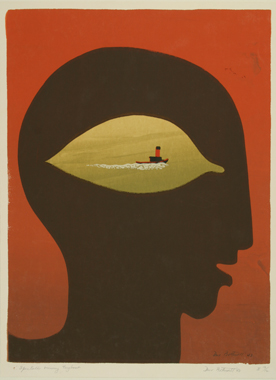
They’re now collector’s items.
In 1948 Marion Cunningham died suddenly and I realized I was the only professional artist in Northern California doing silkscreens. The process hit the Pacific Coast between 1943 and ‘44—then anybody who could read a book could try it, but it took a while to catch on.
A serigraph can be the start of an entire color scheme and I was hooked on serigraphy for life. In 1947 the Brooklyn Museum admitted a few silkscreens to its first annual print show. The following year I was awarded a purchase prize for my color silkscreen, Memory Machine, which also won first prize at an exhibition by the National Serigraph Society. This work was shown in the Brooklyn Museums retrospective, 30 Years of American Printmaking, in 1977.
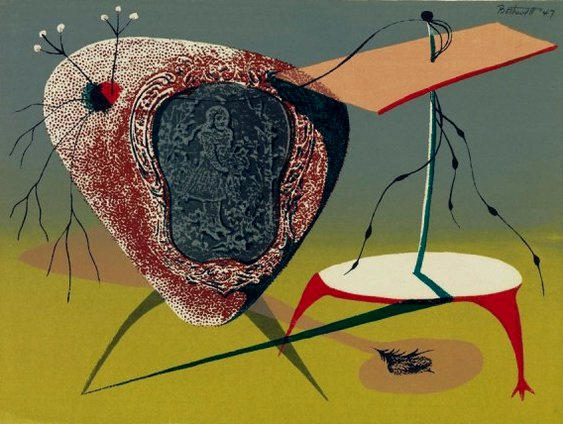
In 1944 my luck changed. By then the War had eased up and people were coming back. Somebody saw my incredible Dutch reproduction and told Douglas MacAgy, the new director of the California School of Fine Arts, about me. He was looking for a teacher. At that time the California School of Fine Arts (which later became the San Francisco Art Institute) was under the jurisdiction of the Board of Regents of the University of California and was run like the rest of the university, with university notebooks, grading methods, the whole thing.
I was hired to teach its first class of GI Bill students, people who’d been slightly wounded and been invalided out, or they’d recovered and did not go back.
But because of the GI Bill, many schools suddenly appeared with teachers who had no teaching credentials. So the school said that my course had to be approved by the Western College Board. Three people came to listen to me lecture and see the work that was being done. They approved me and after about a month the California School of Fine Arts had an approved teacher.
At first I was employed to teach only one course, for two semesters, but I was kept on because my course was the only one with a Western College Board rating. Then Ralph Du Casse was on the job and he had the rating. William Gaw had university training. Finally they built up a mixed bag of staff.
I taught Design and Color, which I knew because, thankfully, I’d studied with Rudolph Schaeffer. I was the only person teaching that course. I had a pretty secure slot, because the course was in-between the Graphic Arts Department—the so-called commercial artist and the so-called Fine Arts Department.
I taught at CSFA off and on from 1944 to 1961. For years I was the only woman teaching at the school. Except for Ralph Du Casse and David Parks, most of the male artists didn’t bother with me. Their talk and lack of intuition bored me. As for discrimination, well, I used the short form of my name so that you couldn’t tell I was a woman and I guess I was so dedicated that I didn’t know when I was being put down. Some of the men did try to shove me over in the corner to talk to their wives at faculty parties, when they deemed their four-letter words too crude for my sensitive ears.
During the late ‘40s there was a gallery in the City of Paris store in San Francisco called the Rotunda Gallery. I had numerous exhibits there, as did a number of my artist friends, and sold a lot of work.
Every seventh year, no matter what, I saved my money and gave myself a sabbatical. They didn’t give one, but I said, “Well I’m taking one.”
They said, “Well, we’ll see if we have room to take you on again when you come back.”
“That’s okay. Every seventh year I take off, period.” Which I did and always went abroad some place. I know all about cheap hotels.
During that time we had a big organization called the San Francisco Art Association. Every second year we had a huge show in the de Young Museum—took the whole museum and every person who painted in San Francisco was shown. There was no jury. We had the naive and the really awful things, but everything went in and it was very important.
1944-Twa Corbies serigraph
1944-Camping by the Shore serigraph
1944-Chicken Farm serigraph
1945-The Long Walk to Sunday School 1946-Blue Bones serigraph serigraph
1946-Ideograph serigraph
1946-Arrangement in Blue and Black
1946-Stag’s Heart colored pencils gouache on board/photo collage
1947-City Summer serigraph
1946-Mental Terrain oil on canvas Crocker Art Museum, gift of the Sisters of Nazareth, San Rafael, 2013
1947-Holiday serigraph
1947-Winds of Chance-2nd State serigraph
1947-Winds of Chance serigraph
1947-Magician’s Scarecrow serigraph-The Buck Collection
1947-Signs and Portents serigraph
1947-Magician’s Calling Card serigraph
1947-Comment on Fashion serigraph
1947-Magician’s Scarecrow II serigraph
1947-Exhibition National Gallery of Art, Washington, DCserigraph
1947–Promenade serigraph
1947-Memory Machine serigraph Dick S. Ramsay Fund, Brooklyn Museum
1940-Hollywood Success oil on canvasThe Fine Arts Museums of San Francisco
HOLLYWOOD SUCCESS
First of all, the person’s riding on a merry-go-round horse and I wanted to make sure they knew it was a carved wooden horse, so I painted it turquoise blue. Horses don’t come that color. The symbol of the carousel is that it goes round and round—it moves—but it never gets anywhere. And that’s also the symbol of the movie, the film goes round and round.
Kneeling in a body suit, with their head covered with a veil, is the movie star. Her body is covered up and her face is covered up, because nobody knows the real person. She takes any kind of role, she portrays characters. She’s holding in her hand an orchid. Now remember, this was painted the last part of the ‘30s, and in those days ladies going to the opera would wear an enormous orchid, that was a symbol of wealth and success. So she’s holding this up. And this flower also is a symbol of, in her case, of what she thinks is success, which will fade, because flowers fade. She’s supporting herself, she’s touching the ears of the horse to keep her balance. She’s precariously placed there, so she could fall at any moment. That’s it. I keep telling them that. To me it’s perfectly clear.
The de Young Museum owns Hollywood Success. They called me in. We had an appointment with not the curator but with the restorer. We were escorted all the way back. On a huge easel was my canvas. So I looked at it. By that time the head of the Department of American Painting and two curators and the restorer, whose name is Carl Grimm, I think, were there. So I went around and looked at the back. I said to the restorer, because I thought there was something that I was supposed to see, “This seems to be in pretty good condition. It’s still taut.” I rapped on the back of it. And I looked at all these people and everybody was standing looking at me. And I had this terrible sinking sensation that there was something I obviously was supposed to do and I hadn’t the foggiest idea of what it was. And I really thought, “What on earth?” And then, in answer to that, a mental question, something said to me, “Look at them.” I did. And I thought, “Of course! Only the restorer was born when you were painting that painting.” So I said very brightly to the restorer, “Would you like to know what materials I had to use in those days before permanent glues and that sort of thing.” “Oh, yes, yes,” he said and he ran and got his clipboard and uncapped his pen.
SELF PORTRAIT
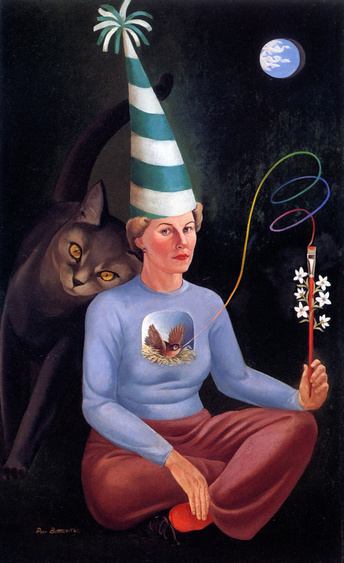
This is a canvas in which I’m seen sitting cross-legged. On my head is a dunce’s cap, white pointed cap with green stripes, symbolizing the fact that I as my own self can do nothing, that as an artist I obey whatever impulse comes to me. Next is the niche in my chest, which has a little bird in it. That’s the blue bird of happiness. All my symbols are very humble, and popular—they’re not fancy or anything like that. I have the bluebird of happiness in my chest and its song becomes a spectrum of colors, the spectrum of light, which comes out of the narrow band, turns a couple of times, and lands on top of my brush, which is held upright as a sceptre. The brush immediately bursts into bloom, with blossoms that look like apple blossoms—in other words, blooms that will bear fruit. That’s the main theme. Back of me, blending in with the background, is a large cat, head, part of its body, because the cat in my mind symbolizes mystery. On the other side is the moon, also symbolizing mystery. So this is a self portrait of an artist.
Actually I’m right-handed, but in painting this thing it made a better composition to have the brush in the left hand. I tried different compositions and I finally decided that this was the best, and since I my own self could do nothing, putting the brush in my left hand was also a symbol that it was not my daily hand.
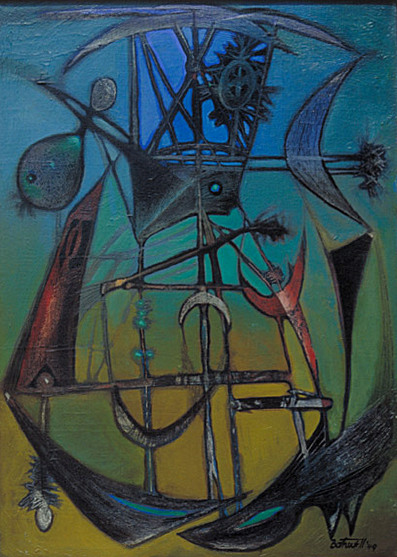
1949-Moon Fetish Machine oil on canvas
THE PATHS TO MENDOCINO & NOTAN
In 1948, I didn’t take a sabbatical, but I took a summer vacation. That was after the War, when you could go to Europe, even if you didn’t have relatives there. I went to England and mostly to France, did some touring around Italy, and after three months abroad came back to my job.
Then I applied for and got the Abraham Rosenberg Traveling Fellowship for creative work. You had to have a theme and mine was the animistic quality of Moyenesque decorative sculpture of the Middle Ages. It was a perfectly good subject. In cathedrals, for example, the handle on the door, on the inside—you look at it and it was a perfectly good wrought-iron handle but the closer you look at it, it had a head and the little paws were the places where they put the screws—the handle was an animal.
What I was so impressed with was the way the great hinges on a cathedral door would start out in a hinge, then turn into flowers and leaves. The main hinge was maybe 18” long, but it was 3’ long by the time it was finished with the flowers. Because in the 12th century everything was alive in the cathedral; it was a living thing and I felt that nobody had really appreciated this. So I did a whole slew of measured drawings of animals and facades of churches that had the same animistic quality of art. No one had proposed anything like that before to the Rosenberg Foundation.
1949-Finial of Iron Hinge Eglise de la Madeleine, Vezelay (Bourgogne)
Iron Hasp from door to Narthex
Head of Gold Crosier, Chinon (Val de Loire)
The $1500 fellowship was only for one year but I took every cent I had out of the bank and thought, “Okay, dividing it in three parts, I’m going to live in France for three years.” Which I did, but the last year I was living about the way the poorest French student did, by walking every place, which was wonderful. Because I must say that I know Paris from taking footsteps all through it.
I went to Europe in 1949 on a freighter, a liberty ship the United States had given to France. The captain, 50-some-odd, was filling out his captaincy. He was soon to retire, but needed a few more trips. He had been the captain of a luxury cruise ship that went to Indochina. My cabin boy had worked on the Normandy. The first mate had come from another ship. They were all trying to get their licenses. This was an elegant, but mixed-pickle crew on this awful tub, called Pont-l’ƒvque —they had given it the name of a French cheese!
Head of Gold Crosier, Chinon (Val de Loire)
The first night in the dining room the captain very politely said, both in French and in English, “There will be no English spoken in the dining room.” Of course, the captain’s word is law. Well, I knew a little bit from having been in France but I did not speak conversational French.
They took 12 passengers. Another woman and I had the chief gunnery officer’s cabin, which was very nice because it had little bunks with built-in drawers underneath. It was crude, but okay. It was terribly rough going out the Golden Gate. But when I had a chance to travel on a boat, I would. Besides, it cost less to travel on a freighter.
In 1949 there was no regular air service across the Atlantic. The train to New York was expensive. A passenger ship to France was expensive.
Freighters were hard to get and they didn’t like to take women passengers because, after the War, they carried beef cattle, trying to replenish Normandy. Was that because it was thought too smelly for women?
So it was cheaper to get on a freighter and leave from San Francisco—but it was slow—it took 48 days. We went down the Coast, took on mining timbers, then machinery and two jeeps in San Diego. Before we went through the Panama Canal, we picked up 200,000 sacks of green coffee beans in El Salvador—that loaded the ship. Green coffee beans don’t smell so good. But it got worse.
1949-Keepsake from Panama oil on canvas
At Aruba the ship loaded bales of raw hides from Venezuela, to carry to Africa—Leopoldville in the Belgian Congo. Also something that makes you vomit, ipecac, an herb with a strong odor. We encountered a terrible storm in the middle of the Caribbean and received orders not to go to Africa but go directly to La Havre.
This was wonderful, particularly after a storm that was like a curtain of glass beads. You couldn’t see anything beyond it. It just fell on us and the ship began to roll and pitch. All the glass in the dining room was broken and even some of the glass in the upper bridge from the waves. Everything had to be tied down. You hung on to ropes. You couldn’t go out. The Captain said, “Oh, look at her now, she’s almost a submarine.” Sure enough, her nose would go in the waves, then she’d sort of shudder and finally the nose would come up and all this wash would go through it. We finally got to France, but they could smell us coming.
After those many days at sea, I was so excited to see land. Two tugs came out to get us at La Havre but it took all day to dock, because there were still live mines and hulks of bombed ships in the harbor. It was a tortuous thing, one tug aft and one tug fore, weaving the Pont-l’ƒvque in. Because we were a commercial ship, we had to go to a commercial loading dock. There was only one or two undamaged from the War where they could berth.
When we could finally see La Havre, we were sitting on deck. I jumped up, having forgotten they had opened the portholes, which had been closed during the terrible weather. I hit myself straight between the eyes on this brass porthole. I sat back and for a few moments really saw stars. By that time it was 10:30 at night. We were getting off the ship and trying to catch the last train out to Paris, which left at 11:30. We finally got onto the train. I didn’t know anybody, because everyone else had scattered.
I had made arrangements to stay at the Fondation des ƒtats Unis. I knew exactly how to get there, because I’d stayed there before. When I got off the train, the Metro wasn’t running and I had to pay double for a taxi. By the time I finally got out there and rang the bell, it was 12:30 going on 1:00 in the morning. The Russian who came to the door didn’t remember me and wouldn’t let me in. I had to show my letters from the American director before he opened the door. I was supposed to have a suite, but the only room available was on the ground floor and I’d have to share it with somebody else for that night. He kept looking at me strangely.
I was dog-tired and my head hurt. I just took my clothes off and fell into bed. I didn’t even clean my teeth or unpack. All I could do was to lie down. I did leave the light on, because I didn’t want my roommate to be frightened when she came in and saw someone in bed.
About two o’clock in the morning a girl came in and I heard her yell, “Ahhh!” I sat up and again she gasped, ”Ahhh.”
1950-Antibes serigraph
1950-Marseillespen & ink & oil on paper
I said, “What’s the matter. I’m sorry, they didn’t tell you?” “What’s wrong with you?” she asked.
“Nothing.” I said. “Have you looked at yourself?”
“No.”
“Get up and look at your self in the mirror,” she said.
I looked at myself. I knew my face was swollen, but I had two black eyes and looked like the The Mad Woman of Chaillot—absolutely blue-black eyes and this black egg. The most disreputable looking person I had ever seen! I laughed and said, “Really, I don’t always look this way and I’m harmless. I know I look terrible.”
“Well,” she said, “you gave me an awful start.”
That was what happened when I got to France.
I spent the next three years in Paris. I did the measured drawings down the Route d’ Bourgogne. My main base was a studio in Vezelay, where I painted and did silkscreen prints.
When I went to France I took all my silkscreen stuff over. In 1950, having made some prints, I went to the Societe de Gravure Francais and showed them the whole process and tools, diagrammed it for them. They said they would take it up at their next meeting. They met and said that they were very sorry, but it was a reproductive process and they could not put their stamp on it as a fine art medium. This was 1950 and I’m not kidding!
When I left France in 1951 they were admitting serigraphs to print shows. And I understand that about 1955 the graphics arts people broke down and admitted it as a fine art medium.
And this follows a pattern. Look at lithography. It was a commercial medium and people thought that Toulouse-Lautrec was just off the wall using it. Well, when Daumier started doing them, people thought he was mad! They didn’t think they were Art, because they were done in a cheap reproductive medium. Yet eventually Bonnard and others began making lithographs.
The same thing happened with silkscreen. You’d be surprised how you can be rejected. In those early days in the forties we had a meeting of very good printmakers in different methods. One of them asked me, “What are you doing here, Bothwell?”
“I’m a printmaker, too.”
“Oh, what are you doing?”
“Serigraphs.”
“Ugh!” is the sound he made.
So I left. No point in being there.
•
I came back from France in 1952 and taught at the Parsons School of Design in New York City. The person teaching Design for Mass Production in the Design Department got sick, so I stepped into a nice job. I was going to stay in New York—I had a studio and everything, but I just couldn’t stand the pace. I didn’t like the feeling of the knuckles in the back when I stood in line to get on a bus or that impatience and that grim, worry, worry sort of thing. Everybody seemed so worried—I couldn’t stand it!
I stayed with Dorothy Liebes, the weaver, a California girl and an early female textile designer during the late ‘30s and ‘40s. She had married a big storeowner, then moved to New York. Eisenhower was campaigning and Dorothy’s husband was away working on the political campaign. She didn’t want to come in to an empty apartment, and didn’t like a live-in maid, so I earned my rent that way. It was a good location.
I did all right. I had two shows in New York. As a result I have things owned in museums in the East. The purchase prize at the Brooklyn Museum, of course, and the Whitney Museum took one of my canvasses. The Fogg Museum in Cambridge has a couple of drawings. The Metropolitan Museum has two of my serigraphs, one it has owned since the late ‘50s, the other purchased recently. I had a proof left of the 1947 prize winning serigraph from the Brooklyn Museum and a dealer in New York sold it to the Metropolitan.
I took my class to the Metropolitan Museum to study tapestries, which was wonderful because the cases were open for us, where you could have the actual things put in front of you when you were designing.
New York was interesting and there was all the theater. But the knuckles in the back were a true thing. I didn’t want to stay. It was terribly pushy. The Art people were always figuring angles. I didn’t like it. I wasn’t broke or anything. I just felt that there was a very negative worry thing. They were talking money; they wanted to get ahead. They had these rigid patterns, like the five o’clock martini. Artists sat around drinking beer or big jugs of wine, talking gobbledegook. I didn’t go in for that.
I came back to San Francisco in 1953 and got a job back at the art school and taught there under various directors until it became the San Francisco Art Institute.
1950-Nostalgia oil on canvas
A studio became vacant in the building once owned by Melvin Belli. This was in a double building on Montgomery Street, joined together on the street floor by a big Chinese sweat shop. My studio was a huge two-story room, with colorful gallery walls, drawers for prints and an easel, a book-filled corner and a balconied bedroom.
I lived all through that block. It was my home for years. There was no hot water there and only the most necessary appliances—no refrigerator, because I don’t like the noise, and the only heat was from a small wood stove below the skylight.
I don’t remember how I met him—it was a long time ago—but Charles Stevenson’s studio was in 726 and I lived in 728. I had a friend whose studio windows faced his studio windows. When I would call on her we could rap and get Charles attention, and in that way we could get together occasionally.
Charles is a very accomplished artist. He has this ability to draw anything. He knows all the different printing processes, all the mechanics. After he returned from the Navy, he opened a commercial studio. Then he realized that what he wanted to be was a Fine Artist and paint in oils. Eventually, that’s what he did.
During this time I went through a period of self-examination as an artist, which resulted in fundamental conclusions about what I felt were the sources of my art and my reasons for being a painter. Teaching was terrifically stimulating. It gave me a lot of courage. It made me examine myself as to why I reacted to certain things the way I did. Why did this trouble me, analyzing habit? Was it because I naturally liked things in order. To me, nature has a terrific order. There’s disorder too, but there’s also an underlying order in nature and I’ve always been so interested in and influenced by nature. I didn’t realize it too much at the time. So I examined my own feelings and actually had the courage to try new ways.
When I was in Europe I spent a year doing all sorts of mad, crazy kind of things. I destroyed them all. There were none left. They were experiments. It’s just like you want to see if you can turn handsprings, too. I just wanted to see where my limitations were. If I found something I didn’t think I wanted to do, I did it just to make sure. It was like people who say, “Oh, I don’t eat olives,” and you say ”Have you ever tasted one?” “Oh, no, but I just know I wouldn’t like them.”
1953-Invasion oil on masonite
We all have that. Those kinds of little areas within us and I wanted to make sure I wasn’t refusing these olives because I thought I wouldn’t like them. I went around, tested them and tried them.
And I think it’s very stimulating to teach in an up-and-coming art school. Very. Even the conflict was fine. I knew when I got through, that there were certain things that I really and truly believed in. I didn’t care if the whole art world or the whole cosmos went the other way—these were things I believed and that was it and I would hang on to them.
I think most of the instructors felt that way. They came up against themselves and they could sort out what was prejudice and what they really and truly believed in.
For me, it was nature. I realized that when I came back. I said, “Well, I know what I am now. I’m nothing but an English landscape painter.” I knew I had my British background and I knew that was just what I am. I never do landscapes but I put it down that way because I realized that I could never throw nature out. To me, it’s everything. We’re part of it. Everything stems from it.
And the intellectual manipulations and assumptions and everything mean absolutely nothing to me. Unless I feel that there is something in nature that people are missing and that I can call their attention to, no matter by what means, these intellectual constructions mean nothing.
•
I taught three more years there, spent a year in England, then moved to Mendocino, a town on the California coast, 140 miles north of San Francisco. We’re up to 1960. When Bill Zacha was in the Navy he studied under Helen Schoeni, who was in my class in art school. I hadn’t seen her for 25 years. About 1960 he wrote to Helen, telling her that he was opening an art center in Mendocino. Who would she recommend to teach painting?
Helen said, “Well, if Dorr Bothwell is still in the Bay area, ask her—she’s a good artist.”
So Bill wrote me, but I had made arrangements to live that year in England, on sabbatical. “Did I know anyone else?” he wanted to know.
I had known Hilda Pertha for years. She had a studio in San Francisco and was exhibiting at Gumps Gallery. She had taught sculpture in Philadelphia during the 1930s. I contacted Hilda and she agreed to save the job for me until my return. Which she did.
Then Bill asked her to teach the advanced students the following year. While I was in England I got a letter from her saying how much she loved Mendocino and that she had moved there. I thought she’d lost her mind, although she had been born in a country place in New Jersey. The next summer, in 1961, I came up to Mendocino to teach and could see the charm of the place. Bill Zacha was remodeling the house on the corner of Albion and Kasten Streets. It had been an old shed, covered with rusted, corrugated iron, where fishermen stored their gear. In those years Mendocino was down in the dumps—you don’t know how much! It wasn’t the attraction it is today.
1957-The Burning Bush acrylicThe Tregoning Collection
It was one of those really gorgeous early August evenings. Just a perfect day: not too warm, not too cold, no breeze. It was dusk and Bill and I were talking about studios. I said, “I’ve always had a dream studio,” and described it to him.
“Say no more,” Bill said. “Say no more. It’s on the boards.”
I asked, “What do you mean?”
“Come on, I’ll show you. I’ll show you where it is.”
So he walks me down to this terrible, rusty old falling-in building with the peaked roof—a dilapidated shack. He gets the front door open with his shoulder and we go in. It’s so old and full of dust, the kind of black dust that if you just breathe, it floats up and hangs in the air.
I told him that I always wanted a balcony for the living quarters, with the studio down below. We went up this rickety stair—it wasn’t a staircase, just a sort of built ladder leaning against this platform, covered with an inch of dust. “Here’s where we will put the sink,” he said, “and we’ll put the bathroom there and this will be the bed corner and it will be your living room.” He had visualized the whole thing.
“Well,” I said, “I have to have a skylight on the north side and a sink downstairs, because in my studio I always need a sink.” I don’t think Bill ever had a proper studio before, so he wasn’t too familiar with what you really need. “I’ll be doing silkscreen prints and I need a sink to wash the screens.” He said that was fine.
1961-Art Center Pump watercolor
I went down to San Francisco that weekend and I thought, “Well, this is it. If the director of the school isn’t home, I don’t have to think about this. If he is home, I’ll tell him I’m going to quit. I phoned him and, sure enough, it was a Sunday and he was home. This was Gurdon Woods, the director of the San Francisco Art Institute.
I said to him, “Are you sitting down?”
“No, should I?” he said.
“You had better sit down. I’m going to quit teaching and move to Mendocino.”
Then he said, “WHAT! You can’t go.”
I said, “What do you mean, I can’t go?”
“You have to finish the fall term.”
“Okay, I’ll finish the fall term, then I’ll leave.”
When I got back to Mendocino, I told Bill what I’d done and he turned a kind of a pale green. I don’t think he really intended to build the studio quite so soon. I said I’d be up the following February. Could he have the studio done by then? He said he thought he could.
I kept calling him and writing him and he said things were coming along. Finally I called and said, “Okay, I’m coming tomorrow.” He had laid vinyl tiles in the northeastern corner of the studio. There was just room enough for us to walk in and pile all the boxes there.
It was another three months before I could move in. The top floor had a small bed and bath area and a tiny kitchen. It had an 8-foot picture window and a 14foot balcony. A large studio, with a small office under the stairs, was in the street floor. I don’t think one should live and work in the same area. It was my dream studio and I knew it was the right thing, because there was a place prepared for me.
My friend Rebecca Weinstock owned a house she was trying to sell and she months and show people around when you send them up.” So that’s what happened. I finally moved into my studio at the end of that time.
I sold most of my work before I left San Francisco. It made such a wonderful illumination—burning all my bridges behind me.
Before I left the Bay Area, the Marin Society of Artists had a big show and I was a juror. Jim Bertram was a member of the Society and helped carry paintings before the jury. At intermission he asked me what I was doing. I said, “I’m leaving San Francisco and moving up to Mendocino.”
“You are!”
I think he’d been there once before. He said he might come to visit me. I forgot all about it. Charles Stevenson also said he might come up.
Some time later, after I had moved, I was walking down Kasten Street, and here comes somebody I vaguely remembered. He said, “Don’t you remember? I’m Jim Bertram.”
“Oh,” I said, “Fill me in a little more.” “You were talking about Mendocino.” “Yes, you were bringing in the paintings in Marin.”
About a week later I was walking down the street, and here comes a young man I’d never seen before in my life—a vivid bleached blond! Then I took a second look and couldn’t believe it! It was Charles Stevenson.
Somebody had talked him into bleaching his hair. He had been naturally blond when I first knew him, but it had gotten darker. Of course, when you bleach you can’t undo it. He said he had just moved to Mendocino.
“Why,” I asked, “because you bleached your hair?” “No, no, I decided to move up here to paint full time.”
Here were these two people coming to Mendocino within six months of each other. Hilda had come up the year before needed somebody to stay there. I said, and I felt instrumental in it all.
1962-Cat from Mexico
****“Fine, I’ll camp there for the next three serigraph
1962-63 THE INNER MEANING OF THE LETTERS OF THE ALPHABET AS SUGGESTED IN THEIR FORMS OR SHAPES
The Letter T
“T” stands for a tie or terminal. It is that which holds the opposites together. It is shown holding the two ends of a single circuit together. We express this in language. We put an animal in a pen and close the gate, and say the animal is pent. It is a mediator.
The Letter A
“A” stands for the infinite activity of the Absolute. It also stands for a single one. It is shown as a triangle, denoting Trinity. The cross bar of the A is a balance or scale, a symbol of polarity. This idea is further described by the various design elements. The Omega is joined to the A or triangle so that the beginning and ending is one Absolute.
The Letter U
“U” stands for the chalice or urn and is shown containing all the elements, fire, water, earth and air. It is supported by the Omega. It stands for the Thought Maid which is filled by Faith, which is the “substance of things hoped for, the evidence of things not seen.” This substance is knit together in the U, to produce units or U-knits, i.e. forms.
If these values are assigned to the T, A, and U of the great word TAU, its meaning is expanded to stand for That which Aldous Huxiey describes as “The divinely impartial One in which the polar opposites are reconciled.”
1965-Drawing The Inner Meaning of the Alphabet, second series-Photograph by Bill Foote
1963-Roses in Winter Mendocino Fences Series oil on canvas
What struck me about Mendocino were the fences—that wonderful, weathered, bleached wood. So sensitive, so beautiful. I did a whole series of close-ups of the wood, about 30 paintings of fences. That show was in San Francisco at the de Young, as well as in Mendocino, and it sold out. Two years later I had another show.
The very tempo of living there has influenced my art. I think there’s a magic in that place, something very special, that some people call a kind of power center, like Mount Shasta. And I think that this was the moving spirit of Bill Zacha, that remarkable catalyst.
Starting in 1961 I taught summers at the Art Center in Mendocino. The first year the interior hadn’t been finished, the wiring was hanging down, we had no blackboards. I taught Notan, Color and Design. These were very basic classes, composition and things like that—the basic foundation stones, as it were, to build any kind of artistic career, whether its quilts or tapestry or whatever.
The first week was Contour Drawing. That’s drawing using your tactile sense. Today we are being forced to see faster and faster. The faster you glance at things, you only have time to identify and classify. When it comes to drawing, it’s a different speed. You have to draw as if you were touching the thing you’re drawing, to use less intellect, to ‘feel’ art instead.
Then Slow Drawing. We applied this theory or method to some things that you really can’t touch, like landscape. Your eye can project over it and if you slow down you can feel the shape of the hills, feel the shape of the trees. It makes for a more secure way of drawing.
I showed them the interaction of negative-positive space and symmetric balance. I discussed the clarity of color. And, finally, how they can find color evocation. By the time we were through with the course they were able to realize the reasons of color and mass. They received that extra communication of art and they realized why they are studying painting. Many of the class members had never drawn before, but they finished the 15-hour course doing drawing. Some even did portraits.
Notan is the negative/positive or dark/light design. It’s the interaction of negative and positive space. My class, covered the essential fundamentals for all artists and craftspeople, consisting of the completion of five problems: the first deals with asymmetrical or occult balance; the second and third problems explore the interaction of negative and positive space expressed in asymmetrical pattern; the fourth and fifth problems use symmetrical shapes to create Notan.
This spatial interaction has been important in the study of children who are slow to read. For example, a child had trouble seeing a big, black ‘A’ printed on a white card. Some children didn’t know what to look at—the shape or the background. They changed the color of the letters to red on white, which doesn’t make such a sharp contrast as black on white. Then it was easier for children to see the shape of the letters because it attracted their attention. The children had been seeing the negative before the positive.
1963-No Thoroughfare serigraph
1963-Mendocino Fence acrylic
This is applied to painting. It’s an interesting course and anyone can do it. We’re not painting. We’re cutting things out of paper and gluing them. The philosophy behind it is the importance of the negative. In my course we talk about the thing-ness of things and no-thing. Artists have to paint the background. You can’t just leave a hole.
For example, our whole culture paid no attention to the air. We threw anything into it because it was a no-thing. Now the air has become some-thing and its about to poison us. We did the same with the ocean.
My book, Notan: The Dark-Light Principal of Design tries to explain all this. Notan is a Japanese word meaning dark/ light. The theory is that opposites don’t conflict, they complement. It was first written about by American artist Arthur Dow, who studied what was happening in Asian Art, and he began to apply it to Western Art in the early 1900s.
In San Francisco in 1920 Rudolph Schaeffer combined what Dow had been teaching, with what some designers taught in the East, and began teaching a class in Notan. Rudy was a wonderful person. He died a few years ago at age 103, with all his marbles.
Rudolph Schaeffer was my greatest influence. He encouraged me to befriend color and taught me how to “see.” He not only made you see color, but made you see design and see pattern in nature, see that there is design and order in everything around you.
As a result, l developed a special way of seeing. I have a view which helps me to see how carefully everything is integrated. Schaeffer also taught you how to mix those colors, how to get them. They weren’t something that you struggled with. They were friends.
1964-Mendocino Fences-Zacha Roses oil
My kinship with color led to a deeper dedication, which resulted in a clear definition of color, pigment and light. Color is a neural sensation. Pigment is something else again; it’s a substance that reflects the vibrations of light to the eye; those vibrations affect us just the way the vibrations of music do—they become part of you. Color does the same thing, but light is instantaneous. It works so fast we have a tendency to think that the colors are out there. But we put them out there ourselves.
I studied with him and also, of course, taught at his school. I didn’t invent any of this. I’m teaching what Rudolph taught. I expected him to write the book, but he wouldn’t so I told him that I would.
I’ve taught Notan over 50 times, even in England in 1971, at the London Teachers Residential Centre at Stoke d’Abernon, Surrey.
I also taught with Ansel Adams for 14 years, from 1964 to 1978, at his Yosemite photography workshops, teaching Composition and Notan. I only stopped teaching there after he had his first heart attack, when he stopped giving the workshops.
It was two weeks in Yosemite. People came from all over and there was great resistance from the photographers— ”who’s this old person teaching this, we didn’t come here for this—we’ve flown 7,000 miles to get here to go out and photograph the scenery with Ansel. What are we doing in a classroom?” But Ansel said that they should, that it was good for them.
It immediately makes you conscious of the background that surrounds the object that you’re going to photograph, whereas most people, when they’re looking at the person, they don’t really see what’s happening in the background. Telephone poles come out of the top of their heads and things are on their shoulders. So this kind of course made them very sensitive to that.
NOTAN AND THE INNOCENT EYE
NO means black or night in Japanese and TAN is light or day. So it’s the interaction. We know most of this sub-consciously, but our training now is to go so fast that the subconscious mind works on a different time schedule.
Creative observation of our surroundings revives in us a sense of the wonder of life. Much of the discovery involves the recovery of something that we all once had in childhood. When we were very young we were all artists. We all came into this world with the doors of perception wide open. Everything was a delightful surprise.
Everything, at first, required the slow, loving touch of our tongues and our hands. Long before we could speak, we knew the comfort of our mother’s warm body, the delightful feel of a furry toy. Smooth and rough surfaces, things cold and hot surprised and charmed us. Touch by touch we built up our store of tactile impressions, keenly sensed in minute detail.
Later on, this tactile sensing was transferred to our eyes, and through the sense of vision we were able to “feel” things beyond the grasp of our hands. This kind of seeing was not the rapid sophisticated eye-sweep of the efficient fact-finding adult. This kind of seeing was a slow, uncritical examination in depth. The more we looked, the more lovely and surprising things appeared, until we were pervaded by that wordless thrill which is the sense of wonder.
None of us has lost our store of tactile memories. Nor have we lost our sense of wonder. All that’s happened is that we have substituted identifying and labeling, which can be done very rapidly, for the tactile sort of feel-seeing that requires much more time and concentration. For example, if you were asked to look at the edge of your desk and estimate its length, it would only take you a few seconds to flick your eyes back and forth and say that it’s so many inches long. But suppose you were asked to run the tip of your finger along the edge of the desk and count every tiny scratch? You would press your finger along the edge and move it very, very slowly, and your eye would move no faster than your finger. This slow, concentrated way of feeling and seeing is the first step towards regaining our sense of wonder.
There was a time when people moved no faster than their feet (or the feet of some animal that carried them). During that period, the artistic or creative spirit seemed to have free expression. Today, in order to be creative and yet move smoothly and efficiently through our fast-paced world, we must be able to function at two different speeds. The mistake we’ve made, often with tragic results, is to try to do all our living at the speed our machines have imposed upon us.
In order to live at this speed we must-scan the surface of things, pick out the most striking aspects and disregard secondary features. There’s certainly nothing wrong in this if we’re driving on a busy highway. But when we allow this pressure to invade every aspect of our lives, we begin to lose touch, to have a feeling that we’re missing something.
We’re hungry for we don’t know what. When that happens, we’ve begun to suffer from aesthetic malnutrition. Fortunately, the cure for this condition is very pleasant, and although it takes a little self-discipline at the beginning, the results are worth the effort.
When we see the world as design artists see it, we become especially aware of the interaction between positive and negative space. In architecture we become suddenly aware of the spaces between the windows; at the ballet we notice how the paces between the dancers open and close; and in music we realize that rhythm is made by the shapes of silence between the notes.
Everywhere we look we see this principle in action. Trees are not silhouetted against blank air, but hold blue patterns between their leaves while the branches frame living shapes of sky. We delight in the openings between the leaves of a plant or the spokes of a wheel. This endless exchange between form and space excites us. Once more we feel in touch with our world; our aesthetic sense is being fed and we are comforted.
We may have been taught that butterflies are lovely and toads are ugly, without really examining it to find out if what we had been taught is true. Or we are taught that flowers are good and weeds are bad, so we pull up the latter without a glance. To the artist’s eye there is no good or bad—there is just the inappropriate. In the garden, weeds are not appropriate, but in an open field they offer a world of delight. And after we’ve learned to see the
beauty in weeds, even though we have to pull them out of the garden, we can first admire their design.
When no preconceived ideas keep us from looking and we take all the time we need to really feel what we see —when we are able to do that—the universe opens up and we catch our breath in awe at the incredible complexity of design in the humblest things. It is only when this happens that we regain
In this rectangle which has been expanded asymmetrically, a counter-point is set up between straight and curved forms, giving a are ugly, without re-pleasing sense of balance. ally examining it to find out if what we had been taught is true. Or we are taught that flowers are good and weeds are bad, so we pull up the latter without a glance. To the artist’s eye there is no good or bad—there is just the inappropriate. In the garden, weeds are not appropriate, but in an open field they offer a world of delight. And after we’ve learned to see the beauty in weeds, even though we have to pull them out of the garden, we can first admire their design. When no preconceived ideas keep us from looking and we take all the time we need to really feel what we see—when we are able to do that—the universe opens up and we catch our breath in awe at the incredible complexity of design in the humblest things. It is only when this happens that we regain our sense of wonder.
(Text and illustrations taken from Notan, the Dark-Light Principle of Design, Dover Publications, 1971.
1949-The Juggler serigraph
1949-Night Thoughts on Marsh Creatures-oil on canvas
1950-The Owl of Minerva monoprint
1950-Homage to Martha Graham
1950-Corsica serigraph monoprint
1950-Homage to Helen Tamiris monoprint
1951-End of Summer serigraph
1951-Skater’s Rink serigraph
1953-Blue Quiet oil on canvas
1954-Cinnamon Sea serigraph Victoria and Albert Museum, London
1955-One Thousand Palms 1954-The Butano Forest Winter No. 2 gouache on paper
1955-Title Unknown oil
1955-Summer’s Sampler serigraph
1957-Bird Refuge#2 serigraph
1957-Monument Found on Mars oil on canvas
1957-Title Unknown gouache
1957-Bird Refuge serigraph
1957-Oak Creek Canyon oil on canvas
1962-Watchword #4
1961-Sunrise Summer serigraph
1964-Love
1964-California Wild Mustard serigraph
1968-Still Life with Figs oil on canvas
AND I NEVER STOPPED TRAVELING
I never stopped traveling. Lack of money has never cramped my style. I never question the possibility of going. The way just comes.
I believe that wherever you’ve lived long enough mentally, your body will follow. If I want to go to Paris and have no money, I go to bed for a week and pretend I’m on the ship and go to sleep in the mood of satisfaction that I’m on my way to Paris.
The second week I envision myself sitting at one of my favorite sidewalk cafes and then the next thing I know, something turns up and I am there. Something clicks in the universe.
In 1961 I made rubbings of 12th century granite church floor gravestones in France and had a studio in an ancient abbey clock tower in Herfordshire, England. I fell in love with the English coloring. We don’t have their colors. We don’t have those creamy skies and that color of green.
1965-Watchwork Rest serigraph
I went to Nigeria and Tunisia in 1966-1967 and produced a slide documentary of indigo dyeing and design, pottery and weaving.
The trip to Africa in 1966 was a real adventure. I knew a painter there, Phyllis Rees, whose husband was a Harvard professor. He was employed by the Nigerian government to redo the curriculum of the former British high schools, which had prepared the chiefs’ sons to sit around and do nothing. The first thing Peter Rees did was import people with different skills and begin an educational aid program.
I was there for almost a year, in Abeokuta, the little Nigerian town where they lived. I was writing the last chapter of my Notan book, which was coming out in paperback, and the publisher wanted some more pages (actually that was about the only straight writing I did—Marlys Mayfield did the rest).
But my friend Phyllis wasn’t getting any work done. She didn’t like to go out sketching alone. She was uncomfortable in Africa.
Of course, it didn’t terrify me at all. People kept telling me about vipers and six-inch scorpions and cobras, but I never saw anything. I was looking at the weaving and the dying and the pottery. It wasn’t really wild Africa. It was safe. This was before the horrors in Biafra began.
That part of Nigeria is about 60 miles inland from the Atlantic Coast. The people were charming, with lovely manners, soft voices. I was interested in their techniques of making pottery without a coil or wheel, and the weaving, which was in long strips and used indigo starch—resistant dyes. The Yoruba-speaking people grow indigo plants, dye cotton by applying a special starch, paint in the dye in intricate designs and wash away the starch. It took me a long time to convince them I wasn’t trying to steal their process. I brought back a few decorative pieces that I made for wall hangings.
When Peter’s contract was up, it was time for us to leave, and we decided not to take a plane out. Peter bought a second hand VW van, to drive out. We went the back way, through the Sahara, from Nigeria, through western Niger, then from the bottom to the top of Algeria—the completely long way across the Sahara, then to Tunisia. The trip took 21 days. The most interesting experience, the high point, was when we encountered nomadic Tuareg people at night.
Peter hired a Peace Corps boy to come with us. This was January, 1966, a year before the Six-Day War between Israel and the Arab League, but the Peace Corps men and women were already leaving Arab League countries. We were heading for Tunis, in Tunisia, which is not part of the Arab League.
1965-Conservatory oil on canvas
There were five of us: myself, the Peace Corps boy, Dr. and Mrs. Rees and their three-year-old child. We drove into upper Nigeria, where a different type of people live, then into French-speaking Niger, which is along the Niger River, with wonderful houses decorated with fancy mud patterns. After we left Niger we crossed the border into Algeria.
This is open desert, the Sahara Desert. There are two tribes of Tuareg, nomadic people who speak their own languages—only a few people know anything about them. In earlier days, when the French controlled the Sahara, if you went through their territory you told the French commandant stationed there that you were going to go into the Sahara and what your destination was. He would radio ahead to the next post to expect you. If you didn’t come in a reasonable time they would send out a dromedary, a fast racing camel, on a search, because that meant something had happened to you. Perhaps your car was bogged down, and maybe a camel could drag it out of the sand.
But the French had pulled out when we went into the Sahara and it was controlled by the government of whatever province we were in. We were in Algeria, so the Algerians, who were Arabs, governed. They didn’t care a bit. We didn’t have to report to anybody.
We were all on our own, with various oases about 200 miles apart. You cross the border—it looked like something out of a Foreign Legion movie, slatternly women cooking, the soldiers with unbuttoned uniforms. They wanted us to stay at the camp, but we thought we’d probably be robbed blind. So we filled out the papers, kept on driving, and put a hundred miles between us.
There was a big oasis in a wilder section, getting up towards the center of Algeria. It was almost trackless—there are no real roads, so we used a compass. It was January. Although there was no water, the desert froze, hardened. We generally tried to start early in the morning, so we could drive faster on the hard desert sand. This particular time there was very deep sand and you could see that a great lorry or truck had gotten stuck. They had tried to get it out of the sand by using wide thick planks but these had broken into smithereens.
The weather was cold, so we picked up all the wood we could and indulged ourselves that night. Generally we ate before the sun set. That night we ate a little later and built a big pointed, teepee-shaped fire, with a little bit inside.
We always finished our dinners with something hot to drink. Just as we were about to have tea, there was a sudden movement. In the firelight we could see these people, dressed in black, in dark navy blue—it’s overdyed indigo cloth, which also shines kind of brownish-purple, almost iridescent because it’s so heavily dyed. They’re called ‘blue people.’ Because they don’t have enough water, they oil their skin, which picks up the excess dye. So they appear darker than they really are.
It was a man and his wife. Of course, you see nothing but their eyes, because they were completely veiled. She wore big, heavy silver earrings and bracelets.
They came into our camp carrying a shallow basin, with either asses’ milk, sheeps’ milk or even donkeys’ milk in it. From living in Africa my friends knew that any time you’re offered something like that, you have to take it. You can’t just put it away—we were supposed to drink it.
1966-67-From African Sketchbook
1966-67-From African Sketchbook
Phyllis, she just sort of disappeared. Peter, a PhD and all, a big tall guy, said, “I’m game if you are.”
“Oh yes, we have to.” I said.
The man didn’t do anything. His wife picked the bowl up and handed it to me.
I could see what they were thinking, that we were on the same level and I was the grandmother—that this was my son and his wife, that the Peace Corps boy was perhaps a younger brother—that we were a family.
I took a sip and handed it to Peter.
Peter took a sip. I said, “We’ll fix the tea up and put loads of sugar in it, because they’ll accept that.” We didn’t have the terribly strong tea that I knew they drank.
We made the tea stronger than usual and I put all our the sugar in. We had enamelware cups. I offered a cup to the woman. I knew she would pass it to the man. She took the cup of tea and gave it to her husband. I bowed to both of them. The Peace Corps boy stood behind me, holding three cups of tea. I gave her a cup; the other went to Peter. Because we were one cup short, the Peace Corps boy gave me his cup.
The Peace Corps boy had the spoon— he stirred the cup, handed it to me, I handed it to the woman, she handed it to her husband. We did it sort of Nigerian fashion. They lifted up the cloth that was across their faces and drank the tea that way—because we were strangers and they didn’t trust us.
I guess Phyllis had taken the little girl to put her on the potty. Everything was quiet, you couldn’t speak, they were sipping, slurping. All of a sudden a little voice cried, “Mommy!”
The man was carrying an unscabbard sword, three feet long, which he had across his lap. He grabbed the handle of the sword and held it. Then the little girl called again. Peter said, in English, “My daughter.” To Phyllis he called, “Bring Amy.” He knew the child was getting undressed. She wore little slacks under her dress when we first got up, took the slacks off as the day got hotter, then finally had the dress practically off when it got full heat in the Sahara— even in January, after the sun came out.
So Phyllis came in and the little girl, sure enough, didn’t have any pants on but was wearing this little dress. She was blond and blue-eyed with very white skin—because she was a baby when she came to Africa and you don’t suntan in Africa, it’s too humid—it’s just not healthy.
They had never seen anything like her before.
Amy was used to dark people, because she’d seen them all her life, and this shouldn’t have made any difference. Peter led her over and stood her between the man and the woman. Amy looked at the woman’s bracelets, because they showed when she held the cup. The man set the cup down, lifted the dress up and felt the legs. I don’t think they thought she was real.
Phyllis was standing there and her eyes began to roll— she thought they were going to kidnap Amy. And they could have—they could have sold her to any Arab harem, for a lot of money. This was something.
Peter said to the Peace Corps boy, “Push the flashlight near me.” Then he said to Phyllis, “Do we have any of Amy’s clothes,” because they were also making gestures which we tried to interpret, that they had a child, maybe the same height. Of course, we couldn’t understand a word.
1965-God Bless You
But Phyllis got the idea. She ran out and climbed up the top of the van where the suitcases were stored. She grabbed some of Amy’s clothes, came down like a monkey, and presented them African fashion, which meant she spread the clothes over her arms, with both palms up, so nothing was concealed. Then the other person reaches out and you hoist it onto their empty palms. The woman evidently had seen it done before, because she put her hands out and the dresses went over to her.
As Phyllis gave the woman the clothes, Peter very quietly said, “Come, Amy.” The man had stopped touching her—he was watching his wife getting the clothes. Amy stepped back and Peter just led her out. Then Phyllis took the child to the truck.
Just as she did, the big pieces of pyramidal wood crashed down into the fire with a tremendous blast of sparks.
When we looked back, the place was empty. The noise so startled the couple that they left and because they walked barefoot in the sand we didn’t hear anything.
I realized that perhaps they weren’t even thinking what we thought they were–about kidnapping Amy or harming us. Also, after Phyllis led the little girl away, Peter had inconspicuously picked up the large flashlight, which held eight batteries and threw a long beam—maybe this looked like a weapon to the couple.
Peter had to clean the engine every other day. He was a sportscar buff. All he did was drive. We read the maps. Phyllis took care of the food and did the cooking. The Peace Corps boy did the dishes.
I was the storekeeper. Everything was in boxes and only I knew where items were stored. They would tell me what they needed and I would say, “That’s the third box right by you.” Or I would climb into the van to get it. It was almost a military operation. It had to be, because the wells were 200 miles apart and we didn’t have a camel, to lower a bucket into the wells for water.
I don’t know how deep the wells were. We did see one camel hitched up. There were shallow cement trays that they’d pour water into for the animals to drink, to water their flocks. Hides were tied together in knots to make this great long rope—not hemp rope, but made out of leather. They had taken a leather goat’s hide, the whole skin, with the head gone, the head opening and the legs tied off, to make a large bucket. There were deep cuts in the solid rock rims of these wells, which showed how old they were. The men stood there and helped so the knots wouldn’t slide through it.
Once in the distance I saw something that I thought was a bird’s nest. It was near dusk that day and we always stopped before the sun went down. Peter drove near to see what the thing was. It had been a huge truck tire—might have been there for years—nothing changes in the desert—and the incredible heat had reduced all the rubber to powder. While the nylon threads had come down a little bit, they were still completely criss-crossed rows, so it looked like a nest. Showed how destructive the heat could be.
Occasionally there were travelers’ accommodations, like mud rest houses, where we’d get the key from the village head man, and a small French style hotel that served flown-in canned food. The best place of that trip was where it ended, on Djerba Island off Tunisia, in the Mediterranean, which had gorgeous beaches, luxury-type hotels and was very inexpensive.
1969-Gaze Stone Series-Islam acrylic on canvas
I knew my next painting would be influenced by Africa, but I didn’t know what would happen until I got started and I really had to settle down—knowing I’d probably be obsessed with the pattern on pattern.
I was in England, France and Holland in 1970, studying 12th century enamels.
I was in Bali, Java and Sumatra in 1974 and put together a slide essay of batik, woodcarving and folk design.
On the way back I stopped in Hawaii. The time I was there before, when I was on my way to Samoa in 1928, Waikiki was a series of lagoons. There was one old hotel and they had just built the Royal Hawaiian Hotel. That was it. People lived in little one-story houses with vines. It was a settlement, then. When I went back the changes were unbelievable.
I went to Bali again in ‘78 with a buyer for an importer in San Francisco. She’d get worn out looking at things, especially textiles, then I’d take over and put them aside for her ‘Okay.’ Then she’d go around, rest her eyes, and look at something else.
I spent almost four months there. Very interesting but not exciting. I didn’t do any work at all because I was employed My travels weren’t only out of the country. I took a white water trip on the Snake River in Idaho in 1982, which was almost the end of me. The raft capsized and for a time I was caught underwater by a tree root.
There are a lot of places I haven’t been. I wouldn’t go to India and I haven’t been to Greece. I went to China with a watercolor artists group in 1982, and in 1986 twelve of us went to Japan and spent three weeks with Bill Zacha when he had his big art show there. Most of this kind of travel really wasn’t adventuresome—it’s the stuff that everybody does now.
1966-Inner Meaning of the Letter U acrylic on canvas
1966-The Cup serigraph
1966-Waiting serigraph
1968-Nigerian Wall oil on canvas
1968-African Ofa serigraph
1969-Nigerian Series #1-Night Fish serigraph
1968-Still Life With Camellias and
1971-Summer Poppy Narcissus serigraphoil on canvas board
1970-Gaze Stone Series-Underfoot Mandala acrylic on canvas
1972-Mandala 2 serigraph
1972-Mandala Series-Fetish serigraph
1974-Summer in Mendocino
1975-Balinese Temple serigraph
1973-Spring Mustard California Vineyardserigraph
Offering 1 serigraph
1976-Balinese Girl with Temple Offering serigraph
1976-Mola Cat serigraph
1975-Temple Offering, Bali serigraph
1976-Shadow Play Cat serigraph
1977-Lilith pen and ink
1976-The Challenge serigraph
1976-For the Bicentennial
1977-Scheherazade serigraph
1978-Secret Triumph acrylic
1979-The Captive serigraph
1980-Birthday Child serigraph
1978-Jennie Zacha 1979-The Watcher oil on canvas serigraph
1981-Mr. Lampelmeyer’s Poppy acrylic
1980-Island Lap Cat serigraph
1981-English Museum Cat serigraph
1983-Goddess of Wheels En Situ collage
1983-Birth of Venus
1983-Long Long Ago and Far Far Away Shrines and Altars Series collage and acrylic on canvas collage
1985-Desert Wash oil on paper
1984-Rocks, Joshua Tree Monument oil on canvas The Buck Collection
1983-Night Goddess of the Freeways collage
1986-Flying High 1986-The Connoisseur acrylic on canvas serigraph
1992-The Succulent acrylic on canvas
TO THEORIZE OR NOT
The property that my Mendocino studio was in was sold in 1976. Bill Zacha remodeled the building where his studio was but had not quite fixed up my new studio. I moved into an old part of the building, but it leaked. In the interim, I complained loudly about the leaks to a friend living in the high desert, at Joshua Tree, who was lonesome on his five acres in the middle of nowhere. He said, “Why don’t you build a studio down here?” I said I would.
The place at Joshua Tree had to be built in stages and was only partially complete by the fall of 1976, but it got built. In 1977 I moved down and stayed there for eight years, all year round, only coming up to Mendocino for summers to teach. That paid me more or less. I didn’t make a profit, but at least it was a vacation and was always inspirational. That was a very quiet time. I did a lot of print making, but there was nothing exciting happening in my lexicon.
Sooner or later you have to make a decision. I was faced with a decision of trying to decide whether to keep on teaching. I’ve taught for 40 years, that’s a long time, and at first I taught all the year and just had three months vacation. Then when I came up to Mendocino I taught just the three months and had the rest of the year off. Now I want the whole year off. But it’s been wonderful coming up here. It’s a very lovely place, Mendocino, and I always miss it—it kind of gets to you after awhile. But it’s hard to get anything done in Mendocino until Labor Day. Then you can park your car again, the streets are empty, everyone has gone away. It’s so quiet and you can paint. Mendocino was like an early Carmel. I enjoyed it until it was tourist-ruined.
People said to me, “Oh, you have the best of both places.” Well, I went a long time before I had the best of both places, so I really enjoyed it.
I’m not retired, you know. It’s like any Art or Writing—you don’t retire from it. If you still function, you can keep on going, no matter what.
The Mendocino studio was remodeled by another artist. I had asked her to let me know if she ever moved from that studio. She decided to give it up in 1984 and was as good as her promise.
I was in San Francisco, on my way to New York, and Bill Zacha was going to Japan. Jennie Zacha phoned me and we had lunch at The Magic Pan. Just as we were about to leave, Jennie said, “Oh, I forgot to give you a note from Marisa.” So she gets it out of her handbag. It read, “Dear Dorr, Don’t tell Bill. I want to tell him myself, but I’m going to leave this studio as of October.”
I just handed it to Bill. He read it and said, “When are you moving in?” I couldn’t do it before the first of December. I had planned my trip for months.
“That’s all right,” he said, “I’ll hold it for you.”
So that’s what happened. I came back from my trip to New York across Canada. My father always talked about Toronto and I had always wanted to visit that city. There were lots of Bothwells there, but I didn’t look any of them up, because I don’t know what branch of the family we came from.
I went back to the desert, packed a U-Haul truck, and got somebody to drive me back to Mendocino. It was 1985. I own the place in the desert. I rented the place in Mendocino. But, as I’ve told you, I come from a family of renters. I take after my Welsh grandmother, who traveled all the time.
•
I never minded the changes taking place in Mendocino. I like change. Change is growth to me. I’m not too crazy about things that are new and improved, like new and improved watermelon, which doesn’t taste like watermelon. But when things are growing and when people are striving to guide it in a certain direction, it’s fine.
Unguided growth is pretty bad and we see a lot of that in the desert where each person goes his own way and the result is a hodgepodge. But Mendocino had a certain degree of unity—people have a kind of basic quality in Mendocino.
It’s bound to change. You cannot stop change. So I roll with that. It doesn’t bother me at all. I seemed to have been led to Mendocino. It was amazing. I hadn’t seen Helen Schoeni in 25 years and she was ill at the time Bill wrote to her. Why she even thought I was still painting was a miracle. I just seemed to be guided. Fortunately, I know its all right to change, and I just go along.
I know many artists have theories
My real trouble is that I go along and all of a sudden, something looks so fascinating, I absolutely have to paint it. This generally comes out in a series, like the fences. I did nothing but fences—fences were my whole life for that time. Then that desire just faded away, and I couldn’t do a fence if you paid me, no matter what—it’s gone!
Now, according to both LŽger and Matisse, if you painted the same thing for 10 years, you’d be known, and that is absolutely true. Every artist who has painted more or less the same sort of thing for 10 consecutive years, and has done enough work to be exhibited, has built a reputation. Unfortunately, there are quite a number of artists like me—pretty good art-ists—who don’t paint the same thing for 10 years. I am powerless to do anything about that. I never know what’s going to happen—I may go off in any painting direction.
Like collages. Suddenly I wanted to do collage, nothing but collage. Collage as we know it today is purely a 20th century innovation. In 1912 Braque and Picasso introduced bits of colored, textured and patterned paper into their Cubist compositions. In the 1920s Kurt Schwitters managed to shift collage away from its Cubist origins into a completely valid art form. Since his time a new element has gradually emerged—the reproduction of colored photographs found in today’s magazines. It is this aspect— the color, pattern, texture and perspective—that I used in my collages.
I did a whole show of collage about 1983. I sent it to Mendocino—it was a flop! A few have sold since then. I’m still interested in collage as a method, but I don’t do that kind of collage any more. Then I did another kind. Suddenly they came out on sheets of white paper with a kind of crystalline structure enclosing them. Don’t ask me why. I did about 18 of those, then it faded away. I have no idea what’s going to happen next.
A few years ago I realized that of art. I don’t have any. I never could my work was getting more expensive.
1988-Donna Mobilework up any particular kind of theory. acrylic and acrylic transfer There had to be a way of making it
more available. Color laser beam prints are a marvelous way to make art available to people. What you can do with the laser color copier is magic.
And this new medium is a reproductive medium, with no rules—not enough people are using it to make any rules. There is a history of resistance to what is considered a new reproduction medium.
It’s a boon also for photographers. Whenever you have an original that’s going to deteriorate, this will solve the problem. Of course, it takes working with people who understand the machine and how to get the best out of it.
When I worked with Ansel Adams he didn’t just let anybody run off prints of his photographs. He trained them minutely. He watched them do one, stayed with them while they were printing, made sure they were not run-of-the-mill. You need people who know how to make your work reproduce.
Although I said I wouldn’t teach anymore when I was 90, I have an idea to teach a collage class in connection with the color laser copier, and occasionally also teach my class in Notan.
I’ve been painting now, let’s see, I had my first show in 1927 and I had a couple of years before that. So let’s say roughly 70 years I’ve been painting and most of these phases last maybe a year—once in a while for more than a year, then that’s all. I’m powerless— there’s nothing I can do about it. So you can just figure I’ve gone through maybe 70 phases.
And I have no idea how many paintings I’ve done. I’m not as prolific a painter as some, because my work takes much longer to achieve. I rarely can do anything in a day—mostly a week is about the average time it takes for me, and sometimes longer for an oil painting. On that basis, the type of painting I do is pretty slow, even though I used to work a 16-hour day, which keeps the juices flowing.
1988-Memory Box Symbols collage
1991-Autumn Tidelands acrylic and collage
I got somewhat discouraged in the ‘50s after I came back from France. I had given up the idea of living in New York and had a tough time getting any of my work shown in San Francisco. That was the other attraction of Mendocino—Bill Zacha would show my work in his gallery.
There was this great gap—you’re in your own little world on the Pacific Coast. For awhile it seemed like every door was closed against me. It wasn’t closed—it was me, of course. I’m not really a person to get discouraged, but I was disillusioned as far as the meaningfulness of things. I didn’t really feel I was contributing anything much. But painting was the only thing I knew how to do, so I just kept on working, and traveling. I was still optimistic, but it didn’t seem worthwhile to bother about some things, like who bought my work, because that was a period when everybody was more or less afraid of more wars—children in school taught to hide under their desks in case of atomic attack, and bomb shelters, and that sort of thing. Colored slides didn’t happen until 1939, and though I’ve photographed stuff since then, it doesn’t do me much good because I don’t know who has the paintings. For a long time I didn’t even bother to photograph them. I stopped keeping track of my work; I wish I hadn’t.
From about 1954 on, I have no idea what I’ve done. Unfortunately, most of the dealers who have handled my work never kept records of who bought it either. I may know two or three people who have them, but for a steady painter, two or three paintings are nothing.
They’ve all been sold. I’m not like a lot of artists who have never sold much work. I don’t have a house full of work, just a few things I’ve kept. I have two early paintings from the ‘20s, one painting from the ‘30s and two paintings from the ‘40s.
I had a show called Forty-five Years of Print Making, so I had been making prints for 45 years. Except for years when I took a sabbatical, or traveled, or the years I lived in France, I’ve averaged about six editions a year and I started doing those editions in 1943. So you can multiply that by 45 and get an idea of the number of editions I’ve done.
I have two prints in the Metropolitan Museum of Art, two prints and one monotype in the British Museum, one in the Victoria and Albert Museum, one in the Bibliotheque Nationale Francais, one in the Brooklyn Museum, one in the children’s department of the Museum of Modern Art in New York, one oil in the Crocker Museum, and some in various other museums and colleges.
In 1952 I had a one-man show at the Smithsonian Institute. There was a display on the whole serigraph method and I was the artist shown with that.
In 1971 the Philadelphia Museum of Art presented an exhibition titled Silkscreen: History of a Medium. They showed some of my silkscreens in the section devoted to the new printmaking art of serigraphy from 1930 to 1960.
There was a show in 1990 in Fort Worth called A Spectrum of Innovation Color Printing in America 1890-1960, that used some of my prints. Works by Harry Sternberg were in the show also. His book started me on the path I’ve been on for more than 50 years and I flew to Fort Worth when the show was there and shook his hand.
I’ve also received some awards and been published in some beautiful books. So it doesn’t disturb me that I’m not going to have a retrospective show. I don’t keep records and I don’t really care.
But putting it all together, I am an incurable optimist, and this has meant a lot to me, because I really don’t worry about things and try to keep my mind as flexible as I possibly can. I know that we are limited in what we can perceive as reality. It’s only what our physical senses will let us see. Inventions like the Geiger counter can register radiations we can’t see or feel, but if inventors don’t know these things exist, they can’t invent something to register them on. So there could be any number of things going on that we don’t have machines to tell us about.
I feel so sorry for young people today who are set in their ways. Every artist is religious because he adores the beauty, perfection and organization of the universe. The unhappy people today are those who can’t find a pattern in it.
We have to evolve. We are evolving. Look at the social changes since I was a girl. There were no night classes. The only thing you could get might have been an Art class, which I went to at night, the modeling class—or how to speak English. They did have a few night classes for men who wanted to work on automobiles.
But there was nothing a brainy woman could do, and the tragedy of it was you could not go to a university if you were past university age. No woman could. They had to get special permission and show that they had a background of learning. So there was no place for a woman with a brain to do anything.
Women just couldn’t participate in anything. There were a few women who had the drive and were strong-willed, but generally somebody supported them: husband or sister or mother.
And I think that’s why my grandmother had all those children, just to give her something to do.
Aunt Trissie spoke unaccented English, unaccented French, two varieties of German and Italian. She spoke five languages. And Grandma spoke three languages. The women, if they had a chance, they used their heads to keep sane. But they just had to keep themselves occupied.
For Auntie Hilda, who was born about 1862, there was nothing. The suffragettes hadn’t chained themselves yet. Auntie Hilda didn’t have any children and my father’s two sisters had no children. Of course, I never met any of his relatives. The brilliant one, Margaret, called Maggie, used to punish herself for whatever it was she wanted to do—she was, as they said in those days, ‘highly strung.’ She’d put her fur coat on, on the hottest day of the year, and get down on her hands and knees with a pail of water and scrub the kitchen floor.
That’s why there were so many nuns. That was another thing they could do. ‘Get thee to a nunnery’ was not a joke— some women realized that. Some nunneries gave them things to do. But if you didn’t enjoy embroidery and stuff that many of the nunneries did, it wasn’t the place for you.
It’s just a miracle that those women survived. And some women simply couldn’t take it. Two of those single women, who never married, and had no children, committed suicide.
So many wonderful things are happening now; so many inventions pointing to greater things. If on the one hand our moral sense has deteriorated, on the other hand a sense of the valuable qualities of mankind have been advanced, so that human life is not taken for granted, and is valued a little more.
So I don’t have theories of art, but I really and truly want people to appreciate what’s around them. What I put down, both in color and in line—no matter in what form—I want people to look at it, because it gives them some idea of what is in the world, whether its realistic or not. I find that if its realistic, people just look at the realism and don’t see anything else. My work is non-representational—it represents ideas rather than things. I’m a symbolist.
My paintings are like tranquilizers. You can’t just skim past them, as if you’re late to a cocktail party. You look at one, count 15, they move onto the next—they fall into focus then, and the meaning is clear. And it’s quite three-dimensional.
I think maybe I’m going to go, not back, but into a different form of semi-abstraction. I have a whole lot of ideas in my head about new paintings I want to do. I want people to really see how gorgeous these colors are that we have—how beautiful textures are! I just want them to see how marvelous this world is, in spite of everything. It’s a peculiar truth that money buys only things with price tags but the most interesting and important things to me are priceless.
So here I am, practically self-taught—certainly I taught myself serigraphy. I was on the cutting edge. At one point I was the only woman in Northern California doing this. This fits with myself in being an innovative person. Maybe artistically I’m not that hot—I believe that—but I’ve brought things along. And I’m still trying to learn, still trying to show the beauty and design underlying all. I like painting anything. I go ahead, even if I can’t foresee the future. Nothing happens unless you take a chance. I structured my life so that I was free. I invested in myself. I kind of followed straws in the wind, and that’s how everything worked out.
1988-Summer Samples collage
1994-Tau Tao series-April’s Robe of Grass-mixed media collage
1991-Night Visitor monotype and collage
1994-Tau Tao Series-Old Folksong 1992-Go with the Flow
1993-Third Phase Centennial mixed media collage
mixed media collage acrylic and collage
1994-Tau Tao Series-June Birthday Madrigal mixed media collage
1995-Theme and Variations-Island Lap Cat laser print collage
At age four Dorr Bothwell resolved to be an artist. During the nine decades of her life she kept that resolve despite financial hardships and the general dismissal of women as artists. She even changed her name to avoid gender discrimination.
Dorr’s life was one of paradoxes. She lived frugally and royally. Her wardrobe was conservative but her legs and thighs were tattooed in ancient blue designs signifying kinship with a Samoan chief! She loved working in her studios but felt the need to travel and study in exotic places. She worked in many traditional mediums yet experimented with new materials into her eighties and gave “a one-man show” annually for about 70 years. Dorr was loyal to family and friends yet ended her brief marriage when asked to stop painting and prepare supper. She was practical yet never had a physical exam until she was 97 years old.
Born and raised in California, her perspective was international. She spoke Samoan, French and Spanish. Travel and study were constants in her life and at age 83 she went to China and Japan.
In addition to her own work and travels, Dorr taught continuously and her many (and now famous) students praise her as the greatest teacher of all.
To know Dorr was to be drawn into her space and experience, the source of all the colors she loved so well— to be drawn into spaces of pure light.
— Marlys Mayfield, Coauthor with Dorr Bothwell of Notan: The Dark-Light Principle of Design.
TRIBUTES
In the early months of the Mendocino Art Center I wrote my friend Helen Schoeni, told her of my plans, and invited her to come and direct the theater. I received an enthusiastic answer. “If you want a great teacher, ask my friend Dorr Bothwell of San Francisco.” Several days later I received a telegram that Helen had died while reading my letter to friends.
I wrote Dorr explaining the situation and she answered that she could not teach that summer, but would teach the summer of 1961 as a memorial to Helen Schoeni.
The summer session began; Dorr’s class was fully enrolled. After two weeks the secretary told me to go see Miss Bothwell. I went to her apartment on the grounds expecting her to say she had to return to the city but would provide a substitute. Instead she asked, “Would you like me to move to Mendocino? All my life I have been part of the California art scene, but here I feel a swell that I would like to ride with you. Will you build me a studio?”
Dorr arrived February 1 earlier in the day than expected. I was putting the final touch on the studio by laying the floor tile. I finished one corner of her storage area, and we placed cartons on it with great care so the tiles would stay in place. By the time I had finished the tile laying, she was moved in.
Her first show of Mendocino work, Mendocino Fences, opened at the Bay Window Gallery and sold out before moving on to the de Young Museum in San Franciso. Thirty-five years later she is still teaching at the Art Center, still leading the way with her limitless energy and enthusiasm.— Bill Zacha
Dorr is one of the finer experiences of life.— Grace West Neuman, 1962
Sometimes by chance, more often by courageous intuition, where ever Dorr Bothwell found herself, she was both at the creative center of her times and unselfconsciously moving ahead of them. — Carol Goodwin Blick (2008)
Dorr Bothwell and Bill Zacha Look Magazine, September 25, 1962
Dorr and Bill 90th birthday party, Mendocino Art Center, May 2, 1992
To Dorr
To a distant land —
where we met
she went surrendering to Paris’s call
In a fierce river she once plunged
telling “no way” to a log
which desperately tried to drown her
Relating to the universe’s outer edges
she also knows resurrection to be
in color and form
That’s why the Pacific borrows its blues
from her painter’s eye
–Etel Adnan, Lebanese-American poet, essayist, and visual artist
Dorr Bothwell’s personality resonates throughout her world—much like her ‘resonating hugs’ across the telephone lines. In her art I find a wonderment in. . .a curiosity about and an appreciation of places she has been, dreams she recalls and people she has met.
Everything is interesting to her and must be shared with those around her; I enjoy it all when we are together.
She sparkles—especially when she relates the stories inspiring her paintings and graphics. She is young in outlook, in her heart and in her eyes. I treasure every thought, gesture and evidence of her creative spirit. — Tobey Moss
•
In 1946 I took a course from Dorr Bothwell in Color Theory. I found her one of the most capable teachers I’ve ever known. Her energy, her confidence and her complete dedication to art is incredible. She is a well-rounded person, not just a one-track artist, and has a global interest in everything happening in the world. I found her astonishing as a teacher, one who created enthusiasm among her students.
In later years Dorr and I were members of a faculty team that was invited up to Yosemite to teach at Ansel Adams’ workshop. In a few classes I had the opportunity to work with her, doing criticism of photographs. She’s perfectly at home criticizing photography and related subjects.
It was great to work with Dorr. To me she’s a teacher with no inflated ego about self. There are teachers who have an agenda and can’t put their own personality aside for the good of the student. It’s essential for a good teacher to do that.
Dorr conducted several unique sessions with students in the photography workshop. Quite often they would complain, “Oh, I came here to study photography.” She would seat them, have them relax, even take their shoes off. Then they would begin studying some interesting problems in design that she’d worked out for them.
Words can’t express how I feel about her, both as a person and as an artist. Anybody who studied with Dorr Bothwell experienced something they would never forget. — Pirkle Jones, San Francisco Art Institute
•
In the winter of 1953-54, I had my first treat to Dorr’s sparking personality and enthusiasm for art and artists. On her easel was a magnificent oil, the theme a blue abstract expanse of water. I shall never forget it.
It was Dorr who suggested I come to Mendocino, and to teach the Mendocino Art Center’s first summer session in 1960, “holding the job” for her until she could be in Mendocino the following year. She’s had considerable influence on my life and the art-life of her many students as well. — Hilda Pertha
•
Dorr, a wonderful vital and inspired friend for many years—we met in North Beach San Francisco in 1955—has recently left us. Her life spanned nearly a century from May 3, 1902 to September 24, 2000. She lived with great intensity, sharing herself generously with others, and leaving behind an impressive body of work, which places her among America’s outstanding women artists of the 20th century. — Monica Hannasch, compiler of Dorr Bothwell’s African Sketchbook, 2000
Dorr Bothwell is a woman not afraid to venture into different experiences, who has traveled to various countries, participated in different cultures and experienced different ways of seeing—an artist whose eyes are wide open and ready to experience. An artist of solitude, she values her quiet place, where she sees, where she paints.
Her Quaker background taught her at an early age to commune “within,” to “wait to be told . . . In the writings of great artists you’ll find they always knew that something was painting through them. They were told what to do.”
She feels it is the responsibility of an artist to “silence this know-it-all part of us. Break through the concretion of facts we have collected, to achieve the vision that we had as children and that we must have as artists.”
She sees the artist’s life as “being a different way of life, where the accents are all incredibly different,” centering solely on one’s artwork. — Valliere T. Richard
•
Dorr understood that through carefully placed use of patterned elements—taken from her travels and evidenced in her African Sketchbook—visual music is played with repetition and rhythm. Her artwork is a symphony of Notan. Negative positive figure ground reversals and almost similar yet dissimilar elements organized in an intuitive spacial dance create a joyous, playful repetition and rhythmic accompaniment for the artist’s theme. Dorr’s tonal relationships are like a musical scale, bringing restraint and careful intention to her theme. Consider her serigraph of Island Catnap, or Mendocino Pond Lily. They are humble summaries of ‘place’ at a particular time, and yet they are timeless in their reach for the universal. — Cynthia Charters
•
Dorr was the most profound influence on my life and art. In 1953 we were neighbors on Montgomery Street in San Francisco. We had wonderful studios across the light well from each other. It wasn’t until I moved to Mendocino that she became my mentor. We were both involved with the budding Mendocino Art Center. We hung out together and she told me her philosophy of art and life, and I was thrilled. — Charles Stevenson
Dorr Bothwell by Charles Stevenson
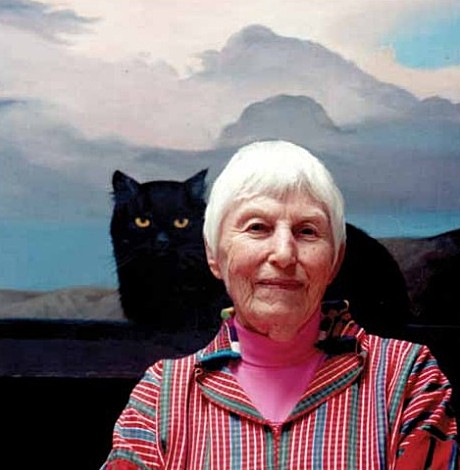
BACK COVER
“When no preconceived ideas keep us from looking and we take all the time we need to really “feel” what we see—when we are able to do that—that universe opens up and we catch our breath in awe at the incredible complexity of design in the humblest things. It is only when this happens that we regain our sense of wonder.”
Back cover quotation is from The Innocent Eye, the introduction to Notan. Back cover photograph by Hugo Steccati
Dorr Bothwell—1997 Photograph by Hugo Steccati
SOURCES
Digital copies of audio and video recordings of Dorr Bothwell are deposited in the Archives of American Art. The audio recordings contain the complete 1987-89 interviews plus other recorded matter. The video recordings are a 1986 class in Color and Design, an undated Notan class, her studio in 1988 (recorded by Richard Karch), and her 90th Birthday Party in 1992, all at the Mendocino Art Center.
All Bothwell graphics used with permission of the Dorr Bothwell Estate. Marlys Mayfield, trustee, 5601 Columbia Ave., Richmond CA 94304.
Bothwell, Dorr and Mayfield, Marlys. Notan: The Dark-Light Principle of Design. Dover Publications, 1991. Bothwell, Dorr. Dorr Bothwell’s African Sketchbook. Monica Hannasch, editor. Arti Grafiche Ambrosini – Roma, 2000.
Graphics on Page 89—Mendocino Robin, 7/62 Graphics on Page 96—Mendocino Robin, 1/63
Brief excerpts from the following interviews and articles were woven into the narrative of the text:
Unpublished letter from Dorr Bothwell to Sally Whitton, 1973
Art Center Treasures by Gerald Huckaby —Arts & Entertainment Magazine
Dorr Bothwell: Art Dynamo of Mendocino by Mervin Gilbert Arts & Entertainment Magazine
Artist Bothwell back for fourth decade of teaching by Kathleen Nevin Mendocino Beacon, Mendocino, California, 4/26/90
Printmaking History—The Forties—by Raymond L. Wilson —The California Printmaker, Issue No. 1, 1/92 Dorr Bothwell:
On the Cutting Edge at Ninety by Antonia Lamb —Arts & Entertainment Magazine, 4/92
Artist Dorr Bothwell by Nancy Barth —North Coast News, Fort Bragg, California, 7/30/92
Numerous California newspapers, published between 1927 and 2000, were reviewed for this project.
BOOK REFERENCES
Acton, David—A Spectrum of Innovation-Color in American Printmaking 1890-1960
Albright, Thomas—Art in the San Francisco Bay Area-19451980
Baro, Gene—30 Years of American Printmaking
Ehrlich, Susan (editor)—Pacific Dreams: Currents of Surrealism and Fantasy in California Art, 1934-1957 Landauer, Susan—San Francisco and the Second Wave
McChesney, Mary Fuller—A Period of Exploration San Francisco 1945-1950
Moure, Nancy Dustin Wall—California Art: 450 Years of Painting & Other Media
Trenton, Patricia (Editor)—Independent Spirits: Women Painters of the American West, 1890-1945
Watrous, James—A Century of American Printmaking-1880-1980
Smithsonian Archives of American Art: Collection Checklist
ART DEALERS
Tobey C. Moss Gallery—www.tobeycmossgallery.com
The Annex Galleries—www.annexgalleries.com
Zacha’s Bay Window Gallery—www.williamzacha.com
Mendocino Art Center Gallery—www.mendocinoartcenter.org
Adamson-Duvannes Galleries—www.justpaintings.net
Spencer Jon Helfen Fine Arts—www.helfenfinearts.com
Douglas Frazer Fine Art—www.frazerfineart.com
Calabi Gallery—calabigallery.com
Paramour Fine Arts—www.paramourfinearts.com
William P. Carl Fine Prints—www.williampcarlfineprints.com
BACK COVER: Photograph by Hugo Steccati. Quotation is from The Innocent Eye, the introduction to Notan: “When no preconceived ideas keep us from looking and we take all the time we need to really “feel” what we see—when we are able to do that—that universe opens up and we catch our breath in awe at the incredible complexity of design in the humblest things. It is only when this happens that we regain our sense of wonder.”
Dorr Bothwell: Straws in the Wind: An Artist’s Life as told to Bruce Levene. Editor, Bruce Levene, art direction for print edition by Marge Stewart. Thanks to Joan Curry, Jane Dymond, Kate Lee, Laurel Moss, Martha Wagner, Jackie Wollenberg, and Jennie Zacha for their past help and encouragement; to the Archives of American Art, Daniel Lienau of The Annex Galleries, Scott Shields of the Crocker Art Museum, Lory Ann Osterhuber of Pomegranate Communications, Stuart Tregoning, and Arlo Reeves for their recent help; to Mara Levene, Samuel Buffone and Michael McDonald of EyesPriedOpen.com for editorial advice; and to Michael Potts for motivating the completion of this work.
Special thanks to Gerald Buck and the Buck Collection, Carol Goodwin Blick, Tobey Moss, and Jason Schoen for their support, to Marge Smith, who transcribed the interviews, and to Marge Stewart of MargeStewart.com for her superlative skill in designing and producing the book.
To my daughters, Mara Levene and Sarah Levene Buffone, and to Gail Lauinger, who stoically observed the meanderings of this creative process.
– Bruce Levene
All works of visual art by Dorr Bothwell are © 2022 The Dorr Bothwell Trust, Mill Valley, California. For permission to reproduce images by Dorr Bothwell, contact
Marlys Mayfield, Trustee, the Dorr Bothwell Trust.